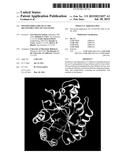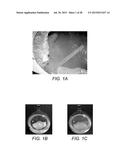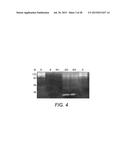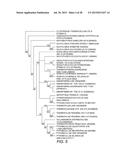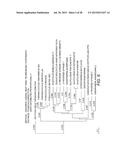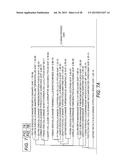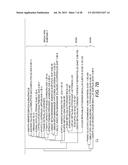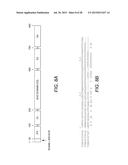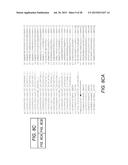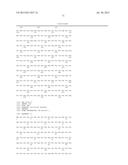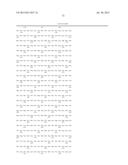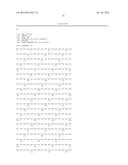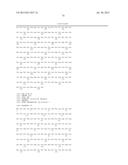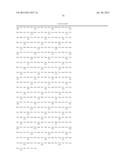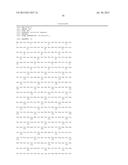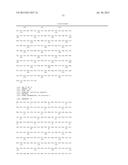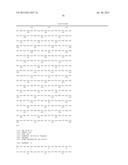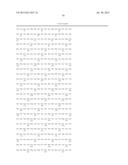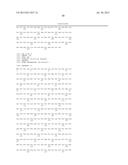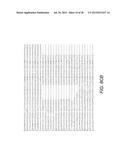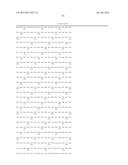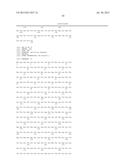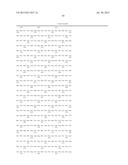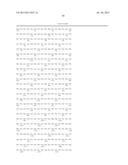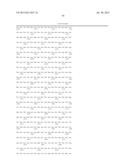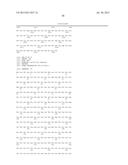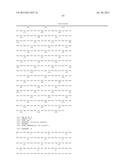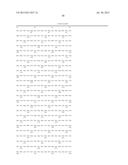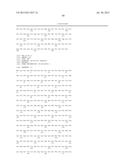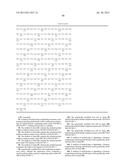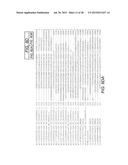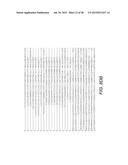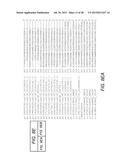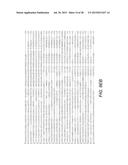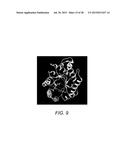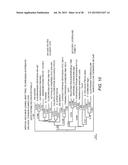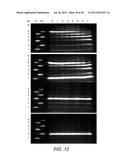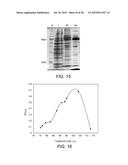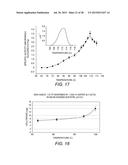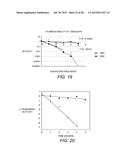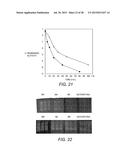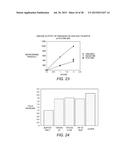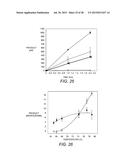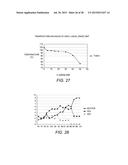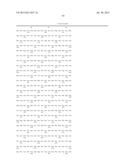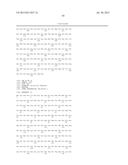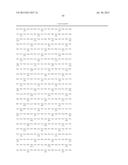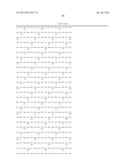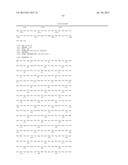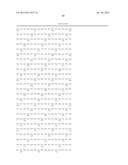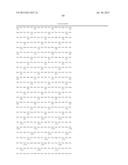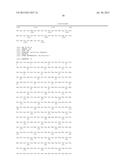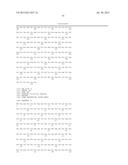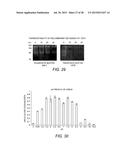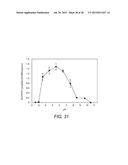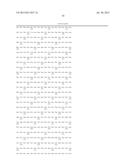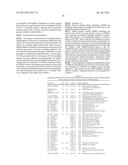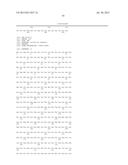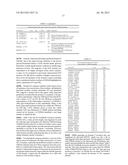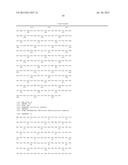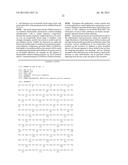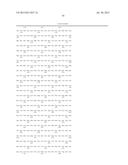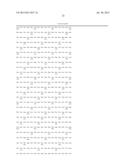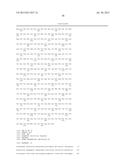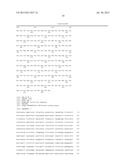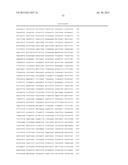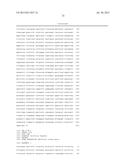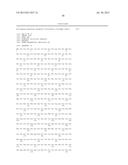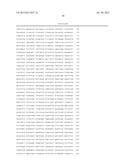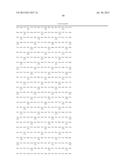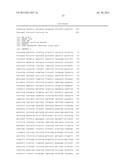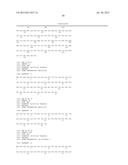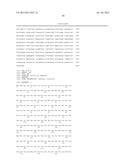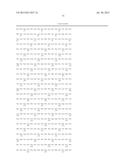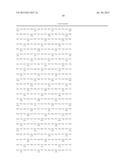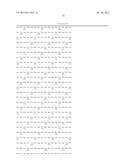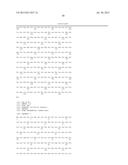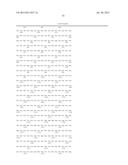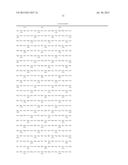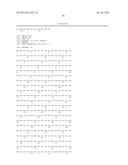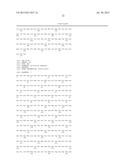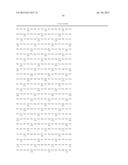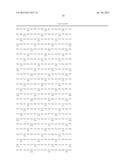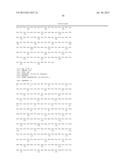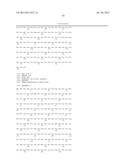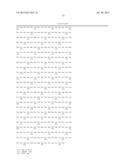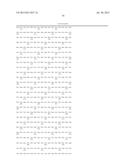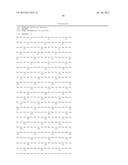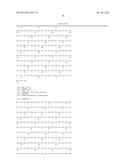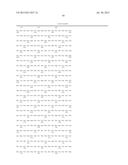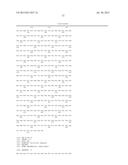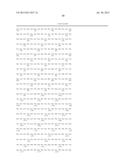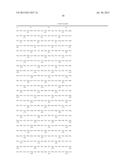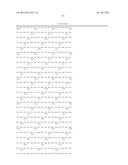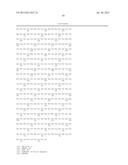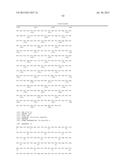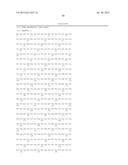Patent application title: POLYPEPTIDES FOR USE IN THE DECONSTRUCTION OF CELLULOSE
Inventors:
Joel Edward Graham (Baltimore, MD, US)
Melinda E. Clark (San Francisco, CA, US)
Frank Thomson Robb (Gaithersburg, MD, US)
Douglas S. Clark (Orinda, CA, US)
Harvey W. Blanch (San Francisco, CA, US)
Assignees:
University of Maryland, Baltimore
THE REGENTS OF THE UNIVERSITY OF CALIFORNIA
IPC8 Class: AC12P1914FI
USPC Class:
Class name:
Publication date: 2015-07-30
Patent application number: 20150211037
Abstract:
Hydrolysis and degradation of cellulose-containing biomass by use of a
polypeptide having cellulase activity is provided. Also provided are
polypeptides having cellulase activity, such as archaeal cellulases,
polynucleotides encoding the polypeptides, and compositions containing
the polypeptides, and methods of use thereof.Claims:
1-92. (canceled)
93. A method of hydrolyzing or degrading a biomass, comprising contacting said biomass with a composition comprising an isolated protein comprising amino acids 250-580 of SEQ ID NO: 1, wherein the protein is a cellulase.
94. The method of claim 93, wherein the isolated protein further comprises amino acids 130-250 of SEQ ID NO: 1.
95. The method of claim 94, wherein the isolated protein further comprises amino acids 750-842 of SEQ ID NO: 1.
96. The method of claim 95, wherein the isolated protein further comprises amino acids 580-750 of SEQ ID NO: 1.
97. The method of claim 93, wherein the isolated protein has at least 70% identity to SEQ ID NO: 1.
98. The method of claim 93, wherein the isolated protein comprises the amino acid sequence of SEQ ID NO: 1.
99. A genetically modified host cell comprising an expression vector, wherein the expression vector comprises a nucleic acid encoding a protein comprising amino acids 250-580 of SEQ ID NO: 1.
100. The genetically modified host cell of claim 99, wherein the protein further comprises amino acids 130-250 of SEQ ID NO: 1.
101. The genetically modified host cell of claim 100, wherein the protein further comprises amino acids 750-842 of SEQ ID NO: 1.
102. The genetically modified host cell of claim 101, wherein the protein further comprises amino acids 580-750 of SEQ ID NO: 1.
103. A method of hydrolyzing or degrading a biomass, comprising contacting said biomass with a genetically modified host cell of claim 99.
104. A method of hydrolyzing or degrading a biomass, comprising contacting said biomass with a genetically modified host cell of claim 100.
105. A method of hydrolyzing or degrading a biomass, comprising contacting said biomass with a genetically modified host cell of claim 101.
106. A method of hydrolyzing or degrading a biomass, comprising contacting said biomass with a genetically modified host cell of claim 102.
Description:
CROSS-REFERENCE TO RELATED APPLICATION
[0001] This application claims the benefit of U.S. Provisional Application No. 61/369,388, filed Jul. 30, 2010, which is hereby incorporated by reference, in its entirety.
SUBMISSION OF SEQUENCE LISTING AS ASCII TEXT FILE
[0002] The content of the following submission on ASCII text file is incorporated herein by reference in its entirety: a computer readable form (CRF) of the Sequence Listing (file name: 677792000940SEQLIST.txt, date recorded: Jun. 30, 2011, size: 206 KB).
FIELD
[0003] The present disclosure relates to hydrolysis of cellulose-containing polysaccharides and degradation of biomass using polypeptides having cellulase activity, including hyperthermophilic polypeptides. In particular the present disclosure relates to archaeal polynucleotides encoding the polypeptides, the polypeptides themselves, and compositions, methods and uses thereof.
BACKGROUND
[0004] Cellulose, the major component of plant biomass, is considered the most abundant biopolymer. Bayer, E. A., Chanzy, H., Lamed, R., Shoham, Y. (1998) Cellulose, cellulases and cellulosomes. Curr. Opin. Struct. Biol. 8, 548-557. Certain microorganisms are able to convert the monomer of cellulose, glucose, into various products useful in the production of biofuels and other methods. Cellulose is highly stable, has a high storage potential, low cost, and plentiful supply. Based on these and other properties, cellulose and enzymes capable of degrading and hydrolyzing it are useful in the sequestration, storage, and production of bioenergy. Lynd L R, Weimer P J, van Zyl W H, Pretorius I S (2002), "Microbial cellulose utilization: fundamentals and biotechnology," Microbiol Mol Biol Rev 66: 506-577.
[0005] Crystalline cellulose is composed of linear polymers of β1-4 linked glucose, held in a tightly crosslinked crystalline lattice by a high degree of intermolecular hydrogen bonding. This structure confers stability but also hinders efficient deconstruction of cellulose. Strategies for commercial depolymerization of cellulose typically combine pretreatment to disrupt the crystalline structure, followed by enzymatic hydrolysis. Hilden L, Johansson G (2004), "Recent developments on cellulases and carbohydrate-binding modules with cellulose affinity," Biotechnol Lett, 26: 1683-1693. Disruption of the crystalline structure and chemical hydrolysis typically requires high temperatures and low pH. See Kim J S, Lee Y Y, Torget, R W. (2001) "Cellulose hydrolysis under extremely low sulfuric acid and high-temperature conditions, Appl. Biochem. Biotechnol. 91-93 331-340. Enzymatic hydrolysis generally occurs under milder conditions. The degree of pretreatment required and the expense of subsequent cleanup steps are affected by properties of the enzymes used.
[0006] Bacteria capable of degrading cellulose include those belonging to the genera Aquifex, Rhodothermus, Thermobifida, Anaerocellum, and Caldicellulosiruptor. A recombinant thermostable endoglucanase of Aquifex aeolicus produced in E. coli showed maximal activity at 80° C. and pH 7.0 with a half-life of 2 h at 100° C. (Kim J S, Lee Y Y, Torget, R W (2001). Cellulose hydrolysis under extremely low sulfuric acid and high-temperature conditions. Appl. Biochem. Biotechnol. 91-93. 331-340)). The endoglucanases produced by Anaerocellum thermophilum and Caldicellulosiruptor saccharolyticus are multidomain enzymes composed of two catalytic domains, linked to carbohydrate binding domains by proline-threonine-rich regions (Zverlov V, Mahr S, Riedel K, Bronnenmeier K (1998a), "Properties and gene structure of a bifunctional cellulolytic enzyme (CelA) from the extreme thermophile `Anaerocellum thermophilum` with separate glycosyl hydrolase family 9 and 48 catalytic domains," Microbiology 144 (Pt 2): 457-465; Te'o V S, Saul D J, Bergquist P L (1995), "celA, another gene coding for a multidomain cellulase from the extreme thermophile Caldocellum saccharolyticum," Appl Microbiol Biotechnol 43: 291-296; Saul et al. 1990. The recombinant endoglucanase of Rhodothermus marinus has a pH optimum of 6.0-7.0 and a temperature optimum at 100° C. (Halldorsdottir S, Thorolfsdottir E T, Spilliaert R, Johansson M, Thorbjarnardottir S H, Palsdottir A, Hreggvidsson G O, Kristjansson J K, Holst O, Eggertsson G. (1998), "Cloning, sequencing and overexpression of a Rhodothermus marinus gene encoding a thermostable cellulase of glycosyl hydrolase family 12," Appl Microbiol Biotechnol 49: 277-284). The aerobic thermophilic bacterium Thermus caldophilus also produces an endoglucanase which exhibits high activity on CMC with cellobiose and cellotriose as products (Kim D, Park B H, Jung B-W, Kim M-K, Hong S I, Lee, D S (2006) Identification and molecular modeling of a family 5 endocellulase from Thermus caldophilus GK24, a cellulolytic strain of Thermus thermophilus. Int J Mol Sci 7: 571-589). In contrast, high-temperature, crystalline deconstructing cellulases from hyperthermophilic Archaea are few in number, despite efforts to identify such enzymes. Hyperthermophilic enzymes that act on cellulose typically lack identifiable cellulose binding domains.
[0007] Thus there is a need for improved cellulases, including cellulases encoded by hyperthermophilic archaea, and cellulases having high stability and tolerance to a range of chemical and physical parameters, including cellulases with activity at high temperatures and over a broad range of temperatures and pH, cellulases with higher catalytic activity and rate of conversion, activity in the presence of salts, ionic detergents, sulfhydryl reagents, and ionic liquids. Provided are polypeptides, compositions and methods that meet this need.
BRIEF SUMMARY
[0008] The present disclosure relates to isolated polypeptides (proteins), and in particular cellulases, including cellulases encoded by hyperthermophilic archaea, and cellulases having high stability and tolerance to a range of chemical and physical parameters, including cellulases with activity at high temperatures and over a broad range of temperatures and pH, cellulases with higher catalytic activity and rate of conversion, activity in the presence of salts, ionic detergents, sulfhydryl reagents, and ionic liquids. For example, provided are polypeptides, such as EBI244, having cellulase activity, e.g., endoglucanase, exoglucanase and/or β-Glucosidase or β-Glucosidaseglucohydrolase activity, such as cellulases produced by archaea. Certain aspects of the present disclosure relate to an isolated EBI244 protein having the amino acid sequence of SEQ ID NO: 1, and variants and fragments thereof. The present disclosure also relates to isolated polynucleotides encoding the polypeptides, as well as vectors and genetically modified host cells containing such isolated polynucleotides.
[0009] The present disclosure further relates to compositions comprising the isolated polypeptides or enriched in such polypeptides. Moreover the present disclosure relates to methods for the identification and production of the polypeptides, and methods for their use in the degradation and hydrolysis of poly- and oligo-saccharides, such as biomass, e.g., hemicellulose, for example, in the conversion of biomass, such as lignocellulocytic biomass, including pretreated lignocellulocytic biomass, into soluble sugars, including for use in the fermentive production of biofuels, polishing of cotton fabrics, production of laundry detergents, production of polished crystalline cellulose, assays of cellulases, expansins, and cellulose binding proteins, and in pulping cellulolytic materials.
[0010] In some embodiments, the provided polypeptides are isolated proteins that include a domain having an amino acid sequence at least at or about 30%, 40%, 50%, 60%, typically at least at or about 70%, 75%, 80%, 85%, 90%, 91%, 92%, 93%, 94%, 95%, 96%, 97%, 98%, or 99% identical or at or about 100% identical to a domain of SEQ ID NO: 1, such as to amino acids 250-580 of SEQ ID NO: 1, where the protein is a cellulase. In some embodiments, the protein includes or further includes a domain at least at or about 30%, 40%, 50%, 60%, typically at least at or about 70%, 75%, 80%, 85%, 90%, 91%, 92%, 93%, 94%, 95%, 96%, 97%, 98%, or 99% identical or at or about 100% identical to amino acids 130-250 of SEQ ID NO: 1. In some embodiments, the protein includes or further includes a domain at least at or about 30%, 40%, 50%, 60%, typically at least at or about 70%, 75%, 80%, 85%, 90%, 91%, 92%, 93%, 94%, 95%, 96%, 97%, 98%, or 99% identical or at or about 100% identical to amino acids 750-842 of SEQ ID NO: 1. In some embodiments, the protein includes or further includes a domain at least at or about 30%, 40%, 50%, 60%, typically at least at or about 70%, 75%, 80%, 85%, 90%, 91%, 92%, 93%, 94%, 95%, 96%, 97%, 98%, or 99% identical or at or about 100% identical to amino acids 580-750 of SEQ ID NO: 1.
[0011] In one aspect, the protein contains a domain having an amino acid sequence at least 70%, 75%, 80%, 85%, 90%, 91%, 92%, 93%, 94%, 95%, 96%, 97%, 98%, or 99% identical or 100% identical to amino acids 250 through 580 of SEQ ID NO: 1, amino acids 130-250 of SEQ ID NO: 1, amino acids 750-842 of SEQ ID NO: 1, or amino acids 580-750 of SEQ ID NO: 1, where the protein is a cellulase.
[0012] In one embodiment, the isolated protein has an amino acid sequence that is at least 70%, 75%, 80%, 85%, 90%, 91%, 92%, 93%, 94%, 95%, 96%, 97%, 98%, or 99% identical or 100% identical to SEQ ID NO: 1. In another embodiment, the protein is a mature cellulase protein, containing an amino acid sequence having at least 70%, 75%, 80%, 85%, 90%, 91%, 92%, 93%, 94%, 95%, 96%, 97%, 98%, or 99% identity or 100% identity to (i) amino acids 5-842 of SEQ ID NO: 1, (ii) amino acids 10-842 of SEQ ID NO: 1, (iii), amino acids 15-842 of SEQ ID NO: 1, (iv) amino acids 20-842 of SEQ ID NO: 1, (v) amino acids 24-482 of SEQ ID NO: 1; (vi) amino acids 25-482 of SEQ ID NO: 1; (vii) amino acids 30-842 of SEQ ID NO: 1; (viii) amino acids 35-842 of SEQ ID NO: 1; (ix) amino acids 40-842 of SEQ ID NO: 1; (x) amino acids 45-842 of SEQ ID NO: 1; (xi) amino acids 50-842 of SEQ ID NO: 1; or (xii) amino acids 130-842 of SEQ ID NO: 1. In one such aspect, the isolated mature cellulase protein includes an amino acid sequence having at least 70%, 75%, 80%, 85%, 90%, 91%, 92%, 93%, 94%, 95%, 96%, 97%, 98%, or 99% identity or 100% identity to amino acids 24-482 of SEQ ID NO: 1.
[0013] In one embodiment, the protein contains an amino acid sequence at least 30%, 40%, 50%, 60%, 70%, 75%, 80%, 85%, 90%, 91%, 92%, 93%, 94%, 95%, 96%, 97%, 98%, or 99% identical or 100% identical to SEQ ID NO: 1, such as a protein of SEQ ID NO: 1 or a protein variant thereof. In one aspect, the protein has identity at glutamates 413 and 506 of SEQ ID NO: 1. In another embodiment, the protein contains an amino acid sequence that is at least 70%, 75%, 80%, 85%, 90%, 91%, 92%, 93%, 94%, 95%, 96%, 97%, 98%, or 99% identical or 100% identical to SEQ ID NO: 5. In yet another embodiment, the protein contains an amino acid sequence that is at least 70%, 75%, 80%, 85%, 90%, 91%, 92%, 93%, 94%, 95%, 96%, 97%, 98%, or 99% identical or 100% identical to SEQ ID NO: 16.
[0014] In another embodiment, the protein contains an amino acid sequence encoded by a nucleic acid sequence with at least 30%, 40%, 50%, 60%, 70%, 75%, 80%, 85%, 90%, 91%, 92%, 93%, 94%, 95%, 96%, 97%, 98%, or 99% identity or 100% identity to SEQ ID NO: 2, SEQ ID NO: 3, SEQ ID NO: 4, or SEQ ID NO: 15.
[0015] In some embodiments, the protein is a protein of SEQ ID NO: 1, SEQ ID NO: 5, or SEQ ID NO: 16.
[0016] Other aspects of the present disclosure relate to an isolated protein having amino acids 250-580 of SEQ ID NO: 1, where the protein is a cellulase. Still other aspects of the present disclosure relate to an isolated protein having amino acids 130-250 of SEQ ID NO: 1, where the protein is a cellulase. Yet other aspects of the present disclosure relate to an isolated protein having amino acids 750-842 of SEQ ID NO: 1, where the protein is a cellulase. Further aspects of the present disclosure relate to an isolated protein having amino acids 580-750 of SEQ ID NO: 1, where the protein is a cellulase.
[0017] In some embodiments, the protein further includes a domain, such as a catalytic domain or cellulose binding domain of a bacterial or archaeal enzyme. In one aspect, such proteins are fusion proteins, containing one or more domains of SEQ ID NO: 1, 5, or SEQ ID NO: 6-13, such as a catalytic or cellulose binding domain, and one or more domains of another protein, such as another cellulase. In one embodiment, the domain, e.g., catalytic domain or cellulose binding domain, is from another organism, for example, B. fibrisolvens, S. solfataricus, A. cellulolyticus, P. furiosus, P. horikoshii, P. abyssi, A. cellulolyticus, S. lividans, B. fibrisolvens, or T. reesei, or other cellulase-encoding organism disclosed herein or well know in the art.
[0018] In some embodiments, the protein includes a modification, such as a tag, for example, an N-terminal or C-terminal histidine tag.
[0019] In some embodiments, the protein exhibits cellulase activity, for example, one or more of endoglucanase activity, exoglucanase activity, and β-Glucosidase activity. In some embodiments, the protein exhibits such activity over a range of physical and chemical conditions, such as at a high temperature or over a broad temperature range, such as at a temperature greater than 105° C., 95° C. to 110° C., or at a temperature exceeding 90, 91, 92, 93, 94, 95, 96, 07, 98, 99, or 100° C., or over a broad temperature range, such as between at or about 60° C. and 110° C. or between 65° C. and 110° C., such as between 90 and 110° C., between 65 and 70° C., between 85 and 105° C., or between 95 and 105° C.
[0020] In some embodiments, the activity has a half-life of at least one, two, three, four, or five hours at 100° C., or 105° C., for example, a half-life of at least five hours at 100° C., or a half-life of at least one hour at 105° C., at a pH of about 6.8. In some embodiments, the activity has a half-life of at least five, six, seven, eight, nine, 10, 11, 12, 13, 14, 15, 20, 25, 30, 35, 45, or 60 minutes at 108° C., for example, a half-life of at least 15 minutes at 108° C., or a at a pH of about 6.8. In some embodiments, the protein exhibits the activity at 90° C., in a solution containing up to 50% ionic liquid, 3.2 M KCl, or 4 M NaCl. In some embodiments, the cellulase activity is at least 50% maximum over a pH range of between about 4.5 and 8.75, or is at least 70% maximum at a pH of greater than about 7 or at a pH of about 8.5.
[0021] Also provided are compositions containing the isolated proteins, and nucleic acids encoding the proteins, such as polynucleotides encoding any of the proteins, for example, an isolated nucleic acid encoding a protein that comprises an amino acid sequence at least 30%, 40%, 50%, 60%, typically at least 70%, 75%, 80%, 85%, 90%, 91%, 92%, 93%, 94%, 95%, 96%, 97%, 98%, or 99% identical or 100% identical to SEQ ID NO: 1, SEQ ID NO: 5, or SEQ ID NO: 16, and isolated nucleic acids having a nucleotide sequence at least at least 30%, 40%, 50%, 60%, typically at least 70%, 75%, 80%, 85%, 90%, 91%, 92%, 93%, 94%, 95%, 96%, 97%, 98%, or 99% identical or 100% identical to SEQ ID NO: 2, SEQ ID NO: 3, SEQ ID NO: 4, or SEQ ID NO: 15.
[0022] Also provided are expression vectors containing the isolated nucleic acids, operably linked to a regulatory sequence, and host cells containing the expression vectors, and methods for producing a protein by culturing the host cell in a culture medium, under suitable conditions to produce a protein encoded by the expression vector. Also provided are compositions containing the host cells in culture medium, and compositions containing the provided proteins in the supernatant of culture medium.
[0023] In some embodiments, the composition contains a high salt or ionic solution, such as a solution including NaCl or KCl at a concentration of at least 1 M, 2M, 3M, or 4M. In some embodiments, the composition has a pH of at least at or about 5.5, 6.5, 7, 7.5, 8, or 8.5. In some embodiments, the composition includes an ionic liquid at a concentration of between at or about 20% and 50% or up to at or about 50%.
[0024] Also provided are methods of reducing the viscosity of a pretreated biomass mixture, by contacting a pretreated biomass mixture having an initial viscosity with the provided compositions and/or proteins, and incubating the contacted biomass mixture under conditions sufficient to reduce the initial viscosity of said pretreated biomass mixture.
[0025] Also provided are methods for converting a biomass to sugars, hydrolyzing or degrading a biomass, by contacting the biomass with the provided compositions and/or proteins. Also provided are methods for producing a fermentation product by contacting biomass with the compositions or proteins to form a first product, and then culturing the first product with one or more fermentive microorganisms under conditions sufficient to produce a fermentation product, or incubating the first product with a chemical solution, under conditions sufficient to produce a fermentation product by a chemical process. Also provided are methods for producing a fermentation product, by hydrolyzing or degrading biomass with the provided compositions and proteins to form a first product and then culturing the first product with one or more fermentive microorganisms under conditions sufficient to produce a fermentation product, or incubating the first product with a chemical solution, under conditions sufficient to produce a fermentation product by a chemical process. In some aspects, the fermentation product is a biofuel.
[0026] Also provided are methods for fermenting biomass by fermenting the biomass with one or more fermenting microorganisms, wherein the biomass is or has been treated by a provided composition or protein.
[0027] Also provided are methods for producing a fuel by contacting a biomass with the composition or protein to yield a sugar solution and culturing the sugar solution with a fermentative microorganism under conditions sufficient to produce a fuel or under conditions sufficient to produce a fermentation product by a chemical process.
[0028] Also provided are methods for food production, by contacting a plant material with the provided composition or protein, yield a treated plant material, and methods for textile cleaning by contacting a soiled textile with the composition or protein, to yield a clean textile. Also provided are methods for paper pulp bleaching by contacting paper pulp with the composition or protein to yield bleached paper pulp.
[0029] Also provided are laundry detergent compositions, containing the provided proteins and detergent, and methods for use of such compositions in cleaning, anti-deposition, or color care, by contacting the laundry detergent composition with a textile.
[0030] In some aspects, the methods, e.g., the contacting, are conducted at a pH between 4.5 and 8.5, such as a pH of at least 5.5 or at least 6.5, for example, at least 7, at least 7.5, at least 8, at least 8.5. In some aspects, the methods or contacting are performed at a temperature between 90 and 110° C., between 60 and 70° C., between 95 and 105° C., or at least 100° C. In some aspects, the method or contacting is performed in a solution containing KCl or NaCl, for example, at a concentration of at least 1 M, 2 M, 3 M, or 4 M, or at a saturating condition. In one aspect, the method or contacting is performed in a solution containing at least 10%, at least 20%, at least 30% or at least 40% ionic liquid.
[0031] In some aspects, the biomass is a lignocellulose. In some embodiments, the biomass is pretreated prior to contacting.
BRIEF DESCRIPTION OF THE DRAWINGS
[0032] FIG. 1A shows the source of lignocellulose-degrading consortium of hyperthermophilic Archea enrichment, and degradation of filter paper. A circumneutral geothermal pool at 94° C., with a level-maintaining syphon. Sediment from the floor of this site was enriched on pulverized Miscanthus at 90° C. and subsequently transferred to filter paper enriched media. FIG. 1B depicts the degradation of filter paper by the enrichment culture in a spherical 2 L culture flask. Circular discs of Whatman® #3 filter paper were shredded and partially dissolved after incubation for 30 days at 90° C. FIG. 1C depicts control Whatman® #3 filter paper discs. Incubation as in panel B.
[0033] FIG. 2 depicts results of additional experiments showing filter degradation by the enrichment. FIG. 2A shows Whatman® #1 filter paper in media without (C) and with (E) inoculation with the enrichment at 90° C. Lettering was applied with a number 2 graphite pencil. FIG. 2B shows Whatman® #3 filter paper strip (2 mm×40 mm) in growth media supported by a glass tube, without (C) and with (E) inoculation with the enrichment at 90° C. The inoculated sampled showed complete dissolution of the filter paper strip.
[0034] FIG. 3 shows endoglucanase activity of protein in the three-organism hyperthermophilic Archaea consortium enriched on Avicel® as described in Example 1A, measured by zymograms on SDS-PAGE fractions from detergent wash of Avicel® from the enrichment culture. The lanes are labeled as follows: 1 (Marker), (2) 1% SDS wash (experiment 1); (3) whole cell extract; (4) Avicel®; (5) CHAPS fraction; (6) Pellet after CHAPS wash, (7) 1% SDS wash (experiment 2).
[0035] FIG. 4 shows protein extraction and detection of CMCase activity. Protein extraction and detection of CMCase activity from proteins eluted from Avicel® particles after deconstruction by enrichment at 90° C. for 8 days. Image shows SDSPAGE gradient zymogram, 10%-15% acrylimide, with 0.2% CMC embedded in gel. Lanes: M-marker, N-native whole SDS extract, B-buffer only soluble extract, W1-0.6% CHAPS extract, W2-1% CHAPS 5% Cellobiose extract #1 (1 hr incubation at 90° C.), W-3 1% CHAPS 5% Cellobiose extract #2 (1 hr incubation at 90° C.), S-1% SDS extract final wash (15 minute incubation 100° C.). For lanes B through S, the Avicel® pellet was sonicated continuously for 2 minutes in the wash solution.
[0036] FIG. 5 depicts a maximum likelihood phylogenetic tree. Maximum likelihood 16S rRNA phylogenetic tree, showing the relationship of full-length 16S rRNAs from the three component organisms of the assembled metagenome. Branches in bold and labeled with larger type represent the three sequences from the metagenome.
[0037] FIG. 6 displays a phylogentic tree, showing relationship of three reverse gyrases, from the metagenome described in Example 1A, to other archaeal reverse gyases. Reverse gyrase 1 and 2, found on high-read density contigs, appear closely allied with the two reverse gyrases encoded by Ignisphaera aggregans. The reverse gyrase of the bacterium Dictyoglomus turgidum was set as the root.
[0038] FIG. 7 depicts the phylogeny of the EBI244 protein putative catalytic domain. A phylogenetic tree was produced showing the relationship of EBI244's catalytic domain to the closest characterized GH families. Tree entry information: Uniprot identifier; enzyme function (if known); organism name; Pfam hit GH family (asterisk indicated characterized enzyme in CAZY database); and E-value (no GH listed indicates no Pfam hits).
[0039] FIG. 8A displays schematically the predicted domain architecture of EBI244 protein sequence, with approximate amino acid positions of domain boundaries labeled. FIG. 8B displays similar N-terminal protein regions among genes identified in the hyperthermophilic Archaea consortium metagenome in which EBI244 was discovered, as described in Example 1. The top sequence is EBI244. FIG. 8C shows a multiple sequence alignment of a non-redundant sample of the thirty-eight sequences identified using Hidden Markov Model (HMM) searching and analysis based on domain 1 of EBI244, as described in Example 1. FIG. 8D shows a multiple sequence alignment of EBI244 domain 2 with sequences identified in the domain 1 HMM search/analysis (see FIG. 8C). Catalytic residues of EBI244 predicted from Pfam analysis (glutamates 413 and 506) both glutamates) are highlighted in yellow. FIG. 8E shows a Multiple sequence alignment of all hits to domain 4 HMM searching. Domain 4 search area is highlighted in orange. All sequences were globally aligned using the MUSCLE program.
[0040] FIG. 9 shows a homology structural model of EBI244 domain 2, constructed by the I-TASSER server, built from multiple GH5 domain structures in the PDB database, showing the common TIM-barrel architecture with 8 beta sheets inside 8 alpha-helices.
[0041] FIG. 10 shows schematically a relationship of the glycolytic domain of EBI244 to known glycosyl hydrolase family 5 proteins.
[0042] FIG. 11 shows zymogram activity of recombinant protein fractions, compared to native protein fraction. M=prestained molecular weight standard; P=B121 (pet16b::5326244 (His-tagged EBI244 protein)), pellet fraction; S=B121 (pet16b::5326244 (His-tagged EBI244 protein)), boiled fraction; N=native protein from J1 enrichment eluted from Avicel® with 2% SDS. Cleared areas (white) represent activity, while dark areas represent intact carboxymethylcellulose. Recombinant protein fractions (P and S) were insoluble or soluble portions of the E. coli extract. Native fraction was eluted from Avicel® with boiling SDS. The lower band represents an internal control, E. coli endoglucanase.
[0043] FIG. 12 shows the Fluorophore Assisted Carbohydrate Electropheresis (FACE) results of time course of EBI244 on cellohexaose. Reaction condition was 10 μg enzyme, 0.33 mM cellohexaose in 25 mM HEPPS ph 6.8, 95° C. in 100 μL volume. The experiment tracked degree of polymerization (dp) over time. FIG. 12A depicts cellohexaose (0.33 mM) substrate. FIG. 12B depicts cellopentaose (0.4 mM) and glucose (0.4 mM) substrates. FIG. 12C depicts cellotriose (0.67 mM) substrates. FIG. 12D depicts cellobiose (1 mM) substrate. Standards were a mixture of glucose, cellotriose and cellopentaose (m1) and mixture of cellobiose, cellotetraose and cellopentaose (m2). Time points (minutes, label) were (0,0), (1:20,1), (2:40, 2), (6:20, 3), (12:40, 4), (25:20, 5), (50:40, 6), (120:00, 7). Oligomers higher than cellohexaose up to dp˜11 were rapidly formed then degraded over time.
[0044] FIG. 13 shows results of a zymogram assay, showing EBI244 activity distributed among 20-40% saturating ammonium sulfate fractions. Each fraction is represented by three lanes: undiluted (1.0), dilution 2 in 5 (0.4), and dilution 1 in 5 (0.2). Initial sample was soluble recombinant protein after pretreatment at 80 C for 30 minutes. Protein was precipitated using 20, 40, 60, and 90% saturating ammonium sulfate.
[0045] FIG. 14 shows a graph of endoglucanase activity, measured by DNS assay, with 1% low-viscosity carboxymethylcellulose as the substrate. Fractions 1-11 represent a linear gradient from 1 M to 0 M ammonium sulfate in potassium phosphate buffer, pH 7.0.
[0046] FIG. 15 shows a picture of a comassie-stained SDS-PAGE gel, demonstrating stepwise purification of EBI244 to ˜60% purity. M=marker; L=whole cell lysate; AS=20-40% ammonium sulfate fraction; HIC=pooled active fraction, purified using Macro-Prep t-butyl hydrophobic interaction chromatography (HIC) support (methacrylate-based, 50 μm beads) (butyl HIC). The sample was heated to 80° C. prior to ammonium sulfate fractionation.
[0047] FIG. 16 shows an activity-temperature profile of EBI244 on 1% CMC (carboxymethyl cellulose) (DNS assay).
[0048] FIG. 17 shows the temperature profile of EBI244. The temperature vs. activity profile was measured by 20-min assay in 1% CMC in 25 mM sodium acetate buffer, pH 6.0. The products were detected by DNS reducing sugar assay and normalized to a cellobiose standard. Error for this experiment was below 15%. Inset: Differential scanning calorimetry results of enzyme from 102-116° C. A dual Tm was observed at 111.5° C. and 113° C.
[0049] FIG. 18 shows results of a DNS assay using Whatman® #1 filter paper in 10 mM Sodium Acetate pH 5.0 curve, demonstrating enzyme activity on filter paper over a range of temperatures.
[0050] FIG. 19 shows thermostability of EBI244 activity, preincubated at 100° C. or 105° C. in buffer, then assayed for activity on 1% CMC at 95° C.
[0051] FIG. 20 shows the thermostability of EBI244 at 100° C. ( ) and 105° C. (∘) in 50 mM HEPPS buffer, pH 6.8. Data points represent the mean of four assays. Enzyme was incubated at the appropriate temperature, samples were collected at 1 hour intervals, and activity was measured using the DNS assay with cellobiose as a standard.
[0052] FIG. 21 shows thermostability of EBI244 at 108° C. with (∘) and without ( ) 0.5% w/v Avicel® in 25 mM sodium acetate buffer, pH 6.0. Enzyme was pretreated for 30 min at 90° C. prior to incubation at 108° C. to allow for interaction with the cellulose. Samples were removed at time intervals and activity was measured in triplicate using the DNS assay using cellobiose as a standard.
[0053] FIG. 22 shows zymogram assay results following incubation of recombinant EBI244 enzyme at 90° C. in phosphate buffer, at various salt concentrations. Upper panel: NaCl; lower panel: KCl.
[0054] FIG. 23 shows DNS assay results showing product formation for EBI244 with 1% CMC in HEPPS buffer with no added salt, 2.5 M NaCl, or 3.0 M KCl.
[0055] FIG. 24 depicts activity of EBI244 against PNP-cellobioside at 95° C. in the presence of various detergents. Conditions tested were 25 mM potassium phosphate buffer, pH 6.8 alone or buffer plus 0.1% of either Tween® 20, Triton® x-100, NP-40 substitute or CHAPS. After a 20 min incubation, sodium hydroxide was added to 50 mM and absorbance was measured at 410 nm. Values were calculated via paranitrophenol standard in the same buffer. Ratios were calculated based on activity in buffer alone.
[0056] FIG. 25 depicts a time course of EBI244 activity against 1% CMC while in the presence of salts or ionic liquids. All assays were done in HEPPS buffer, pH 6.8 at 90° C. (shown with ) and either 2.5 M sodium chloride (.tangle-solidup.), 3.0 M potassium chloride (.box-solid.), 25% (v/v) [DMM]DMP (∘), or 25% (v/v) [EMM]Acetate (Δ). Activity was measured using DNS assay after each time point using cellobiose as a standard. Error bars represent the standard error of the mean of four assays.
[0057] FIG. 26 depicts a temperature profiles showing CMC activity of EBI244 in 50% ionic liquid. Enzyme activity was measured in 50% (v/v) [DMIM]DMP in 25 mM phosphate, pH 6.8 ( ) and 25 mM potassium phosphate buffer, pH 6.8 alone (∘). Activity was measured using DNS assay after 2 hours using cellobiose as a standard.
[0058] FIG. 27 shows results of a DNS assay, representing temperature optima compiled from activity-temperature profiles of EBI244 in increasing amounts of the ionic liquid [DMIM]DMP.
[0059] FIG. 28 shows results of a DNS assay, showing activity of EBI244 on 1% CMC in buffer alone, and in the presence of 40% and 50% [DMIM]DMP.
[0060] FIG. 29 shows the results of a zymogram assay of EBI244, after pretreatment in phosphate buffer or phosphate buffer plus 0.1% sodium dodecyl sulfate at 100 C, demonstrating the thermostability of recombinant EBI244.
[0061] FIG. 30 shows a pH-profile of EBI244 activity, based on DNS assays of CMC hydrolysis.
[0062] FIG. 31 shows a pH profile of EBI244 activity measured against PNP-cellobioside at 95° C. Buffers used were sodium acetate/acetic acid (pH 2.5-5.5), MED (pH 6.5), HEPPS (pH 7.5-8.5), and CAPS (pH 9.5-10.5). After 20 min incubation, sodium hydroxide to a final concentration of 50 mM and absorbance was measured at 410 nm. Values were calculated by a paranitrophenol standard in the same buffer. Error bars are standard deviations of the mean of four duplicate addays.
DEFINITIONS
[0063] The term "catalytic activity" or "activity" describes quantitatively the conversion of a given substrate under defined reaction conditions. The term "residual activity" is defined as the ratio of the catalytic activity of the enzyme under a certain set of conditions to the catalytic activity under a different set of conditions. The term "specific activity" describes quantitatively the catalytic activity per amount of enzyme under defined reaction conditions.
[0064] The term "thermostability" describes the property of a protein to withstand a limited exposure to certain temperatures, such as high temperatures, without losing the activity it possesses at temperatures where its activity is measurable or is optimal. The term "thermoactive" describes a property of a protein which retains activity at high temperatures.
[0065] The term "pH-stability" describes the property of a protein to withstand a limited exposure to pH-values significantly deviating from the pH where its stability is optimal (e.g., more than one pH-unit above or below the pH-optimum, without losing its activity under conditions where its activity is measurable). The term "pH active" describes a property of a protein which retains activity at a pH value deviating significantly from pH values typically optimal for such activities.
[0066] The term "cellulase" refers to an enzyme (or enzymatic activity thereof) that catalyzes an enzymatic reaction in which cellulose is hydrolyzed into glucose, cellobiose, or cellooligotose, including enzymes having endoglucanase, exoglucanase, e.g., glucanohydrolase or cellobiohydrolase, β-Glucosidase or β-Glucosidaseglucohydrolase activity, and the corresponding enzymatic activity of such enzymes.
[0067] The term "lignocellulose" refers to any material primarily consisting of cellulose, hemicellulose, and lignin.
[0068] The term "hemicellulose" refers to a polymer of short, highly-branched chains of mostly five-carbon pentose sugars (e.g., xylose and arabinose) and to a lesser extent six-carbon hexose sugars (e.g., galactose, glucose and mannose).
[0069] The term "renewable resources" refers to biomass substrates that are grown and harvested, like crops, straw, wood and wood products. The term "biological fuels" refers to solid, liquid, or gas fuel including or derived from biomass, such as biodiesel, biogas, vegetable oil, bioethanol, and biohydrogen.
[0070] As used herein, when it is generally stated that a polypeptide or nucleic acid molecule or region thereof contains or has "identity" or "homology," per se (without specifying a particular percent identity), to another polypeptide or nucleic acid molecule or region thereof, the two molecules and/or regions share at least at or about 40%, and typically at least at or about 50%, 60% or 70% sequence identity, such as at least at or about 60%, 65%, 70%, 75%, 80%, 85%, 90%, 95%, 96%, 97%, 98%, 99% or 100% sequence identity. The precise percentage of identity can be specified.
[0071] Sequence "identity" has an art-recognized meaning. The percentage of sequence identity between two nucleic acid or polypeptide molecules and/or regions can be calculated using well-known and published techniques, such as those described below. In general, for determination of the percentage sequence identity, sequences are aligned so that the highest order match is obtained (see, e.g.: Computational Molecular Biology, Lesk, A. M., ed., Oxford University Press, New York, 1988; Biocomputing: Informatics and Genome Projects, Smith, D. W., ed., Academic Press, New York, 1993; Computer Analysis of Sequence Data, Part I, Griffin, A. M., and Griffin, H. G., eds., Humana Press, New Jersey, 1994; Sequence Analysis in Molecular Biology, von Heinje, G., Academic Press, 1987; and Sequence Analysis Primer, Gribskov, M. and Devereux, J., eds., M Stockton Press, New York, 1991; Carrillo et al. (1988) SIAM J Applied Math 48:1073). For sequence identity, the number of conserved amino acids or nucleotides is determined by standard alignment algorithms programs, and can be used with default gap penalties established by each supplier. Substantially homologous nucleic acid molecules specifically hybridize typically at moderate stringency or at high stringency all along the length of the nucleic acid of interest.
[0072] The term "identity," when associated with a particular number, represents a comparison between the sequences of a first and a second polypeptide or polynucleotide or regions thereof. As used herein, the term at least "90% identical to" refers to percent identities from 90 to 99.99 of one nucleotide or amino acid sequence to the other. Identity of 90% or more is indicative of the fact that, assuming for exemplification purposes, the full length of a first and second polypeptide, each 100 amino acids in length, are compared, no more than 10% (i.e., 10 out of 100) of the amino acids in the first polypeptide differs from that of the second polypeptide. Similar comparisons can be made between first and second polynucleotides. Such differences among the first and second sequences can be represented as point mutations randomly distributed over the entire length of a polypeptide or they can be clustered in one or more locations of varying length up to the maximum allowable, e.g. 10/100 amino acid difference (approximately 90% identity). Differences are defined as nucleotide or amino acid residue substitutions, insertions, additions or deletions. At the level of homologies or identities above about 85-90%, the result should be independent of the program and gap parameters set; such high levels of identity can be assessed readily, often by manual alignment without relying on software.
[0073] Sequence identity can be measured along the full length of a polynucleotide or polypeptide or along a region thereof. Sequence identity compared along the full length of two polynucleotides or polypeptides refers to the percentage of identical nucleotide or amino acid residues along the full-length of the molecule. Alternatively, sequence identity can be compared along the length of a molecule, compared to a region of another molecule.
DETAILED DESCRIPTION
[0074] Crystalline cellulose is composed of linear polymers of β1-4 linked glucose, held in the crystalline lattice by a high degree of intermolecular hydrogen bonding. The tightly crosslinked structure is primarily responsible for the inherent stability of cellulose, but also can hinder efficient deconstruction. The conversion of cellulose to glucose is generally accomplished by chemical hydrolysis (typically using a single step of acid treatment) or enzymatic hydrolysis (generally involving acid pretreatment followed by hydrolysis with cellulase enzymes). High temperatures combined with low pH are generally required for the disruption of the crystalline structure and chemical hydrolysis. See Kim J S, Lee Y Y, Torget, R W. (2001) "Cellulose hydrolysis under extremely low sulfuric acid and high-temperature conditions, Appl. Biochem. Biotechnol. 91-93. 331-340. Enzymatic hydrolysis generally occurs under milder conditions. Strategies for commercial depolymerization of cellulose typically combine pretreatment and enzymatic hydrolysis. Hilden L, Johansson G (2004), "Recent developments on cellulases and carbohydrate-binding modules with cellulose affinity," Biotechnol Lett, 26: 1683-1693. The degree of pretreatment required and the expense of subsequent cleanup steps required depend upon the properties of the enzymes that will be used.
EMBODIMENTS
[0075] The present disclosure relates to isolated polypeptides, including cellulases and other polypeptides, for example, cellulases having endoglucanase, exoglucanase and/or β-Glucosidase or β-Glucosidaseglucohydrolase activity, activity, including those produced by archaea, such as an EBI244 polypeptide (SEQ ID NO: 1) and variants and fragments thereof. The present disclosure also relates to isolated polynucleotides encoding the polypeptides, as well as vectors and genetically modified host cells containing such isolated polynucleotides. The present disclosure further relates to compositions comprising the isolated polypeptides or enriched in such polypeptides. Moreover the present disclosure relates to methods for the identification and production of the polypeptides, and methods for their use in the degradation and hydrolysis of poly- and oligo-saccharides, such as biomass, e.g., hemicellulose, for example, in the conversion of biomass, such as lignocellulocytic biomass, including pretreated lignocellulocytic biomass, into soluble sugars, including for use in the fermentive production of biofuels, polishing of cotton fabrics, production of laundry detergents, production of polished crystalline cellulose, assays of cellulases, expansins, and cellulose binding proteins, and in pulping cellulolytic materials. Also provided herein are hyperthermophilic organisms and polypeptides encoded by the organisms, capable of utilizing crystalline cellulose, and methods for their identification and production.
[0076] Polypeptides
[0077] The present disclosure relates to isolated polypeptides having cellulase activity and fragments thereof. In particular, the present disclosure provides polypeptides of SEQ ID NO: 1, SEQ ID NO: 5, SEQ ID NO: 16, and fragments and variants thereof. In some embodiments, the polypeptide includes a sequence having at least 50%, 60%, typically at least 70%, 75%, 80%, 85%, 90%, 91%, 92%, 93%, 94%, 95%, 96%, 97%, 98%, 99% or 100% sequence identity to SEQ ID NO: 1, or to one or more regions or domains thereof, including amino acid residues 1-25 of SEQ ID NO: 1, amino acid residues 30-130 of SEQ ID NO: 1, amino acid residues 250 through 580 of SEQ ID NO: 1 (Domain 2), amino acids 130-250 of SEQ ID NO: 1 (domain 1), amino acids 750-842 of SEQ ID NO: 1 (Domain 4), or amino acids 580-750 proline-threonine rich region, Domain 1, Domain 2, Domain 3, or Domain 4 of SEQ ID NO: 1, where the polypeptide is a cellulase.
[0078] In some embodiments, the polypeptide is a variant or fragment of SEQ ID NO: 1, SEQ ID NO: 5, or SEQ ID NO: 16, with one or more amino acid deletions, insertions, modifications, or substitutions, such as a polypeptide having at least 30%, 40%, 50%, 60%, typically at least 70%, 75%, 80%, 85%, 90%, 91%, 92%, 93%, 94%, 95%, 96%, 97%, 98%, 99% or 100% sequence identity to SEQ ID NO: 1, SEQ ID NO: 5, or SEQ ID NO: 16, or containing a domain, such as a catalytic domain or carbohydrate binding motif (CBM) that is at least 30%, 40%, 50%, 60%, typically at least 30%, 40%, 50%, 60%, 70%, 75%, 80%, 85%, 90%, 91%, 92%, 93%, 94%, 95%, 96%, 97%, 98%, 99% or 100% identical to a domain thereof. Typically, the variant or fragment retains a substantial amount of the cellulase or other enzymatic activity or cellulose binding capability of the wild-type protein. For example, in some embodiments, the variant or fragment retains one, typically both, of the wild type active site residues at E413 and E506. In some embodiments, the variants include a protein comprising the sequence of a protein listed in any of Tables 1, 2, 3, and 4, such as a polypeptide having a sequence at least 30%, 40%, 50%, 60%, typically at least 70%, 75%, 80%, 85%, 90%, 91%, 92%, 93%, 94%, 95%, 96%, 97%, 98%, 99% or 100% identical to SEQ ID NO: 6, 7, 8, 9, 10, 11, 12, or 13.
[0079] Whether any two nucleic acid or polypeptide molecules have sequences that contain, or contain at least, a certain percent (e.g. 60%, 70%, 80%, 85%, 90%, 95%, 96%, 97%, 98% or 99%) sequence identity can be determined using known computer algorithms such as the "FASTA" program, using for example, the default parameters as in Pearson et al. (1988) Proc. Natl. Acad. Sci. USA 85:2444 (other programs include the GCG program package (Devereux, J., et al., Nucleic Acids Research 12(I):387 (1984)), BLASTP, BLASTN, FASTA (Altschul, S. F., et al., J Molec Biol 215:403 (1990); Guide to Huge Computers, Martin J. Bishop, ed., Academic Press, San Diego, 1994, and Carrillo et al. (1988) SIAM J Applied Math 48:1073). For example, the BLAST function of the National Center for Biotechnology Information database can be used to determine identity. Other commercially or publicly available programs include, DNAStar "MegAlign" program (Madison, Wis.) and the University of Wisconsin Genetics Computer Group (UWG) "Gap" program (Madison Wis.)). The extent of sequence identity (homology) and complementarity may be determined using any computer program and associated parameters, including those described herein, such as BLAST 2.2.2. or FASTA version 3.0t78, with the default parameters. It is understood that for the purposes of determining sequence identity among DNA and RNA sequences thymidine nucleotide is equivalent to (represents identity with) a uracil nucleotide. Percent identity further can be determined, for example, by comparing sequence information using a GAP computer program (e.g., Needleman et al. (1970) J. Mol. Biol. 48:443, as revised by Smith and Waterman ((1981) Adv. Appl. Math. 2:482). Briefly, the GAP program defines similarity as the number of aligned symbols (i.e., nucleotides or amino acids), which are similar, divided by the total number of symbols in the shorter of the two sequences. Default parameters for the GAP program can include: (1) a unary comparison matrix (containing a value of 1 for identities and 0 for non-identities) and the weighted comparison matrix of Gribskov et al. (1986) Nucl. Acids Res. 14:6745, as described by Schwartz and Dayhoff, eds., ATLAS OF PROTEIN SEQUENCE AND STRUCTURE, National Biomedical Research Foundation, pp. 353-358 (1979); (2) a penalty of 3.0 for each gap and an additional 0.10 penalty for each symbol in each gap; and (3) no penalty for end gaps. Various programs and methods for assessing identity are known to those of skill in the art. High levels of identity, such as 90% or 95% identity, readily can be determined without software.
[0080] In some embodiments, the polypeptides are produced recombinantly, while in others the polypeptides are produced synthetically, or are purified from a native source, such as an archaea, such as one described herein.
[0081] The provided polypeptides generally have cellulase activity, for example, endoglucanase, exoglucanase, e.g., glucanohydrolase or cellobiohydrolase, β-Glucosidase or β-Glucosidaseglucohydrolase activity, and/or cellulose binding ability. In one aspect, the provided polypeptides exhibit the cellulase activity or binding ability, for example, an activity or binding ability of at least 40%, 50%, 60%, 70%, 75%, or more of maximum (or with a half-life of activity or binding ability of at least 10 minutes, 15 minutes, 20 minutes, 25 minutes, 30 minutes, 35 minutes, 40 minutes, 45 minutes, 50 minutes, 55 minutes, 1 hour, 1.25 hours, 1.5 hours, 1.75 hours, 2 hours, 3 hours, 4 hours, 5 hours, or more hours) over a broad range of conditions, for example, over range of conditions that is broader than that observed for one or more known cellulases, such as bacterial cellulases, including those produced by Anaerocellum thermophilum, Caldicellulosiruptor saccharolyticus, Rhodothermus marinus, or Thermus caldophilus. For example, in some aspects, the polypeptides exhibit activity or binding ability in the presence of high salt solution, such as in the presence of a saturating concentration of salt, such as in a solution containing sodium chloride (NaCl) at a concentration of at least at or about 0.5 M, 1 M, 1.5 M, 2 M, 2.5 M, 3 M, 3.5 M, or 4 M sodium chloride, or potassium chloride (KCl), at a concentration at or about 0.5 M, 1 M, 1.5 M, 2 M, 2.5 M 3.0 M or 3.2 M KCl and/or ionic liquids, such as 1,3-dimethylimidazolium dimethyl phosphate ([DMIM]DMP) or [EMIM]OAc, or in the presence of one or more detergents, such as ionic detergents (e.g., SDS, CHAPS), sulfhydryl reagents, such as in saturating ammonium sulfate or ammonium sulfate between at or about 0 and 1 M.
[0082] In some aspects, the polypeptides exhibit the activity or binding ability at high temperatures, such as a temperature exceeding 90° C., 91° C., 92° C., 93° C., 94° C., 95° C., 96° C., 97° C., 98° C., 99° C., 100° C., 101° C., 102° C., 103° C., 104° C., 105° C., 106° C., 107° C., 108° C., 109° C., or 110° C., or over a broad temperature range, such as between at or about 60° C. and 110° C. or between 65° C. and 110° C., such as between 90° C. and 110° C., between 6° C. 5 and 70° C., between 85° C. and 105° C., between 85° C. and 110° C., between 95° C. and 105° C., or between 95° C. and 110° C. In some aspects, the polypeptides exhibit the activity or binding ability over a broad pH range, for example, at a pH of between about 4.5 and 8.75, at a pH of greater than 7 or at a pH of 8.5, or at a pH of at least 5.0, 5.5, 6.0, 6.5, 7.0, 7.5, 83.0, or 8.5.
[0083] Cellulase activity and binding capabilities can be measured by a number of well-known methods, including zymograms, reducing sugar assays (e.g., DNS Micro or Macro, Nelson-Somogyi Micro or Macro, Nelson Semi-Micro, Ferricyanide-1, Ferricyanide-2, PAHBAH Micro or Macro, BCA, and Modified BCA), assays using paranitrophenol-labeled glycosides, product analysis, total sugar assays, such as Phenol-H2SO4 or Anthrone H2SO4, enzymatic glucose assays, and cellulose binding assays, for example, using the methods described herein.
[0084] Substrates for cellulase activity and binding assays include soluble and insoluble substrates. Soluble substrates include, for example, cellodextrins and their derivatives, including radiolabelled versions thereof, short chain cellulase, β-methylumbelliferyl-oligosaccharides, p-nitrophenol-oligosaccharides, Long chain cellulose derivatives, Carboxymethyl cellulose (CMC), hydroxyethyl cellulose (HEC), dyed CMC. Insoluble substrates, include, for example, cotton, Whatman No. 1 filter paper, pulp (e.g., Solka Floc), crystalline cellulose, such as cotton, microcrystalline cellulose (e.g., Avicel®), valonia cellulose, bacterial cellulose, amorphous cellulose (e.g., PASC, alkali-swollen cellulose), dyed cellulose, fluorescent cellulose, chromogenic and fluorephoric derivatives, such as trinitrophenyl-carboxymethylcellulose (TNP-CMC) and fluram-cellulose, practical cellulose-containing substrates, α-cellulose, and pretreated lignocellulosic biomass.
[0085] In some embodiments, the polypeptides are produced as N- and/or C-terminal fusion proteins, for example to aid in extraction, detection and/or purification and/or to add functional properties to the cellulases. Examples of fusion protein partners include, but are not limited to, glutathione-S-transferase (GST), 6× His, GAL4 (DNA binding and/or transcriptional activation domains), FLAG-, MYC-tags or other tags well known to anyone skilled in the art. In some embodiments, a proteolytic cleavage site is provided between the fusion protein partner and the protein sequence of interest to allow removal of fusion protein sequences. Preferably, the fusion protein does not hinder the cellulase activity of the polypeptides.
[0086] In some embodiments, the polypeptide is fused to one or more domains, for example, of other proteins, such as other cellulases or sugar-reducing enzyme, including a bacterial, archaeal, and/or hyperthermophilic cellulase or enzyme, for example, cellulases and enzymes belonging to glycosyl hydrolase family GH5 or GH12 or CBM family 1 or 2, such as those encoded by mesophiles, such as B. fibrisolvens, and cellulases encoded by thermophiles such as S. solfataricus, R. marinus, A. cellulolyticus, P. furiosus, P. horikoshii, P. abyssi, or A. cellulolyticus, S. lividans, B. fibrisolvens, or T. reesei.
[0087] Such domains can include a leader peptide, propeptide, binding domain and/or catalytic domain. Suitable binding domains include, but are not limited to, carbohydrate-binding domains (e.g., CBM) of various specificities, providing increased affinity to carbohydrate components present during the application of the cellulase. Suitable enzymatically active domains possess an activity that supports the action of the polypeptide in producing the desired product. Non-limiting examples of catalytic domains include: cellulases, hemicellulases such as xylanase, mannanases, exo-mannanases, glucanases, arabinases, galactosidases, pectinases, and/or other activities such as proteases, lipases, acid phosphatases and/or others or functional fragments thereof.
[0088] In some embodiments, the fusion proteins contain the catalytic or enzymatically active domain of another cellulase or sugar-reducing enzyme, such as fused to one or more domains of the provided polypeptides, such as a CMB domain, for example, to Domain 1, Domain 4, or Domain 3 of SEQ ID NO: 1 or a variant thereof. In another embodiment, the fusion protein contains a catalytic domain of one of the provided peptides, such as a domain having a certain percent identity to domain 2 of SEQ ID NO: 1, amino acid residues 250 through 580. Typically, the fusion proteins exhibit improved stability, cellulase activity, tolerance for various conditions, and/or cellulose binding compared to the other enzyme, e.g., cellulase, alone.
[0089] For example, the tight binding of the provided polypeptides to crystalline cellulose as described herein, makes it useful in methods for identifying and producing new hyperstable cellulases. In one embodiment, the hyperstable cellulases are produced using well-known engineering methods, which have been used to engineer thermophilic and hyperthermophilic cellulases to improve the activity on crystalline substrates. In one example, the methods involve the addition of a thermostable cellulose binding domain provided herein to a catalytic domain, for example, as carried out to introduce chitin binding domains to increase binding and activity toward crystalline cellulose.
[0090] Domains of the fusion proteins are optionally linked to the polypeptides through a linker sequence that simply joins the provided cellulose polypeptide or fragment thereof and the fusion domain without significantly affecting the properties of either component, or the linker optionally has a functional importance for the intended application.
[0091] In some embodiments, the provided polypeptides are used in conjunction with one or more additional proteins of interest. Non-limiting examples of proteins of interest include: hemicellulases, alpha-galactosidases, beta-galactosidases, lactases, beta-glucanases, endo-beta-1,4-glucanases, cellulases, xylosidases, xylanases, xyloglucanases, xylan acetyl-esterases, galactanases, exo-mannanases, pectinases, pectin lyases, pectinesterases, mannanases, polygalacturonases, arabinases, rhamnogalacturonases, laccases, reductases, oxidases, phenoloxidases, ligninases, proteases, amylases, phosphatases, lipolytic enzymes, cutinases and/or other enzymes.
[0092] Polynucleotides
[0093] Also provided are isolated and/or purified nucleic acid molecules, e.g., polynucleotides, encoding the provided polypeptides, e.g., cellulases. In some embodiments, the isolated polynucleotide encodes SEQ ID NO: 1, SEQ ID NO: 5, SEQ ID NO: 15, or a fragment or variant thereof, such as fragments thereof including amino acid residues 1-25 of SEQ ID NO: 1, amino acid residues 30-130 of SEQ ID NO: 1, amino acid residues 250 through 580 of SEQ ID NO: 1 (Domain 2), amino acids 130-250 of SEQ ID NO: 1 (domain 1), amino acids 750-842 of SEQ ID NO: 1 (Domain 4), or amino acids 580-750 proline-threonine rich region, Domain 1, Domain 2, Domain 3, or Domain 4 of SEQ ID NO: 1, or containing a sequence of SEQ ID NO: 1, or a sequence that is at least 30%, 40%, 50%, 60%, typically at least 70%, 75%, 80%, 85%, 90%, 91%, 92%, 93%, 94%, 95%, 96%, 97%, 98%, 99% or 100% identical to such a protein or region thereof. For example, provided are polynucleotides encoding polypeptides containing a domain of the provided polypeptide, such as a catalytic domain or carbohydrate binding motif (CBM) that is at least 50%, 60%, typically at least 30%, 40%, 50%, 60%, 70%, 75%, 80%, 85%, 90%, 91%, 92%, 93%, 94%, 95%, 96%, 97%, 98%, 99% or 100% identical to such a domain thereof, where the encoded polypeptide is a cellulase. In one embodiment, provided are polynucleotides containing a nucleic acid sequence having at least 50%, 60%, typically at least 70%, 75%, 80%, 85%, 90%, 91%, 92%, 93%, 94%, 95%, 96%, 97%, 98%, 99% or 100% sequence identity to SEQ ID NO: 3, SEQ ID NO: 4, SEQ ID NO: 15, or to one or more regions or domains thereof. Also provided are polynucleotides encoding the polypeptides listed in Tables 1-4.
[0094] Typically, the variant or fragment encodes a protein retaining a substantial amount of the cellulase or other enzymatic activity or cellulose binding capability of the wild-type protein. For example, in some embodiments, the variant or fragment retains one, typically both, of the wild type active site residues at E413 and E506. In some embodiments, the variants include polypeptides encoding a protein comprising the sequence of a protein listed in any of Tables 1, 2, 3, and 4.
[0095] Methods for the Identification of Hyperthermophiles and Hyperthermophilic Cellulases and Characterization Assays
[0096] There is an absence of known archaeal hyperthermophiles subsisting on plant biomass as exclusive carbon sources. Despite the discovery of multiple endo and exocellulases in thermophiles, the upper temperature limit for organisms known to grow on crystalline cellulose has risen slowly. The compositions provided here are based in part on the discovery that a known method for identifying thermophilic cellulases is the isolate-centric nature of these studies. Thus, provided are high throughput metagenomic, transcriptomic, and proteomic methods for identification of cellulases, including for the identification of hyperthermophilic cellulases. For example, provided is a metagenomic approach for identification of cellulases, such as stable and thermoactive endoglucanase from a lignocellulose-degrading consortium of hyperthermophilic Archaea.
[0097] In one embodiment, such methods are carried out by cultivating archaea growing on a cellulose-containing carbon source, such as crystalline cellulose, at above a certain temperature, such as at or about at least 90° C., 94° C., or 100° C., and selection of organisms capable of utilizing cellulose under these conditions. In one aspect, the method allows for selection of a minimal consortium, rather than a single isolates. An exemplary method is the isolation described herein in Example 1.
[0098] Also provided are methods for identifying and producing new hyperstable cellulases by mutating known enzymes to include one or more domains, such as the cellulose binding domain, for example, any of domains 1, 3, and/or 4, of the provided polypeptides, for example, to improve the activity on crystalline substrates. In one example, the methods involve the addition of a thermostable cellulose binding domain provided herein to a catalytic domain, for example, as carried out to introduce chitin binding domains to increase binding and activity toward crystalline cellulose.
[0099] Also provided are methods using the provide polypeptides for the characterization of cellulose degradation and production of polished crystalline cellulose for assays of cellulases, expansins, and cellulose binding proteins.
[0100] Vectors and Host Cells
[0101] Also provided are vectors, host cells, and methods for the production of the provided polypeptides and polynucleotides. In some embodiments, DNA encoding the polypeptide is chemically synthesized based on the provided sequences or obtained directly from host cells harboring the gene (e.g., by cDNA library screening or PCR amplification). In some embodiments, the provided polynucleotide is included in an expression cassette and/or cloned into a suitable expression vector by standard molecular cloning techniques. Such expression cassettes or vectors contain sequences that assist initiation and termination of transcription (e.g., promoters and terminators), and generally contain a selectable marker.
[0102] Expression vector/host cell combinations are well known and can be used in the provided methods. Typically, the expression cassette or vector is introduced in a suitable expression host cell, which then expresses the corresponding polypeptide. Particularly suitable expression hosts are bacterial expression host genera including Escherichia (e.g., Escherichia coli), Pseudomonas (e.g., P. fluorescens or P. stutzerei), Proteus (e.g., Proteus mirabilis), Ralstonia (e.g., Ralstonia eutropha), Streptomyces, Staphylococcus (e.g., S. carnosus), Lactococcus (e.g., L. lactis), or Bacillus (subtilis, megaterium, licheniformis, etc.). Also particularly suitable are yeast expression hosts such as Saccharomyces cerevisiae, Schizosaccharomyces pombe, Yarrowia lipolytica, Hansenula polymorpha, Kluyveromyces lactis or Pichia pastoris, and fungal expression hosts such as Aspergillus niger, Chrysosporium lucknowense, Aspergillus (e.g., A. oryzae, A. niger, A. nidulans, etc.) or Trichoderma reesei. Also suited are mammalian expression hosts such as mouse (e.g., NSO), Chinese Hamster Ovary (CHO) or Baby Hamster Kidney (BHK) cell lines. Other eukaryotic hosts such as insect cells or viral expression systems (e.g., bacteriophages such as M13, T7 phage or Lambda, or viruses such as Baculovirus) are also suitable.
[0103] Promoters and/or signal sequences associated with secreted proteins in a particular host of interest are candidates for use in the heterologous production and secretion of the provided polypeptides in that host or in other hosts. Such sequences are well known. In some embodiments, the provided polynucleotide is recombinantly associated with a polynucleotide encoding a suitable homologous or heterologous signal sequence that leads to secretion of the enzyme into the extracellular (or periplasmic) space, thereby allowing direct detection of enzyme activity in the cell supernatant (or periplasmic space or lysate). Particularly suitable signal sequences for Escherichia coli, other Gram negative bacteria and other organisms known in the art include those that drive expression of the HlyA, DsbA, Pbp, PhoA, PelB, OmpA, OmpT or M13 phage Gill genes. For Bacillus subtilis, Gram-positive organisms and other organisms known in the art, particularly suitable signal sequences further include those that drive expression of the AprE, NprB, Mpr, AmyA, AmyE, Blac, SacB, and for S. cerevisiae or other yeast, include the killer toxin, Bar1, Suc2, Mating factor alpha, Inu1A or Ggp1p signal sequence. Signal sequences can be cleaved by a number of signal peptidases, thus removing them from the rest of the expressed protein. In some embodiments, the provided polypeptide is expressed alone or as a fusion with other peptides, tags or proteins located at the N- or C-terminus (e.g., 6× His, HA or FLAG tags). Suitable fusions include tags, peptides or proteins that facilitate affinity purification or detection (e.g., 6× His, HA, chitin binding protein, thioredoxin or FLAG tags), as well as those that facilitate expression, secretion or processing of the provided polypeptide. Suitable processing sites include enterokinase, STE13, Kex2 or other protease cleavage sites for cleavage in vivo or in vitro.
[0104] In some embodiments, the provided polynucleotides are introduced into expression host cells by any of a number of transformation methods including, but not limited to, electroporation, lipid-assisted transformation or transfection ("lipofection"), chemically mediated transfection (e.g., CaCl and/or CaP), lithium acetate-mediated transformation (e.g., of host-cell protoplasts), biolistic "gene gun" transformation, PEG-mediated transformation (e.g., of host-cell protoplasts), protoplast fusion (e.g., using bacterial or eukaryotic protoplasts), liposome-mediated transformation, Agrobacterium tumefaciens, adenovirus or other viral or phage transformation or transduction.
[0105] Alternatively, the polypeptides are expressed intracellularly. Optionally, after intracellular expression of the polypeptides, or secretion into the periplasmic space using signal sequences such as those mentioned above, a permeabilisation or lysis step can be used to release the cellulase into the supernatant. The disruption of the membrane barrier is effected by the use of mechanical means such as ultrasonic waves, pressure treatment (French press), cavitation or the use of membrane-digesting enzymes such as lysozyme or enzyme mixtures. As a further alternative, the polynucleotides encoding the polypeptides are expressed by use of a suitable cell-free expression system. In cell-free systems, the polynucleotide of interest is typically transcribed with the assistance of a promoter, but ligation to form a circular expression vector is optional. In other embodiments, RNA is exogenously added or generated without transcription and translated in cell free systems.
[0106] Reduction of the Viscosity of Pretreated Biomass Mixtures
[0107] The provided polypeptides and compositions containing the polypeptides find use in a variety of industrial applications, including in the reduction of the viscosity of pretreated biomass mixtures prior to their degradation into monosaccharides and oligosaccharides, for example, in biofuel production.
[0108] Biomass that is used for as a feedstock, for example, in biofuel production generally contains high levels of lignin, which can block hydrolysis of the cellulosic component of the biomass. Typically, biomass is pretreated with, for example, high temperature and/or high pressure to increase the accessibility of the cellulosic component to hydrolysis. However, pretreatment generally results in a biomass mixture that is highly viscous. The high viscosity of the pretreated biomass mixture can also interfere with effective hydrolysis of the pretreated biomass. Advantageously, the polypeptides and compositions of the present disclosure can be used to reduce the viscosity of pretreated biomass mixtures prior to further degradation of the biomass.
[0109] Accordingly, certain embodiments of the present disclosure relate to methods of reducing the viscosity of a pretreated biomass mixture, by contacting a pretreated biomass mixture having an initial viscosity with any of the polypeptides or compositions of the present disclosure; and incubating the contacted biomass mixture under conditions sufficient to reduce the initial viscosity of the pretreated biomass mixture.
[0110] In some embodiments, the disclosed methods are carried out as part of a pretreatment process. The pretreatment process may include the additional step of adding any of the polypeptides or compositions of the present disclosure to pretreated biomass mixtures after the step of pretreating the biomass under high temperature, and incubating the pretreated biomass with the polypeptides or compositions under conditions sufficient to reduce the viscosity of the mixture. The polypeptides or compositions may be added to the pretreated biomass mixture while the temperature of the mixture is high, or after the temperature of the mixture has decreased. In some embodiments, the methods are carried out in the same vessel or container where the heat pretreatment was performed. In other embodiments, the methods are carried out in a separate vessel or container where the heat pretreatment was performed.
[0111] In some embodiments, the methods are carried out in the presence of high salt, such as solutions containing saturating concentrations of salts, solutions containing sodium chloride (NaCl) at a concentration of at least at or about 0.5 M, 1 M, 1.5 M, 2 M, 2.5 M, 3 M, 3.5 M, or 4 M sodium chloride, or potassium chloride (KCl), at a concentration at or about 0.5 M, 1 M, 1.5 M, 2 M, 2.5 M 3.0 M or 3.2 M KCl and/or ionic liquids, such as 1,3-dimethylimidazolium dimethyl phosphate ([DMIM]DMP) or [EMIM]OAc, or in the presence of one or more detergents, such as ionic detergents (e.g., SDS, CHAPS), sulfydryl reagents, such as in saturating ammonium sulfate or ammonium sulfate between at or about 0 and 1 M. In other embodiments, the polypeptides or compositions of the present disclosure are contacted with the pretreated biomass mixture at a temperature exceeding 90° C., 91° C., 92° C., 93° C., 94° C., 95° C., 96° C., 97° C., 98° C., 99° C., 100° C., 101° C., 102° C., 103° C., 104° C., 105° C., 106° C., 107° C., 108° C., 109° C., or 110° C., or over a broad temperature range, such as between at or about 60° C. and 110° C. or between 65° C. and 110° C., such as between 90° C. and 110° C., between 65° C. and 70° C., between 85° C. and 105° C., between 85° C. and 110° C., between 95° C. and 105° C., or between 95° C. and 110° C. In some aspects, the polypeptides exhibit the activity or binding ability over a broad pH range, for example, at a pH of between about 4.5 and 8.75, at a pH of greater than 7 or at a pH of 8.5, or at a pH of at least 5.0, 5.5, 6.0, 6.5, 7.0, 7.5, 83.0, or 8.5.
[0112] Biomass includes, but is not limited to, plant material, municipal solid waste, and wastepaper, including lignocellulosic feedstocks, e.g., agricultural residues such as corn stover, wheat straw, barley straw, oat straw, rice straw, canola straw, and soybean stover, grasses such as switch grass, miscanthus, cord grass, and reed canary grass, fiber process residues such as corn fiber, beet pulp, pulp mill fines and rejects and sugar cane bagasse, forestry wastes such as aspen wood, other hardwoods, softwood and sawdust, and post-consumer waste paper products; palm kernel, coconut, konjac, locust bean gum, gum guar, soy beans. Suitable crop residue for production of biomass includes but is not limited to palm kernel meal, palm kernel expellers, copra meal, copra pellets and soy bean hulls.
[0113] Degradation of Biomass to Mono- and Oligosaccharides
[0114] The polypeptides, polynucleotides, vectors, and host cells of the present disclosure find use in a variety of industrial applications, including in the degradation of biomass, e.g., cellulase and lignocellulose, into monosaccharides and oligosaccharides, for example, in biofuel production, textile methods, including cleaning, cotton softening, and denim finishing, in production and uses of detergents, for example, for color care, cleaning, and anti-deposition; for food-based methods, including food processing and mashing; for pulp and paper methods, such as paper pulp bleaching, deinking, drainage improvement, and fiber modification. Thus, also provided are methods and uses of the provided polypeptides, polynucleotides, and compositions for such purposes, for example, in degrading or hydrolyzing cellulose-containing compositions to produce soluble sugars, for example, followed by enzymatic or chemical fermentation.
[0115] In some embodiments, the methods are carried out in the presence of high salt, such as solutions containing saturating concentrations of salts, solutions containing sodium chloride (NaCl) at a concentration of at least at or about 0.5 M, 1 M, 1.5 M, 2 M, 2.5 M, 3 M, 3.5 M, or 4 M sodium chloride, or potassium chloride (KCl), at a concentration at or about 0.5 M, 1 M, 1.5 M, 2 M, 2.5 M 3.0 M or 3.2 M KCl and/or ionic liquids, such as 1,3-dimethylimidazolium dimethyl phosphate ([DMIM]DMP) or [EMIM]OAc, or in the presence of one or more detergents, such as ionic detergents (e.g., SDS, CHAPS), sulfydryl reagents, such as in saturating ammonium sulfate or ammonium sulfate between at or about 0 and 1 M. In some embodiments, the conversion occurs at a temperature exceeding 90° C., 91° C., 92° C., 93° C., 94° C., 95° C., 96° C., 97° C., 98° C., 99° C., 100° C., 101° C., 102° C., 103° C., 104° C., 105° C., 106° C., 107° C., 108° C., 109° C., or 110° C., or over a broad temperature range, such as between at or about 60° C. and 110° C. or between 65° C. and 110° C., such as between 90° C. and 110° C., between 65° C. and 70° C., between 85° C. and 105° C., between 85° C. and 110° C., between 95° C. and 105° C., or between 95° C. and 110° C. In some aspects, the polypeptides exhibit the activity or binding ability over a broad pH range, for example, at a pH of between about 4.5 and 8.75, at a pH of greater than 7 or at a pH of 8.5, or at a pH of at least 5.0, 5.5, 6.0, 6.5, 7.0, 7.5, 83.0, or 8.5.
[0116] Bioenergy feedstocks consist primarily of the plant cell wall components cellulose and hemicellulose. Hydrolysis of these polysaccharides to their monomeric sugars involves a set of enzymes acting synergistically to cleave the different chemical linkages (Dodd and Cann, GCB Bioenergy, 1:2, 2009). Cellulose is the predominant polysaccharide in biomass (with others including hemicellulose, lignin, and pectin). Cellulose is a homopolymer of anhydrocellobiose (a linear beta-(1-4)-D-glucan), and includes glucose units linked together in β-1,4-glycosidic linkages. The hemicellulosic component can vary in chemical composition. Hemicelluloses include a variety of compounds, such as xylans, xyloglucans, arabinoxylans, and mannans in complex branched structures with a spectrum of substituents. Although generally polymorphous, cellulose is found in plant tissue primarily as an insoluble crystalline matrix of parallel glucan chains.
[0117] The provided polypeptides may be used to degrade various types of cellulosic biomass, which are well-known in the art, including plant biomass, microbial biomass, purified cellulose, and lignocellulosic feedstocks. Cellulosic biomass includes lignocellulose biomass, containing cellulose, hemicellulose, and lignin. Purified celluloses include holocellulases, such as Solka Flok, microcrystalline celluloses, such as Avicel® and Sigmacell®, and the highly soluble cellulose ether, carboxymethylcellulose (CMC). Cellulose-containing substrates include soluble and substrates, such as cellodextrins and their derivatives, short chain cellulase, β-methylumbelliferyl-oligosaccharides, p-nitrophenol-oligosaccharides, long chain cellulose derivatives, carboxymethyl cellulose (CMC), hydroxyethyl cellulose (HEC), and insoluble substrates, including cotton, Whatman No. 1 filter paper, Pulp (e.g., Solka Floc), Crystalline cellulose, such as cotton, microcrystalline cellulose (e.g., Avicel®), Valonia cellulose, bacterial cellulose, Amorphous cellulose (e.g., PASC, alkali-swollen cellulose), dyed cellulose, fluorescent cellulose, chromogenic and fluorephoric derivatives, such as trinitrophenyl-carboxymethylcellulose (TNP-CMC) and Fluram-cellulose, practical cellulose-containing substrates, α-cellulose, and pretreated lignocellulosic biomass.
[0118] Biofuel Production
[0119] The provided polypeptides and compositions containing the polypeptides find use in the degradation and hydrolysis of cellulase and cellulase-containing biomass and feedstocks, for example, for the production of monosaccharides, disaccharides, and oligosaccharides from biomass, such as chemical or fermentation feedstocks, for the production of biofuel, such as ethanol, butanol, other products, and intermediates. Provided are methods and compositions for such uses of the provided polypeptides, such as conversion of lignocellulocytic biomass into soluble sugars for fermentative production of biofuels, conversion of pretreated lignocelluose into soluble sugars, conversion of lignocellulose into soluble sugars in the presence of high salt or ionic liquids, conversion of crystalline cellulose into soluble sugars at high temperatures, such as those exceeding 90° C., 91° C., 92° C., 93° C., 94° C., 95° C., 96° C., 97° C., 98° C., 99° C., 100° C., 101° C., 102° C., 103° C., 104° C., 105° C., 106° C., 107° C., 108° C., 109° C., 110° C., or over a broad temperature range, such as between at or about 60° C. and 110° C. or between 65° C. and 110° C., such as between 90° C. and 110° C., between 65° C. and 70° C., between 85° C. and 105° C., between 85° C. and 1110° C., between 95° C. and 105° C., or between 95° C. and 110° C., or under other conditions as described herein above.
[0120] In one embodiment, the provided composition includes the peptide in a composition of crude fermentation broth, with or without the cells removed, or in the form of a semi-purified or purified enzyme preparation. In another embodiment, the provided host cells are used as a source of the polypeptide in a fermentation process with the biomass.
[0121] In one embodiment, the polypeptides of the present disclosure find use in the degradation of cellulose to aid in the degradation of biomass, to form biofuels, such as ethanol. Ethanol is produced by enzymatic degradation of biomass and conversion of the released saccharides to ethanol (often referred to as bioethanol or biofuel, used as a fuel additive or extender in blends of from less than 1% and up to 100% (a fuel substitute)). In one embodiment, for the production of biofuels from biomass, the provided polypeptides, compositions, and methods are used in the conversion of cellulose to its monomer (glucose) or other soluble sugar, for subsequent conversion to biofuel (e.g., ethanol) by fermentation, such as by microbial or chemical fermentation. For example, the provided polypeptides and methods may be used for such conversion by enzymatic hydrolysis, optionally including acid pretreatment, typically carried out at high temperatures, followed by hydrolysis with the provided polypeptides.
[0122] In one embodiment, the polypeptides are used in combination with other carbohydrases (e.g., mannanases, glucanase, xylanase, alpha-galactosidase and/or cellulase) for more extensive hydrolysis of the plant material.
[0123] Food Processing
[0124] Compositions comprising the polypeptides of the present disclosure also find use in the processing and manufacturing of food or animal feed, such as in mashing. Provided are methods employing the provided compositions in such uses. Several anti-nutritional factors limit the use of specific plant material in the preparation of animal feed and food for humans. Plant material containing oligosaccharides can reduce the digestibility and absorption of nutritional compounds such as minerals, vitamins, sugars and fats by the animals. Provided are methods for food processing using the provided compositions. In one embodiment, the polypeptides and compositions are used to degrade or hydrolyze polymers into simpler sugars, which can be more readily assimilated to provide additional energy.
[0125] Polypeptides of the present disclosure also are useful as additives to feed for monogastric animals such as poultry and swine, as well as for human food. In some embodiments, the polypeptides are used to pretreat the feed instead of as a feed additive. In some embodiments, the polypeptides are added to or used to pretreat feed for weanling pigs, nursery pigs, piglets, fattening pigs, growing pigs, finishing pigs, laying hens, broiler chicks, turkeys, for example, added to or used to pretreat feed from plant material such as palm kernel, coconut, konjac, locust bean gum, gum guar, soy beans, barley, oats, flax, wheat, corn, linseed, citrus pulp, cottonseed, groundnut, rapeseed, sunflower, peas, and lupines.
[0126] Because of their stability, e.g., thermostability, they find used in processes of producing pelleted feed in which heat is applied to the feed mixture before the pelleting step, as it is the case in most commercial pellet mills. In one example, the polypeptides are added to the other feed ingredients in advance of the pelleting step or after the pelleting step to the already formed feed pellets.
[0127] In some embodiments, the provided compositions containing the provided polypeptide for use in food processing or as a feed supplement contain other substituents, such as coloring agents, aroma compounds, stabilizers, vitamins, minerals, other feed or food enhancing enzymes and the like. This applies in particular to the so-called pre-mixes. Food additives according to this present disclosure may be combined with other food components to produce processed food products. The resulting, combined food additive is mixed in an appropriate amount with other food components such as cereal or plant proteins to form a processed food product.
[0128] Textile Cleaning and Laundry Detergents
[0129] The provided polypeptides, methods, and compositions also find use in textile methods, including cleaning, cotton softening, and denim finishing, the polishing of cotton fabrics under high temperature treatments, and in production and uses of detergents, for example, for color care, cleaning, and anti-deposition. For example, the provided polypeptides find use in detergent compositions to facilitate the removal of cellulose-containing stains and soils. In one embodiment, the polypeptides are used in detergent compositions; provided are such detergent compositions and methods for their use. In one embodiment, the detergent compositions contain the polypeptides in combination with other enzymes from the group of amylases, mannases, cellulases, lipases, pectinases, proteases, endoglucanases, and exoglucanases.
[0130] The detergent compositions include those in any convenient form, including in a bar, a tablet, a powder, a granule, a paste or a liquid. A liquid detergent is generally aqueous, typically containing up to 70% water and 0-30% organic solvent(s), or non-aqueous component(s). Typically, the detergent composition comprises one or more surfactants (e.g., non-ionic including semi-polar, anionic, cationic and/or zwitterionic). The surfactants are typically present at a level of from 0.1% to 60% by weight. When included, detergents typically contain from about 1% to about 40% of an anionic surfactant such as linear alkylbenzenesulfonate, alpha-olefinsulfonate, alkyl sulfate (fatty alcohol sulfate), alcohol ethoxysulfate, secondary alkanesulfonate, alpha-sulfo fatty acid methyl ester, alkyl- or alkenylsuccinic acid, or soap. When included, detergents typically contain from about 0.2% to about 40% of a non-ionic surfactant such as alcohol ethoxylate, nonylphenol ethoxylate, alkylpolyglycoside, alkyldimethylamineoxide, ethoxylated fatty acid monoethanolamide, fatty acid monoethanolamide, polyhydroxy alkyl fatty acid amide, or N-acyl N-alkyl derivatives of glucosamine (glucamides).
[0131] Detergent compositions optionally comprise 0-65% of a detergent builder or complexing agent such as zeolite, diphosphate, triphosphate, phosphonate, carbonate, citrate, nitrilotriacetic acid, ethylenediaminetetraacetic acid, diethylenetriaminepentaacetic acid, alkyl- or alkenylsuccinic add, soluble silicates, or layered silicates. Detergent compositions optionally comprise one or more polymers such as carboxymethylcellulose (CMC), poly(vinylpyrrolidone), poly (ethylene glycol), poly(vinyl alcohol), poly(vinylpyridine-N-oxide), poly(vinylimidazole), polycarboxylates such as polyacrylates, maleic/acrylic acid copolymers, and lauryl methacrylate/acrylic acid copolymers. The detergent optionally comprises a bleaching system (e.g., hydrogen peroxide source) such as perborate or percarbonate, which may be combined with a peracid-forming bleach activator such as tetraacetylethylenediamine or nonanoyloxybenzenesulfonate. Alternatively, the bleaching system comprise peroxyacids of the amide, imide, or sulfone type.
[0132] In one embodiment, the provided polypeptides are added to the detergent composition in an amount corresponding to 0.01-100 mg of enzyme protein per liter of wash liquor, preferably 0.05-5 mg of enzyme protein per liter of wash liquor, in particular 0.1-1 mg of enzyme protein per liter of wash liquor.
[0133] Paper Pulp Processes
[0134] In another embodiment, the provided compositions and polypeptides find use in pulp and paper methods, such as in paper pulp bleaching, deinking, drainage improvement, and fiber modification, for example, in high temperature applications for the pulping of cellulolytic materials. Provided are methods and compositions for use of the provided polypeptides for such purposes. For example, in some embodiments, the polypeptides find use in the enzyme aided bleaching of paper pulps such as chemical pulps, semi-chemical pulps, kraft pulps, mechanical pulps or pulps prepared by the sulfite method. In some embodiments, the pulps are chlorine free pulps bleached with oxygen, ozone, peroxide or peroxyacids. In some embodiments, the provided polypeptides are used in enzyme aided bleaching of pulps produced by modified or continuous pulping methods that exhibit low lignin contents. In some embodiments, the provided polypeptides are applied alone; in other embodiments, they are provided in combination with other enzymes, such as xylanase and/or endoglucanase and/or alpha-galactosidase and/or cellobiohydrolase enzymes.
[0135] The following examples are offered to illustrate provided embodiments and are not intended to limit the scope of the invention.
EXAMPLES
[0136] The following examples describe the results of a metagenomic approach to identify extremely stable and thermoactive endoglucanases from a lignocellulose-degrading consortium of hyperthermophilic Archaea, including the endoglucanase EBI244, with a capacity to tightly bind microcrystalline cellulose (Avicel® PH-101).
Example 1
Enrichment of Hyperthermophilic Archaea and Metagenomic Sequencing
[0137] Hyperthermophilic Archaea were enriched on pulverized plant biomass (microcrystalline cellulose). For this process, a sample of sediment collected from a continental volcanic hot spring at 94° C. and neutral pH was selectively enriched to obtain a consortium of hyperthermophilic Archaea growing on lignocellulose as sole carbon source. A secondary minimal enrichment of three hyperthermophilic Archaea was isolated on minimal salts medium containing microcrystalline cellulose (Avicel®) as the major carbon source.
[0138] Source Material
[0139] Sediment was sampled from great boiling springs near Gerlach Nev., from a pool having a temperature of 94° C., known to maintain temperatures around 90° C. (FIG. 1A). A small glass jar (4 oz) was filled with sediment, topped off with spring water, closed, and sealed with Parafilm® M. Samples were transported on ice; long-term storage was carried out in anaerobic jars at 4° C.
[0140] Enrichment of Hyperthermophilic Archaea
[0141] Approximately 3 mL of sediment was used as inoculum to generate an anaerobic microbial enrichment on minimal salts medium (90 mL). The medium was similar to DSMZ medium #516 (ANAEROCELLUM MEDIUM), except that pulverized lignocellulosic feedstock Miscanthus gigas, ground to 80 uM particle size, was used as the carbon source feedstock, and yeast extract was reduced to 0.2 g/L. Specifically, the medium contained NH4Cl (0.33 g), KH2PO4 (0.33 g), KCl (0.33 g), MgCl2×6 H2O (0.33 g), CaCl2×2 H2O (0.33 g), Trace element solution (Nitrilotriacetic acid 1.500 g, MgSO4×7 H2O 3.000 g, MnSO4×H2O 0.500 g, NaCl 1.000 g, FeSO4×7 H2O 0.100 g, CoSO4×7 H2O 0.180 g, CaCl2×2 H2O 0.100 g, ZnSO4×7 H2O 0.180 g, CuSO4×5 H2O 0.010 g, KAl(SO4)2×12 H2O 0.020 g, H3BO3 0.010 g, Na2MoO4×2 H2O 0.010 g, NiCl2×6 H2O 0.025 g, Na2SeO3×5 H2O 0.300 mg, Distilled water 1000.000 ml, made by first dissolving nitrilotriacetic acid and adjusting pH to 6.5 with KOH, then adding minerals, adjusting pH to 7.0 with KOH), Distilled water 1000.000 ml) (1.00 ml), Yeast extract (0.2 g), Resazurin (0.50 mg), Vitamin solution (Biotin 2.000 mg, Folic acid 2.000 mg, Pyridoxine-HCl 10.000 mg, Thiamine-HCl×2H2O 5.000 mg, Riboflavin 5.000 mg, Nicotinic acid 5.000 mg, D-Ca-pantothenate 5.000 mg, Vitamin B12 0.100 mg, p-Aminobenzoic acid 5.000 mg, Lipoic acid 5.000 mg) (10.00 ml), NaHCO3 (1.50 g), pulverized lignocellulosic feedstock Miscanthus gigas, ground to 80 uM particle size for use as the carbon source (5.00 g), Na2S×9H2O 0.50 g, Distilled water 1000.00 ml, with ingredients (except vitamins, bicarbonate, cellobiose and sulfide) dissolved, boiled for 1 min., then cooled to room temperature under 80% N2 and 20% CO2 gas atmosphere, adding vitamins, feedstock solutions and bicarbonate from a sterile stock solution, prior to inoculation, adjusted to a pH of 7.1-7.3.
[0142] After incubation for three weeks at 90° C., a secondary enrichment was performed by innoculating with microcrystalline cellulose, with ˜50 μm particle size (Avicel® pH101 Fluka, Ireland), as the carbon source. The minimal enrichment obtained on microcrystalline cellulose (Avicel®) was transferred to the same salts medium described above, with Whatman® #3 (Qualitative Grade 3) Filter Paper as a carbon source, (FIGS. 1B and 1C). Enrichment on Avicel® was chosen for scaled up production of the consortium because this finely divided crystalline substrate resulted in more rapid growth.
[0143] This enrichment strategy yielded a three-organism consortium, capable of deconstructing crystalline filter paper at 90° C., as demonstrated by pitting, shredding or complete dissolution of strips of Whatman® #1 (Qualitative Grade 1) or Whatman® #3 (Qualitative Grade 3) filter paper (FIG. 2). Specifically, the consortium degraded a strip of Whatman #1 filter paper supported by glass tubing, a circular piece of Whatman® #3 filter paper (confirmed by visible pits). Pits were more often seen with the thicker Whatman® #3 filter paper (FIG. 2B), while shredding/dissolution was more often seen with the thinner Whatman® #1 filter paper (FIG. 2A).
[0144] Repeated efforts to separate the three species of the consortium failed.
[0145] Extraction, Purification, and Analysis of Native Protein
[0146] Avicel® from a 17.5 L enrichment, grown on Avicel® PH 101 in a 20 L specialized fermentor, was washed and extracted with CHAPS detergent and SDS as follows. The enrichment was harvested by centrifugation and the pellet, principally Avicel®, was washed 3 times with Tris buffer (100 mM sodium chloride and 0.05% Tween® 20) to remove soluble proteins. The remaining pellet was washed with 0.6% CHAPS detergent in TE (Tris-EDTA) buffer, then twice with 2% CHAPS in TE buffer, 20 minutes each, at 90° C., then boiled in 1% SDS for 20 minutes, and in 2% SDS for 20 minutes. The 1% SDS and 2% SDS fractions contained proteins determined to have been transferred to Avicel® during growth, and tightly bound to partly digested cellulose fibrils.
[0147] Preliminary Assay of Endoglucanase Function Using Zymograms
[0148] Zymograms were used as a preliminary assay to screen the fractions for endoglucanase activity. As shown in FIG. 3, Zymograms performed on the protein extractions from the Avicel® enrichment demonstrated detectable activity in a split band at apparent molecular weights ranging from 80 to 250 kDa for the 2% CHAPS fractions. As shown in FIG. 3, subsequent washes with 1-2% SDS yielded the most activity, localized in a small number of distinct protein bands.
[0149] The 1% CHAPS/5% cellobiose fraction showed detectable CMCase activity on zymograms. Active cellulases with apparent molecular weights of about 40 kDa and 80 kDa were detected (FIG. 4). Subsequent washes with 1% SDS at 100° C. yielded the release of additional hyperstable, high molecular weight enzymes with CMCase activity as indicated by the activity in a smaller number of more distinct bands with apparent molecular weights of about 80 kDa and 180 kDa (FIG. 4). It was apparent that this consortium was producing cellulases that could bind to Avicel® particles, and were able to withstand boiling in 1% SDS, abilities not yet observed in well-characterized cellulases from hyperthermophilic archaea. Therefore, metagenomics was employed to identify potential cellulases from this consortium.
[0150] Extraction of High Molecular Weight DNA from Avicel® Enrichment
[0151] Standard protocols were used to extract high molecular weight DNA from the Avicel® enrichment using the CTAB method (Ausubel et al., Current Protocols in Molecular Biology. Vol. 2 (John Wiley & Sons Inc., 1994) with volumes increased 4-fold. Using this method, approximately 20 μg of high molecular weight DNA was obtained from a 1.5 L enrichment grown on 5 g Avicel®/L. The average size of the DNA was determined by pulsed-field electrophoresis to be about 50 kDa.
[0152] Sequencing and Sequence Analysis
[0153] Metagenomic analysis was performed on the minimal enrichment identified multiple endoglucanase homologs in the metagenome.
[0154] Metagenomic sequencing was performed on DNA from the consortium. Library preparation and sequencing was performed at the University of Illinois, W. M. Keck Center for Comparative and Functional Genomics. Sequencing was done via Roche 454 Titanium Shotgun Sequencing. Initial automated assembly was by done at the Center by Newbler Assembly program (Newbler Assembler software, 454 Sequencing/Roche). Automated annotation was done using a local MANATEE database and the nr BLAST database, available through NCBI. In addition, further annotation was conducted through the MicrobesOnline Comparative Genomics Database (VIMSS funded by DOE Genomics:GTL), which includes protein coding prediction using CRITICA and Glimmer3, followed by annotation using the VIMSS genome pipeline composed of all publicly available sequence databases.
[0155] The consortium of three Archaea contained a dominant organism related to Ignisphaera aggregans, but sufficiently distinct to be assigned to a different genus, as well as two Archaea related to Pyrobaculum islandicum and Thermofilum pendens. The major organism is designated Pyrosphaera cellulolytica Candidatus Nov Gen Nov Sp (P. cellulolytic). The incomplete genome of this hyperthermophilic Archaeon shares several features of the genome of I. aggregans, including a pair of homologous but somewhat distantly related genes encoding reverse gyrase. The genome of P. cellulolytica indicates that the strain is specialized for heterotrophic utilization of a variety of carbohydrates. The draft genome has significant coding capacity for glycolytic enzymes including putative endo and exocellulases, glucosidases and hemicellulases.
[0156] Metagenomic sequencing yielded 1,283,902 reads, with a total of 497,707,575 bases. Assembly yielded 4206 contigs representing 6,954,058 bases. One complete 16S RNA and two fragmented 16S RNAs were identified, which matched most closely to characterized organisms Ignisphaera aggregans DSM 17320 (95%), Pyrobaculum islandicum DSM 4184 (98%), and Thermofilum pendens Hrk (93%), respectively. A maximum likelihood 16S rRNA gene phylogenetic tree is shown in FIG. 5.
[0157] Proteomics analysis was done by tandem mass spectrometry conducted at the California Institute for Quantitative Biosciences Proteomics/Mass Spectrometry Core Facility. Briefly, gel slices were prepared by vortexing with 25 mM ammonium bicarbonate 1:1 acetonitrile/water for 10 min and discarding the supernatant. This step was repeated three times. Slices were vacuum-dried, then reduced by incubation with 10 mM DTT in 25 mM ammonium bicarbonate with 10% acetonitrile and alkylated with 55 mM iodoacetamide in 25 mM ammonium bicarbonate. Proteins were then digested with one volume of trypsin for 6 h at 37° C. After digestion, the slices were washed with water and the supernatant saved. Gel slices were then washed twice with a solution of 45% water, 50% acetonitrile, and 5% formic acid; all supernatants were saved. Supernatants containing the peptides were reduced to a volume of 10 μL and then analyzed with tandem mass spectrometry. Peptide sequences were annotated using the annotated genome created by MicrobesOnline.
[0158] Similar topology and bootstrap supported was obtained for the Neighbor-joining method (results not shown) The 16S rRNA gene from the Ignisphaera-like organism was 99% identical to 16S rRNA clones from uncultured archaea from geothermal systems in both Nevada (accession number HM448083.1) and Montana (accession number EU635921.1). The Ignisphaera-like 16S RNA was 94% identical to the type species and represented the dominant organism in the enrichment, based on large number of reads per kilobase of sequence (˜300) for 16S RNA and the hyperthermophilic housekeeping gene reverse gyrase, compared to read densities (<20) for 16 RNA fragments and reverse gyrases from the other organisms. Like Ignisphaera aggregans, the Ignisphaera-like organism appeared to have two reverse gyrase genes, as shown in FIG. 6. The sum of the high read density contigs represented about 1.8 Mb, or most of the expected coding sequence of a single hyperthermophile (˜2.0 Mb). Sequence analysis found a large number a glycosyl hydrolases (>40) and 21 contigs containing potential cellulases, based on automated annotation.
Example 2
Identification of Carbohydrate Active Enzymes
[0159] Annotation analysis found a large number of GHs (37) and included 4 potential GH family 5 endoglucanases, based on automated annotation. Twelve of these GHs were encoded by the closed genome of the dominant strain. One predicted GH, designated EBI244 (accession number JF509452), was chosen for further study because it was a potential multi-domain cellulase, 842 amino acids in length, and a member of the TIM barrel glycosyl hydrolase superfamily (β/α)8. Large multidomain cellulases are ubiquitous amongst cellulolytic organisms but have not been previously found in hyperthermophilic archaea. The central domain of this enzyme (AA250-580) had a Pfam match (E-value 1X e-12) to the GH family 5 (GH5). The gene encoding EBI244 was found on the chromosome of the dominant organism and at 94 kDa EBI244 was the largest of three proteins encoded on the chromosome with Pfam hits to GH family 5 (GH5); the others were a 43 kDa Pfam match (E-value 6.3 E-67) and a 44 kDa Pfam match (E-value 8 E-52).
[0160] Potential homologs were gathered with PSI-BLAST (Johnson, M et al., Nucleic Acids Res. 36, W5-9, 2008) using each putative domain of EBI244 as the query sequence against the nr protein sequence database. The SAM software package (Karplus et al., Bioinformatics 14, 846-856, 1998) was used to build hidden Markov models (HMM's), score the potential homolog sequences, and create alignments for building new models. This method was used iteratively with each putative domain to build more general models in order to detect distant homologs. Jalview (Waterhouse, A. M. et al., Bioinformatics 25, 1189-1191, 2009) was used to view and edit multiple sequence alignments. The resulting alignments allowed for approximate domain boundary determination.
[0161] According to BLASTp searches EBI244 is a weak match to its closest apparent homolog, an uncharacterized hypothetical protein from Caldicellulosiruptor saccharolyticus (35% identity). The conserved central domain (AA250-580) had only 9 significant hits (NCBI nonredundant protein database) with BLAST E-values less then 1E-20, including proteins from Herpetosiphon aurantiacus ATCC 23779, Spirochaeta thermophila DSM 6578, Spirochaeta thermophila DSM 6192, Opitutus terrae PB90-1, Chitinophaga pinensis DSM 2588, Zunongwangia profunda SM-A87, Clostridium leptum DSM 753, Victivallis vadensis ATCC BAA-548; with % identities ranging from 25-35%.
Example 3
Analysis of a Hyperthermophilic Cellulase-Encoding Gene (ebi244) and Polypeptide Encoded Thereby (EBI244 Protein)
[0162] Based on sequencing and analysis, one gene and polypeptide encoded thereby were chosen for further study, based on the gene's homology to the cellulase superfamily/glycosylhydrolase family 5/EC 3.2.1.4. The gene/protein was designated ebi244/EBI244. The EBI244 protein had apparent but distant similarity to type 5 glycosyl hydrolases (cellulase superfamily). The gene mapped to a high-read density contig embedded in a sequence flanked by other assembled genes. The contig did not display synteny or detectable homology to the draft genome sequence of I. aggregans web site genome.ornl.gov/microbial/iag17230/.
[0163] Sequence analysis revealed that ebi244 was a putative cellulase-encoding gene, isolated from a hyperthermophilic archaeal consortium metagenome, having no global identity to any previously characterized protein or enzyme. The predicted open reading frame (ORF) encodes a protein having a deduced sequence 842 amino acids in length, set forth as SEQ ID NO: 1. The recombinant forms generally add a terminal methionine (Met) bringing the total to 843 amino acids (SEQ ID NO:14.) Achea proteins sometimes start with amino acids other than Met, such as leucine (Leu).
[0164] Sequence comparison revealed that the protein contained no close global identity to any previously characterized protein or enzyme. A central region of the protein (Domain 2) showed similarity to the known glycosyl-hydrolase family 5 (GH5) domain, present in a family of glycosyl hydrolases, which was evidence of cellulase or similar sugar hydrolase activity. Aside from this glycosyl hydrolase domain, none of the remainder of the amino acid sequence shows any similarity to any known domain or protein in the major databases.
[0165] Phylogenetic analysis of EBI244 was carried out using the sequence of domain 2 (GH5 match) in order to determine its evolutionary relationship to characterized enzymes (FIG. 7). The phylogenetic tree was built using the SATCHMO-JS server (Hagopian, R et al., Nucleic Acids Res. 38, W29-34, 2010). All sequences were aligned with the Expresso server (Armougom, F. et al., Nucleic Acids Res. 34, W604-608, 2006) in order to trim sequences down to only the structurally related GH domain. All characterized GH family 5 and GH family 42 sequences in the CAZy database (Cantarel, B. et al., Nucleic Acids Res. 37, D233-238, 2009) were used initially to compare to EBI244 and its closest homologs. The size of the tree was reduced by using Jalview's remove-redundancy function, thereby also preserving the diversity of each family. The Pfam web server (Finn, R D et al., Nucleic Acids Res. 38, D211-222, 2010) was used to score the sequences against Pfam HMM models of the GH families.
[0166] The catalytic domain of EBI244 clustered with a unique subset of TIM barrel sequences that show distant relationships to both GH families 5 and 42 in the calculated phylogenetic tree. In this analysis, three members of Family 30 formed a distant out-group although they are assigned to the Clan A structural clade that includes the families GH5 and GH12. EBI244 clusters with three characterized mannanases that have been classified in the GH5 family. The eight closest homologs of the EBI244 catalytic domain include six that have a GH Pfam match (five from GH5, one from GH42), and two with no predictive matches (E-values shown in FIG. 7). Given this uncertain association, the unique architecture, and the diversity of the GH5 family, it is unclear whether the sequence cluster containing the EBI244 catalytic domain is a divergent subfamily of the GH5 family or the nucleus of a new family of glycoside hydrolases.
[0167] EBI244 Domain Architecture:
[0168] Protein database searches and bioinformatic server predictors indicated that EBI244 contains four structural domains, one unstructured region, and an N-terminal signal or lipid-anchor sequence. The domains and regions are shown schematically in FIG. 8A, with approximate amino acid positions indicated for each.
[0169] N-Terminal Sequence:
[0170] The analysis revealed that the first approximately 25 amino acids of the native EBI244 enzyme are highly hydrophobic and likely represent a signal peptide (for directing protein localization with eventual cleavage) or membrane/lipid anchor (to hold the protein on the cell surface). While signal sequence and transmembrane (TM) region prediction servers are not built with archaeal sequences, they can be useful for some guidance. Thus, various servers were used to analyze this region of EBI244, given mixed results, with some predicting a TM-region (e.g. Phobius: TM region a.a. 6-25. TMHMM: TM region a.a. 5-27), some predicting a signal peptide (e.g. SignalP 3.0: predicted cleavage between a.a. 22 and 23), and others giving inconclusive predictions (e.g. SIG-Pred: Eukaryote predicted signal sequence with cleavage between a.a. 18 and 19, but no prokaryotic signal sequence predicted).
[0171] Given the varied results using server predictions, further studies were carried out to identify similar N-terminal protein regions among genes found in the metagenome (FIG. 8B). Two representative sequences are shown in illustration 2, VIMSS5327647 (Pfam hit: Extracellular solute-binding protein family 5) and VIMSS5324142 (Pfam hit: Extracellular solute-binding protein family 1). This type of proteins (according to Pfam's description) is known in gram(+) bacteria (containing no outer membrane) to be bound in the membrane via N-terminal lipid-anchors, indicating that EBI244 may also be attached to the extracellular side of the lipid membrane with its N-terminal hydrophobic amino-acid region.
[0172] Well-known methods, such as those employing software (free and commercially available services) may be used to predict signal sequences (see, for example, the Transmembrane helix and signal peptide prediction list available on the World Wide Web, at the URL cmgm.stanford.edu/WWW/www_predict.html, and the program "SignalP 3.0 Server," available on the World Wide Web at www.cbs.dtu.dk/services/SignalP. The SignalP 3.0 program was used to predict the location of a signal sequence for the polypeptide of SEQ ID NO: 1. Using this method, a cleavage site was predicted between amino acids 23 and 24. Thus, the predicted mature protein is 24-842 of SEQ ID NO: 1.
[0173] Proline/Threonine-Rich Region
[0174] The analysis revealed that the N-terminal putative signal peptide is followed by a one hundred (100) amino acid region, rich in threonine and proline. Threonine/proline rich regions are generally highly unstructured, often serving as flexible linkers in cellulases. Such sequences are known to be found in many types of proteins, including cellulases. The size of the threonine/proline-rich region in EBI244, as well as the degree of enrichment for threonine (44%--for the region 33-126) and proline (24% for the region 33-126) are highly unusual. In many cellulases, threonine/proline rich regions serve as linker domains, connecting different domains (e.g., a catalytic domain connected to a cellulose-binding domain). In EBI244, however, this region is positioned too close to the N-terminus to be positioned between functional domains. Other deduced carbohydrate enzymes from the metagenome also showed threonine rich motifs at N- or C termini. None was as dramatic as the region from EBI244.
[0175] Domains 1-4
[0176] Based on Hidden Markov Modeling (HMM), the remainder of the protein was predicted to encode up to four structural domains (Domains 1-4).
[0177] Hidden Markov Model (HMM) searching and analysis was carried out on the domain 1 region of EBI244. This searching and analysis identified sequences of thirty-eight (38) proteins, a non-redundant sample of which is shown in FIG. 8C. Table 1 lists the ID (GenBank Accession number or UniProt ID), start and stop amino acid positions for domain with identity to domain 1, e-value, protein length, and organism for each hit. The same information also is provided for EBI244 (with VIMSS5326244 listed as the ID. VIMSS5326244 is electronically designated by the sequence analysis software (microbes on line) for specific open reading frames (orfs). Prior to this work, none of the identified proteins had been experimentally characterized; almost all had only electronically-inferred annotations. Annotations varied among sequences, with a good number of glycoside hydrolases; many had no annotations.
[0178] Global alignment of sequences identified by domain 1 HMM revealed that the next domain in the carboxy direction (domain 2 in EBI244) was related among all these sequences. Thus, based on the HMM multiple sequence analysis, Domain 1 appeared always to be accompanied by Domain 2.
TABLE-US-00001 TABLE 1 Protein sequence hits and e-values from domain 1 HMM searching. Protein ID start stop e-value length Organism A9AYF5_HERA2 60 168 7.52E-29 591 Herpetosiphon aurantiacus (strain ATCC 23779/DSM 785) VIMSS5326244 157 273 1.56E-27 842 94C Metagenome (EB144) A4XMG8_CALS8 62 203 7.04E-27 611 Caldicellulosiruptor saccharolyticus (strain ATCC 43494/DSM 8903) YP_003585990.1 26 127 4.45E-26 531 Zunongwangia profunda SM-A87 C7PTR3_CHIPD 56 153 3.35E-25 557 Chitinophaga pinensis (strain ATCC 43595/ DSM 2588/NCIB 11800/UQM 2034) B1ZN60_OPITP 52 169 2.46E-24 749 Opitutus terrae (strain DSM 11246/PB90-1) D1N449_9BACT 214 330 4.36E-24 777 Victivallis vadensis ATCC BAA-548 ZP_03628444.1 63 157 2.32E-23 559 bacterium Ellin514 NP_870950.1 148 240 2.84E-23 634 Rhodopirellula baltica SH 1 ZP_03626656.1 66 170 4.66E-23 1596 bacterium Ellin514 ZP_01717989.1 53 140 1.13E-22 542 Algoriphagus sp. PR1 YP_003323724.1 24 121 2.17E-22 528 Thermobaculum terrenum ATCC BAA- 798 A7VX72_9CLOT 37 157 1.49E-21 787 Clostridium leptum DSM 753 YP_001297703.1 2.91E-21 534 Bacteroides vulgatus ATCC 8482 ZP_05256313.1 2.94E-21 534 Bacteroides sp. 4_3_47FAA ZP_06742086.1 2.94E-21 534 Bacteroides vulgatus PC510 NP_228758.1 3.68E-21 509 Thermotoga maritima MSB8 ZP_04540112.1 1.28E-20 518 Bacteroides sp. 9_1_42FAA ZP_03298724.1 1.30E-20 534 Bacteroides dorei DSM 17855 ZP_04555706.1 1.30E-20 534 Bacteroides sp. D4 YP_003548440.1 382 466 5.86E-20 1258 Coraliomargarita akajimensis DSM 45221 YP_001819159.1 1.26E-19 536 Opitutus terrae PB90-1 YP_003195709.1 52 137 4.31E-19 1160 Robiginitalea biformata HTCC2501 ZP_03628309.1 55 148 6.44E-19 725 bacterium Ellin514 YP_003243090.1 1.18E-18 481 Geobacillus sp. Y412MC10 YP_764889.1 2.53E-18 506 YP_001819827.1 3.02E-17 570 YP_002278657.1 3.46E-17 506 NP_869354.1 472 574 4.06E-17 1043 Rhodopirellula baltica SH 1 YP_001818722.1 4.95E-16 648 Opitutus terrae PB90-1 YP_826861.1 1.18E-15 604 YP_001820771.1 62 148 1.35E-15 859 Opitutus terrae PB90-1 YP_003547883.1 4.64E-15 606 Coraliomargarita akajimensis DSM 45221 A7HFC4_ANADF 60 150 9.41E-15 566 Anaeromyxobacter sp. (strain Fw109-5) ZP_04488111.1 1.60E-14 526 YP_003387974.1 1.61E-14 534 Spirosoma linguale DSM 74 ZP_02918195.1 2.30E-14 529 Bifidobacterium dentium ATCC 27678 YP_003547687.1 718 821 1.10E-12 1853 Coraliomargarita akajimensis DSM 45221 YP_003011267.1 3.54E-09 554 YNP18_461130 311 Microbial community from Yellowstone Hot Springs (Washburn Springs #1) BISONR_127760 597 Bison Hot Spring Pool, Yellowstone (11FEB08 BISONR) BISONS_6715 777 Bison Hot Spring Pool, Yellowstone (14JAN08 BISONS)
[0179] Domain 2 represents the largest predicted domain of EBI244, and is the region having similarity to the known glycosyl-hydrolase family 5 (GH5) domain family glycosyl hydrolases, evidencing the protein's cellulase or similar sugar hydrolase activity. The sequence of the GH5 domain was determined to be highly divergent (Pfam server analysis; e-value=1e-12) compared to previously characterized GH5 proteins. FIG. 8D shows a number of highly conserved residues across all sequences in the domain 2 region, including the two predicted catalytic residues of EBI244 (highlighted in yellow; glutamates 413 and 506).
[0180] Despite low sequence identity in this region across all sequences, the conservation of key residues, including the predicted catalytic residues glutamate 413 and glutamate 506, suggests a similar fold in this region. Other structural predictions revealed that the protein is a member of the glycosidase superfamily, within the TIM-barrel fold (InterProScan; e-values˜1e-27; see FIG. 9). FIG. 10 shows a schematic representation of the relationship of domain 2 of EBI244 to other glycosylhydrolases in this superfamily. Many of the known glycoside hydrolase families are within the TIM-barrel fold (the CAZY database shows at least 18), which includes GH5 (see Illustration 5). HMM analysis/searching carried out for domain 2 of EBI244 identified a very large number of significant hits.
[0181] Table 2 lists the ID (GenBank Accession number, UniProt ID), e-value, protein length, and organism for each hit, with the same information provided for EBI244 (listing VIMSS5326244 as the ID). As shown in Tables 1 and 2, many of the top hits (eight top hits) were the same protein sequences identified as top hits in the domain 1 searching. However, beyond those first eight, most of the hits were not identified in other domain searches indicating that they do not have very similar domains outside of domain 2.
[0182] Even though the sequence identity is very low in this region across all sequences, the high conservation of a number of residues, especially the predicted catalytic residues of EBI244, indicates that all of these sequences have the possibility of a similar fold in this region. The observation that the domain 1 region did not appear to be present in any protein not having this similar domain 2 region indicates that the function of the domain 1 region may be dependent on or affect the function of the domain 2 region.
TABLE-US-00002 TABLE 2 Protein sequence hits and E-values from domain 2 HMM searching. Protein ID e-val length VIMSS5326244 (EBI244) 7.01E-143 842 A4XMG8_CALS8 1.93E-134 611 A9AYF5_HERA2 3.55E-125 591 B1ZN60_OPITP 2.46E-123 749 A7VX72_9CLOT 2.26E-118 787 B7BGD2_9PORP 1.02E-116 470 D1N449_9BACT 1.39E-110 777 C7PTR3_CHIPD 3.82E-69 557 YP_003585990.1 1.01E-61 531 ZP_04378853.1 1.14E-56 446 C7M3Y3_CAPOD 1.16E-56 470 ZP_03390557.1 6.80E-54 466 A7HFC4_ANADF 9.39E-46 566 B0UPR0_METS4 3.32E-32 504 B9RN03_RICCO 1.67E-28 404 C6T835_SOYBN 2.75E-28 418 XP_002264115.1 2.44E-25 433 C7A7X8_MALDO 2.58E-25 429 VIMSS9423033 9.82E-25 431 MAN7_ARATH 9.86E-25 431 XP_002281804.1 1.92E-24 433 C7A7X6_9ERIC 2.98E-24 433 B2BMP9_PRUPE 3.27E-24 431 B9H4D6_POPTR 4.59E-24 420 XP_002272344.1 4.61E-24 402 C7A7X7_MALDO 4.84E-24 428 Q9FT03_COFAR 5.55E-24 416 Q9P893_AGABI 5.91E-24 439 B9GRV2_POPTR 7.04E-24 415 C6TAY0_SOYBN 7.20E-24 431 XP_002270023.1 1.72E-23 403 B9R7X5_RICCO 1.90E-23 432 VIMSS9886800 2.25E-23 379 B2BMQ0_PRUPE 2.91E-23 433 Q2I011_HORVD 2.92E-23 380 B0FPH4_9ROSA 3.26E-23 433 Q0ZR47_THEHA 3.56E-23 431
[0183] HMM searching on Domain 3 revealed only one significant hit (B1zn60_OPITP), which was also a hit in searching the other three domains. This hit appears co-linear with EBI244 except for the threonine rich N-terminus. Secondary structure predictions show mostly beta-sheets. Table 3 lists the ID (GenBank Accession number or UniProt ID) for each hit. The same information also is provided for EBI244 (with VIMSS5326244 listed as the ID). The start and stop positions of domain 3 in EB244 also are listed. 03379646.1 was unlikely a true domain hit because of low sequence identity
TABLE-US-00003 TABLE 3 Protein sequence hits from domain 3 HMM searching. Domain 3 start stop VIMSS5326244 605 734 B1ZN60_OPITP YP_003379646.1
[0184] Domain 4 is the C-terminal domain of EBI244. HMM search analysis of Domain 4 returned seven significant hit. As shown in FIG. 8E, all seven of these sequences aligned globally with EBI244, except over the domain 3 and T/P rich regions. This result indicates that Domain 4 is related in some way to domains 1 and 2. Given that only one other sequence aligned in the domain 3 region, domain 3 may have been added to EBI244 at some point in evolution or it was removed from an ancestor to the other proteins. Each of these seven sequences were top hits in the domain 2 searching; 6 of them showed up in the hits of domain 1 searching, providing further evidence of the link between domain 4 and the rest of the protein. Many of the domain 1 hits do not have a related region to domain 4.
[0185] Table 4 lists the ID (GenBank Accession number or UniProt ID), start and stop amino acid positions for domain with identity to domain 4, e-value, and organism for each hit. The same information also is provided for EBI244 (with VIMSS5326244 listed as the ID).
TABLE-US-00004 TABLE 4 Protein sequence hits and E-values from domain 4 HMM searching. Domain 4 start stop e-val length A4XMG8_CALS8 534/557 604 5.64E-23 611 Caldicellulosiruptor saccharolyticus (strain ATCC 43494/DSM 8903) VIMSS5326244 759/785 838 1.87E-21 842 94C Metagenome A7VX72_9CLOT 519/544 597 4.65E-20 787 Clostridium leptum DSM 753 B1ZN60_OPITP 667/692 745 1.68E-18 749 Opitutus terrae (strain DSM 11246/PB90-1) B0UPR0_METS4 423/447 501 1.10E-16 504 Methylobacterium sp. (strain 4-46) D1N449_9BACT 698/718 771 4.54E-16 777 Victivallis vadensis ATCC BAA-548 A7HFC4_ANADF 493/510 562 1.59E-15 566 Anaeromyxobacter sp. (strain Fw109-5) A9AYF5_HERA2 537 588 1.46E-14 591 Herpetosiphon aurantiacus (strain ATCC 23779/DSM 785)
[0186] In summary, no highly similar BLAST hits resulted during searches with EBI244, implying that no known and sequenced Archaea or other hyperthermophiles in the NCBI non-redundant protein database have cellulase-encoding genes with the same domain structure as this enzyme. This enzyme occupies a highly divergent sequence space with less than 30% identity to the catalytic domain of the nearest characterized endoglucanase. Consideration of the weak homologs identified established that none are biochemically characterized, and the conserved glycosyl hydrolase family 5 catalytic domains of the hyperthermophilic cellulase is extremely divergent from characterized proteins of the family, with its nearest blast hits separated from known members of this family. Thus, this enzyme may represent the first characterized member of a highly divergent branch of the glycosyl hydrolase family 5 catalytic motif, or alternatively should be classified as the prototype a new glycosyl hydrolase family.
[0187] Thus, the EBI244 cellulase appears to represent a highly unusual type of glycosidase, based on structural alignments and sequence-based homolog searches. For example, the enzyme contains a highly divergent core catalytic domain and unusual domains flanking the catalytic domain. The few distant homologs of EBI244 in the public databases are distributed in organisms that occupy a broad swath of habitats, from rice paddies to mammalian intestines.
Example 4
Expression and Analysis of Synthetic Protein
[0188] An ebi244 protein-coding region, having the nucleic acid sequence set forth in SEQ ID NO: 2 (original sequence with hyperthermophilic codon usage) was synthesized de novo by GenScript, ltd (Piscataway, N.J.). A second version of the coding region, which was codon-optimized for expression in E. coli (SEQ ID NO: 3) also was synthesized by DNA 2.0 (Menlo Park, Calif.).
[0189] Protein Expression and Purification
[0190] The 94 kDa protein was expressed by autoinduction in E. coli and purified. Expression of the recombinant EBI244 protein in E. coli was carried out by the auto-induction (Studier, F W, Protein Expres. Purif. 41, 207-234, 2005).
[0191] Using this method, EBI244 was successfully expressed in two E. coli strains, BL21 (de3) and Rosetta cells (Invitrogen, Carlsbad, Calif.), as an N-terminally His tagged protein, from the plasmid pET16b, in shaking flasks or in a 17.5 L fermenter. For expression, each strain was transformed with plasmid and plated on YT media supplemented with 0.8% glucose at 35° C. The pET16b N-terminal His-tagged gene appeared to be toxic, producing variable colony size. Only smaller colonies picked from freshly transformed plates resulted in significant expression. These were picked into a small volume of ZYP-0.8G media, 5 mL-50 mL and incubated at 25° C. until cells reached an optical density at 550 nm of ˜0.4. Then about 2.5 mL was inoculated per liter of ZYP-5052 rich media for auto-induction.
[0192] Cells were then incubated with shaking at 20° C. or 25° C. for 48 hours or 36 hours respectively. Expression was optimized in 1 liter shake flask cultures, and subsequently scaled up to 17.5 L in a specialized New Brunswick Bioflow IV fermentor. Cells were grown to an OD 55.0 nm of approximately 2.5-3.0 then harvested by centrifugation at 6,000×g. Expression in the fermentor yielded 3-5 times higher levels of cellulose activity as compared with shake flasks. Cells were lysed by French Pressure Cell in 50 mM Na phosphate buffer or 50 mM HEPPS buffer and incubated for 30 min at 90° C. Denatured host proteins were removed by centrifugation at 8,000×g for 15 minutes followed by 100,000×g for 30 minutes and the cleared supernatant, representing a partially purified soluble fraction was used for immediate and downstream assays or purification
[0193] Expression levels were low (50 micrograms per g cells) but the protein was readily obtained in soluble form after heating whole cell extracts to 90° C.
[0194] C-terminal poly his-tagged codon optimized gene is expressed by a similar process, using well-known methods and plasmids. Recombinant protein was purified as follows: Clarified supernatants were fractionated by ammonium sulfate precipitation. The initial supernatant was brought to 20% saturating ammonium sulfate, centrifuged at 10,000×g, and decanted. The supernatant was then brought to 40% saturating ammonium sulfate and centrifuged at 10,000×g. The pellet fraction was resuspended in 50 mM phosphate buffer. The buffer was exchanged twice on a PES membrane centrifugal concentrator (Sartorius). Ammonium sulfate was added to a concentration of 500 mM (sans potassium chloride and the protein was loaded on a hi-trap butyl-hydrophobic interaction column (GE Healthcare, Piscataway, N.J.) and eluted with a linear gradient from 1M KCl to 0M KCl in 50 mM phosphate pH 7.0. The most active fractions were then pooled, buffer exchanged in 50 mM borate (pH 9.5) and loaded on a Q sepharose fast flow column (GE Healthcare, Piscataway, N.J.) and eluted with a potassium chloride gradient from 0M to 500 mM.
[0195] Additionally, an ebi244 gene construct was generated by replacing the native signal peptide sequence of ebi244 with the ompA signal peptide sequence from E. coli. The construct was generated by two rounds of amplification by PCR with primers that collectively reconstruct the signal peptide sequence from ompA in place of the native signal peptide sequence. The construct was subcloned into pet16b and expressed in E. coli Rosetta cells by standard IPTG induction at 25° C. or autoinduction at 25° C. The replacement of the archaeal signal peptide with the ompA signal peptide resulted in increased expression of the new construct ebi 244-OA in E. coli as compared to the unmodified sequence ebi 244.
[0196] The nucleotide sequence ebi 244-OA is set forth as SEQ ID NO: 15. The amino acid sequence of the EBI244 encoded by ebi 244-OA is set forth as SEQ ID NO: 16.
[0197] The results of a comparison of the expression levels of EBI244 and EBI244-OA expression when induced with IPTG is shown in Table 5. Expression via auto-induction resulted in a 5-fold increase in the expression of EBI244-OA as compared to EBI244.
Expression Results:
TABLE-US-00005
[0198] TABLE 5 EBI244-OA Expression Method (25° C.) EBI244 EBI244-OA IPTG N.D. 18 μg/g cell pellet* Auto-induction 20 μg/g cell pellet 100 μg/g cell pellet*
[0199] Analysis of Purified Protein
[0200] Activity of the recombinant protein was analyzed by a number of methods, as follows.
[0201] Zymograms
[0202] Zymograms were performed as described above, with gels made as standard 8% SDS-PAGE gels, with 0.25% medium viscosity carboxymethyl cellulose incorporated into the gel. In the case of gradient gels the gels were 10% to 15% acrylamide and contained 0.20% CMC. Standard SDS-PAGE protocols were used, with standard loading buffer, with the exception that samples were kept at 20° C. and were not boiled prior to loading. Gels were gently agitated for 30 minutes in 50 mM tris buffer pH 6.8 with 2% triton X-100, and then for 30 minutes in 50 mM tris buffer, pH 6.8, to reactivate cellulases. Gels were then incubated in 50 mM potassium phosphate, pH 6.8, or 50 mM HEPPS buffer, pH 6.8, for 3 hours at 90° C. After incubation, the gels were cooled to 20° C. and stained with 0.5% Congo Red (sodium salt of benzidinediazo-bis-1-naphthylamine-4-sulfonic acid (formula: C32H22N6Na2O6S2; molecular weight: 696.66 g/mol), for 40 minutes, then destained with 1M Tris Buffer, pH 6.8, for approximately 15 minutes. The dye then was set in 1M MgCl2.
[0203] Reducing Sugar Assays
[0204] Reducing sugar assays were performed to detect the presence of reducing sugars. Dinitrosalicylic acid (DNS) reagent was made according to International Union of Pure and Applied Chemistry (IUPAC) guidelines. Results were calibrated to standard solutions of calaboose. Assays on CMC (carboxymethyl cellulose), Avicel®, ionic liquid pretreated Avicel® and Whatman® #1 filter paper were carried out in 50 mM potassium phosphate pH 6.8 or 50 mM sodium acetate pH 5.0. Assays with high concentrations of salts or ionic liquids were carried out in Phosphate buffer. To compare activity at various pH levels, the following buffers were used 50 mM sodium acetate/acetic acid pH 3.5, 4, 4.5, 5, 5.6; 50 mM sodium phosphate buffer: pH 6, 6.5; 50 mM MOPS: pH 7, 7.5; 50 mM EPPS: pH 6.8, 8, 8.5, 9; 50 mM CAPS: pH 9.5-11.1. Assays were generally conducted in 100 μL of buffer, in dome-capped PCR tubes, for a temperature of less than 99° C., incubated in a bio-rad mycycler thermocycler with heated lid. Screw cap 1.5 mL polypropylene tubes in a silicone oil bath were used for temperature range from 99-114° C. Alternatively, assays from 100-130° C. were conducted in 10 ml sealed serum stoppered Hungate tubes over-pressured with 30 psi of N2 then incubated in a Binder oven. In the case of the Hungate tubes, controls were removed from the oven at the calculated time of temperature equilibration (equilibration times were calculated using standard equations for unsteady-state heat conduction, see for example, J. R. Welty, C. E. Wicks, and R. E. Wilson, Fundamentals of Momentum, Heat, and Mass Transfer, 3rd Edition, John Wiley & Sons, 1984, pp. 297-304) and stopped with the addition of an equal volume of cold 0.1 M sodium hydroxide.
[0205] Assays on alternative substrates described in Table 6 were done as follows: Pretreated substrates were treated as preciously described (Kim, T et al., Biotechnol. Bioeng, 2010). All cellulolytic assays for insoluble substrates were carried out in quadruplicate in a final volume of 70 μL containing 1%(w/v) substrate (glucan loading), 0.2 μM of the EBI244 and 100 mM sodium acetate buffer, pH 5.5 at 90° C. in a thermal cycler (Applied Biosystems). Cellulase activities were measured for Avicel®, Lichenan, AFEX pretreated corn stover, ionic-liquid pretreated Avicel® (IL-Avicel®), Miscanthus (IL-Miscanthus), and corn stover (IL-corn stover). The mixtures were incubated at 90° C. for 15 h after which they were cooled to 4° C. prior to measuring the amount of soluble reducing sugar released using the glucose oxidase-peroxidase assay as previously described (Kim, T et al., Biotechnol. Bioeng, 2010).
[0206] Paranitrophenol-Labeled Glycosides
[0207] The chromogenic substrate 4-nitrophenyl-beta-D-glucopyranoside was utilized at 2.5 mM in sodium acetate buffer pH 5.0. Alternatively the chromogenic substrate 4-nitrophenyl-beta-D-cellobioside was utilized as a substrate in 100 mM sodium acetate buffer. Sodium acetate buffer containing 4-nitrophenol was used as a standard and reagent blank during assays at 95° C. Absorbance was measured at 410 nm. To compare activity at various pH levels, the following buffers were used at a buffer strength of 50 mM: pH 2.5-5.5 acetate/acetic acid, pH 6.5 MES, pH 7.5-8.5 HEPPS, pH 9.5-10.5 CAPS. All assays on PNP-substrates and standards were adjusted with an equal volume of 100 mM sodium hydroxide before recording the absorbance at 410 nm.
[0208] Dionex Product Analysis
[0209] For Dionex product analysis, assay conditions were the same as those utilized for the DNS assay. Reactions were stopped with the addition of an equal volume of 0.1 M sodium hydroxide.
[0210] Cellulose Binding Assay
[0211] Cellulose binding assays were carried out as follows. Soluble extract was adjusted to 50 mL in 25 mM HEPPS buffer pH 6.8 with 1 g of Avicel®, then incubated at 80° C. for 30 minutes with shaking. The suspension was centrifuged at 8,000×g, the supernatant removed and the Avicel® resuspended in 5 mL of HEPPS buffer with 0.6% CHAPS detergent added. The suspension was centrifuged at 8,000×g, the supernatant removed, and the Avicel® resuspended in 5 mL 0.6% CHAPS buffer, heated to 80° C., for 15 min with shaking. The suspension was centrifuged at 8,000×g, the supernatant removed, and the Avicel® re-suspended in 5 ml of 2.0% CHAPS at 25° C. and shaken. The suspension then was centrifuged at 8,000×g, the supernatant removed and the Avicel® re-suspended in 5 mL of 2% CHAPS and incubated at 80° C. for 15 minutes. The suspension was centrifuged at 8,000×g, the supernatant removed, and the Avicel® re-suspended in 5 mL of 2% CHAPS and incubated at 90° C. for 30 minutes. The suspension was centrifuged at 8,000×g and the supernatant removed.
[0212] Endoglucanase Activity of Recombinant EBI244 on a Wide Range of High Molecular Weight Carbohydrate Substrates Containing β1-4 Linked Glucose.
[0213] Zymograms performed on recombinantly expressed EBI244 proteins revealed endoglucanase activity of recombinant EBI244, both with and without a refolding step. As shown in FIG. 11, the behavior of the protein on zymogram gels was similar to that observed for active endoglucanase fractions from the archaeal enrichment. The enzyme was active on carboxymethyl cellulose in liquid assays as well.
[0214] The enzyme also showed activity on a range of high molecular weight carbohydrate substrates that contained β1-4 linked glucose (Table 6). Product analysis by fluorophore-assisted carbohydrate electrophoresis (FACE) revealed release of oligomers from Avicel® (FIG. 12). Purified EBI244 was supplied with various cellulose oligomers at 95° C. and the reaction was monitored over two hours. The reactions show the conversion of higher order oligomers into mixtures of cellobiose, cellotriose and cellotetraose. The reactions show a dramatic pattern of trans-glycosylation resulting in transient formation of oligomers up to dp (degree of polymerization) of eleven when starting with cellohexaose (FIG. 12A). The transglycosylation activity was not greatly enhanced by the presence of glucose (FIG. 12B) and the enzyme showed no significant activity on cellotriose or cellobiose (FIGS. 12C and 12D).
TABLE-US-00006 TABLE 6 The specific activity of EBI 244 endoglucanase on different substrates. Substrate Activity Error (%) pNP-cellobioside 178a 1 CMC 138a 5 Barley Glucan 518a 7 Lichenan 6296b 5 Avicel 1241b 3 IL-Avicel 8261b 2 IL-Miscanthus 1002b 4 IL-Cornstover 1318b 2 AFEX Cornstover 89b 5 Xylan NA -- Mannan NA --
[0215] In Table 6 above, "a" represents μmol GE/μmol Enzyme/min, "b" represents μmol GE/μmol Enzyme/15 hr, and "GE" represents glucose equivalents. Substrates pretreated with Ionic Liquid (IL) and Ammonia Fiber Expansion (AFEX) are indicated. "NA" indicates no measurable activity.
[0216] Truncated versions of the EBI244 protein were analyzed for activity on PNP-cellobiose, CMC, and Avicel® to determine potential functions for each domain. A truncation variant (EBI244 Δ1-127 V128M-hereafter EBI244ΔN) lacking the Thr/Pro rich region, maintained similar activity as the full length version on the PNP-cellbioside and CMC (data not shown). This result is expected because the threonine/proline rich region is predicted to be a highly flexible low complexity region. Domains 3 and 4 do not align to experimentally characterized domains, thus it is possible that these domains act as a cellulose binding domain (CBD) or function is protein-protein interactions. Truncations removing both domains 3 and 4, or just domain 4 alone, were constructed and expressed at higher levels than the full length protein, but were inactive against all substrates. This result indicates that domain 3, and possibly 4 as well, is required for the enzyme to remain active, possibly due to a stabilizing effect on the enzyme. Treatment of the recombinant enzyme with proteinase K at 50° C. for 30 minutes, resulted in a uniform N-terminal truncation to threonine-121, determined by N-terminal Edman degradation. The proteinase treated enzyme showed similar mobility and activity to the EBI244ΔN variant, suggesting that the remainder of the protein forms an integrated structure that is inaccessible to proteinase K at 50° C.
[0217] Amenability of the Enzyme to Ammonium Sulfate Fractionation and Purification
[0218] The EBI244 enzyme also proved amenable to ammonium sulfate fractionation (see FIG. 13, showing results of a zymogram assay showing activity distributed among the 20-40% saturating ammonium sulfate fractions, each represented by three lanes (undiluted (1.0), dilution 2 in 5 (0.4), and 1 in 5 (0.2); initial sample was soluble recombinant protein after pretreatment at 80° C. for 30 minutes; protein was precipitated using 20, 40, 60, and 90% saturating ammonium sulfate), hydrophobic interaction chromatography (see FIG. 14, showing results of a DNS assay using 1% low-viscosity carboxymethylcellulose as the substrate, with fractions 1-11 representing a linear gradient from 1 M to 0 M ammonium sulfate in potassium phosphate buffer, pH 7), and anion exchange chromatography.
[0219] The N-terminal histidine tagged enzyme, however, did not interact with a nickel or cobalt affinity column, presumably because the threonine rich N-terminal region occluded the tag. FIG. 15 shows a comassie stained SDS-PAGE gel demonstrating stepwise purification to 60% purity, with the sample heated prior to ammonium sulfate fractionation. While this figure shows EBI244 that is approximately 60% pure, purities over 95% have been obtained.
[0220] Thermostability
[0221] When assayed on 1% CMC (carboxymethyl cellulose) (DNS assay), 50 mM HEPPS buffer, the enzyme demonstrated almost no activity at 75° C., 50% maximal activity at ˜92° C., and maximal activity at about 109° C. The results are shown in FIGS. 16 and 17, showing activity-temperature profiles of EBI244 on 1% CMC.
[0222] The temperature profile of the enzyme on Whatman® #1 paper showed a similar trend, with overall activity decreasing with the increasing crystalline nature of the substrate (FIG. 18).
[0223] To assess thermostability, the enzyme was preincubated at 100° C. or 105° C. in HEPPS buffer, then assayed for activity on 1% CMC at 90° C. The results, shown in FIGS. 19 and 20, demonstrate that the enzyme had a half-life of about 4.5 hours at 100° C., and about 34 minutes at 105° C. Additionally, the enzyme had a half-life of 10 min in HEPPS buffer, pH 6.8, at 108° C. in the presence of microcrystalline cellulose (0.5% Avicel®) (FIG. 21). Differential scanning calorimetry of the enzyme (FIG. 17, inset) showed a bifurcated transition with two Tm's of 111° C. and 113° C.
[0224] Stability and Activity in High Ionic Strength,
[0225] Zymogram assays also revealed that the recombinant enzyme is active in solutions of high ionic strength. For this study, zymogram gels were made as described, then equilibrated to various salt concentrations at room temperature prior to incubation at 90° C. The results are presented in FIG. 22, showing the enzyme exhibited zymogram activity in up to 4 M sodium chloride and up to saturating potassium chloride.
[0226] A DNS assay was used to measure product formation for EBI244 with 1% CMC in HEPES buffer with no salt added, 2.5 M sodium chloride, and 3.0 M KCl. The results, shown in FIG. 23, revealed that the initial reaction kinetics of the enzyme were linear in up to 2.5 M sodium chloride and 3.0 M potassium chloride, at rates about 40% of that of buffer alone. These results indicate that the enzyme is very halotolerant but functions better at lower salt concentrations. Moreover, ionic detergents, including SDS, had little effect on enzyme activity or stability and both non-ionic and non-denaturing ionic detergents such as CHAPS stimulated activity (FIG. 24).
[0227] Given that EBI244 remained active under high (NaCl) to near-saturating (KCl) salt conditions (FIG. 25), its activity was measured in the presence of the ionic liquids 1,3-dimethylimidazolium dimethyl phosphate ([DMIM]DMP) and 1-ethyl-3-methylimidazole acetate ([EMIM]OAc), which could potentially be used to pretreat substrates like Miscanthus17. The concentrations tested, 25% and 50% (v/v), are well above the expected residual ionic liquid of 10-15% that may be carried over after pretreatment (18). CMCase activity was demonstrated in zymograms incubated at 90° C. in 25% (v/v) of either ionic liquid (pH 6.8). EBI244 remained stable and active at 90° C. in 25% [DMIM]DMP (FIG. 23). Interestingly, in these assays, the enzyme's Topt decreased in the presence of ionic liquids (FIG. 26), suggesting that denaturing effects of the ionic liquids may stimulate activity at lower temperatures at which the enzyme would otherwise be inactive.
[0228] The enzyme was also equilibrated in buffer with ionic liquid added in both zymogram assays and liquid DNS assays, with carboxymethylcellulose as the substrate. The enzyme was tested in two different ionic liquids, [DMIM]DMP and [EMIM]OAc. Zymogram activity was detected in gels incubated in 25% of either ionic liquid at 90° C. in 50 mM phosphate buffer at pH 6.8. The enzyme was shown to be active in up to 50% 1,3-dimethylimidazolium dimethyl phosphate. The temperature of maximum activity was determined for different concentrations of this ionic liquid. FIG. 27 shows results from a DNS assay, representing temperature optima compiled from activity-temperature profiles of EBI244 in increasing amounts of the ionic liquid (DMIM) DMP. While the maximum active temperature declined with increasing ionic liquid, purified EBI244 was demonstrated to be active in liquid assays at high concentrations of ionic liquids through a wide range of temperatures.
[0229] FIG. 28 shows the results of a DNS assay measuring activity of EBI244 on 1% CMC in buffer alone, and in the presence of 40% and 50% [DIMM] DMP. As shown, the highest activities in the low temperature range from 50-80° C. were recorded in the presence of ionic liquid, implying that the enzyme is activated at low temperature by the addition of ionic liquids.
[0230] Tolerance for Various Detergents
[0231] All detergents tested, including SDS at 100° C., had little effect on enzyme stability. No loss of activity was observed in non-ionic detergents, Triton x-100, NP-40, Tween 20. The enzyme was stable in up to 2% CHAPS (ionic non-denaturing detergent). Zymogram activity was retained after SDS-PAGE without the customary wash and refold steps, indicating a tolerance for 0.1-1% SDS at room temperature. The recombinant enzyme was pretreated at 100° C. with and without the addition of 0.1% SDS, then assayed by zymography at 90° C., showing thermostability at 100° C. in the presence of 0.1% SDS (FIG. 29).
[0232] Activity Over a Broad pH Range
[0233] The enzyme retained activity over a very broad pH range with significant activity up to pH 8.5, as shown in FIG. 30 (showing results of a DNS assay of CMC hydrolysis over a broad pH range). Moreover, the enzyme had an optimum of about pH 5.5 (FIG. 31).
[0234] The results of this study demonstrate that the recombinant enzyme has cellulolytic activity, releasing reducing sugars from carboxymethyl-cellulose, microcrystalline cellulose (Avicel®) and Whatman® #1 filter paper, at reaction temperatures exceeding 105° C., with an optimal temperature range from 95-110° C. The results further demonstrate that the enzyme has a half-life of greater than five hours at 100° C. and tolerates sodium chloride in near saturating concentrations (4M) at 90° C. and potassium chloride at saturating concentration (˜3.2 M) at 90° C. The results further show that the enzyme is active toward carboxymethylcellulose in the presence of the ionic detergents CHAPS (2%) and sodium dodecyl sulfate (0.1%) and to function in up 50% ionic liquids (i.e., 1,3-dimethylimidazolium dimethyl phosphate) at 90° C., and functions over an unusually broad range of pH, with greater than 50% of the maximum activity exhibited from pH 4.5-8.75.
[0235] The results demonstrate that the EBI244 enzyme is an extremely thermostable, thermoactive cellulose-binding endoglucanase, with a unique sequence composition. Because the enzyme maintains a high proportion of its activity over an exceptionally broad range of salinities, ionic strength, detergents, and pH, the enzyme is useful in providing cellulase activity suitable for long-term use under the broad and variable range of conditions encountered in industrial conditions. Furthermore, given the ability of EBI244 to bind tightly to crystalline cellulose, the enzyme will be useful in engineering hyperstable endocellulases for greater activity on crystalline substrates, for example, by the addition of thermostable cellulose binding domain, e.g., the N-terminal and/or C-terminal domain(s) of EBI244 to catalytic domains.
[0236] Throughout this application, various website data content, publications, patent applications and patents are referenced. (Websites are referenced by their Uniform Resource Locator, or URL, addresses on the World Wide Web.) The disclosures of each of these references are hereby incorporated by reference herein in their entireties.
[0237] The present invention is not to be limited in scope by the embodiments disclosed herein, which are intended as single illustrations of individual aspects of the invention, and any that are functionally equivalent are within the scope of the invention. Various modifications to the compositions and methods of the invention, in addition to those described herein, will become apparent to those skilled in the art from the foregoing description and teachings, and are similarly intended to fall within the scope of the invention. Such modifications or other embodiments can be practiced without departing from the true scope and spirit of the invention.
Sequence CWU
1
1
371842PRTArtificial SequenceEBI5326244 deduced protein sequence 1Leu Lys
Lys Val His Ile Ile Ala Ile Val Val Ile Ile Ala Ile Ala1 5
10 15 Phe Ala Leu Ile Leu Ala Arg
Tyr Tyr Thr Met Gln Arg Gly Tyr Glu 20 25
30 Thr Val Thr Pro Thr Thr Pro Pro Gln Gln Thr Thr
Thr Thr Glu Thr 35 40 45
Thr Pro Val Pro Thr Glu Ala Gly Thr Thr Thr Pro Ile Thr Glu Ala
50 55 60 Thr Val Thr
Gln Pro Pro Gln Thr Pro Thr Thr Pro Ser Pro Gln Thr65 70
75 80 Pro Thr Thr Pro Thr Ala Leu Pro
Thr Pro Ser Pro Thr Pro Thr Ala 85 90
95 Pro Ser Ala Thr Val Thr Glu Thr Thr Ser Pro Gln Thr
Pro Thr Thr 100 105 110
Thr Ile Thr Thr Glu Thr Thr Thr Thr Pro Ala Pro Gln Pro Gln Val
115 120 125 Val Phe Leu Lys
Leu Pro Glu Gly Glu Glu Pro Lys Phe Gly Leu Val 130
135 140 Glu Ile Ala Phe Asn Ile Ser Gly
Leu Ser Tyr Ser Asn Pro Phe Asp145 150
155 160 Thr Ser Asp Ile Asp Val Trp Val His Ile Glu Thr
Pro Ser Gly Ser 165 170
175 Arg Val Ala Val Pro Ala Phe Tyr Phe Gln Asn Tyr Thr Val Lys Arg
180 185 190 Leu Gly Pro
Gly Glu Glu Ile Ile Val Arg Val Gly Arg Pro Tyr Trp 195
200 205 Leu Ala Arg Phe Ala Pro Val Glu
Glu Gly Val His Lys Phe Tyr Val 210 215
220 Lys Ala Val Asp Gly Arg Gly Ser Ala Val Val Ser Glu
Ile Arg Glu225 230 235
240 Phe Met Val Lys Gly Val Ala Gly Arg Gly Phe Val Arg Val Asp Ser
245 250 255 Gly Lys Arg Leu
Phe Val Phe Asp Ser Gly Glu Ser Met Phe Met Leu 260
265 270 Gly Ile Asp Val Ala Trp Pro Pro Asp
Arg Arg Ser Ser Ile Ser Phe 275 280
285 Tyr Glu Gln Trp Phe Asp Lys Leu Asn Lys Ser Gly Ile Lys
Val Val 290 295 300
Arg Ile Gly Leu Val Pro Trp Ala Leu Thr Leu Glu Trp Ser Lys Leu305
310 315 320 His Tyr Tyr Ser Leu
Asp Asp Ala Ala Arg Ile Asp Glu Ile Val Lys 325
330 335 Leu Ala Glu Lys Tyr Asp Ile Tyr Ile Val
Phe Val Phe Met Trp His 340 345
350 Gly Glu Leu Ala Asp Asn Trp Gly Asp Asn Pro Tyr Asn Ala Ala
Arg 355 360 365 Gly
Gly Pro Leu Gln Ser Pro Glu Glu Phe Trp Ser Asn Ala Val Ala 370
375 380 Ile Ser Ile Phe Lys Asp
Lys Val Arg Tyr Ile Ile Ala Arg Trp Gly385 390
395 400 Tyr Ser Thr His Ile Leu Ala Trp Glu Leu Ile
Asn Glu Ala Asp Leu 405 410
415 Thr Thr Asn Phe Phe Ser Ala Arg Ser Ala Phe Val Ser Trp Val Lys
420 425 430 Glu Ile Ser
Ser Tyr Ile Lys Ser Val Asp Pro Tyr Asn Arg Ile Val 435
440 445 Thr Val Asn Leu Ala Asp Tyr Asn
Ser Glu Pro Arg Val Trp Ser Val 450 455
460 Glu Ser Ile Asp Ile Ile Asn Val His Arg Tyr Gly Pro
Glu Gly Phe465 470 475
480 Lys Asp Ile Ala Leu Ala Ile Pro Ser Ile Val Glu Gly Leu Trp Asn
485 490 495 Thr Tyr Arg Lys
Pro Ile Ile Ile Thr Glu Phe Gly Val Asp Tyr Arg 500
505 510 Trp Ile Gly Tyr Pro Gly Phe Lys Gly
Thr Pro Tyr Trp Ala Tyr Asp 515 520
525 Lys Ser Gly Val Gly Leu His Glu Gly Leu Trp Ser Ser Ile
Phe Ser 530 535 540
Leu Ser Pro Val Ser Ala Met Ser Trp Trp Trp Asp Thr Gln Ile Asp545
550 555 560 Ser Tyr Asn Leu Trp
Tyr His Tyr Lys Ala Leu Tyr Glu Phe Leu Lys 565
570 575 Ser Val Asp Pro Val Arg Gly Gly Leu Gly
Lys Ala Arg Ala Ser Leu 580 585
590 Val Ile Thr Asp Val Thr Pro Ser Ser Ile Thr Leu Tyr Pro Leu
Ala 595 600 605 Gly
Trp Val Trp Val Ser Pro Val Arg Glu Asn Arg Leu Val Ile Arg 610
615 620 Pro Asp Gly Ala Ile Glu
Gly Arg Val Asp Leu Leu Ser Gly Phe Ile625 630
635 640 Tyr Gly Thr Cys His Ser Gln Arg Thr Leu Asn
Pro Val Phe Thr Val 645 650
655 Met Phe Ile Asp Arg Gly Arg Val Val Leu His Ile Asn Ser Val Gly
660 665 670 Arg Gly Ser
Ala Lys Leu Val Ile Tyr Val Asn Gly Ser Leu Ala Thr 675
680 685 Gln Leu Asp Leu Pro Asp Lys Asp
Gly Lys Ser Asp Gly Ser Ala Asn 690 695
700 Glu Tyr Asp Met Asp Val Glu Leu Trp Phe Glu Pro Gly
Thr Tyr Glu705 710 715
720 Ile Lys Ile Asp Ser Glu Ala Cys Asp Trp Phe Thr Trp Asp Tyr Ile
725 730 735 Val Phe Glu Asn
Ala Val Tyr Arg Ala Ala Lys Val Asp Leu Tyr Ala 740
745 750 Leu Ala Asn Ser Thr Phe Ala Met Leu
Trp Val Arg Asn Lys Asp Tyr 755 760
765 Asn Trp Trp Asn Val Val Val Leu Asn Lys Thr Leu Glu Pro
Ala Glu 770 775 780
Gly Val Glu Val Glu Ile Arg Gly Leu Gln Asp Gly Val Tyr Arg Val785
790 795 800 Glu Phe Trp Asp Thr
Cys Arg Gly Val Val Val Lys Ser Met Glu Val 805
810 815 Gln Val Ser Asn Gly Val Ala Arg Val Pro
Val Gly Ser Val Glu Lys 820 825
830 Asp Ile Ala Met Lys Ile Thr Arg Ala Gly 835
840 22532DNAArtificial SequenceEBI5326244 coding region
2atgttgaaaa aggttcacat tattgctata gtagttataa tagcgatagc ttttgcactt
60atactagcac ggtactacac aatgcagaga ggctatgaaa cagtgacacc tacaacacca
120cctcagcaaa ctactaccac agaaacaact ccagtgccta cagaggcagg tactacaaca
180ccaataactg aggccactgt gactcaaccc cctcaaaccc ctacaacacc ttcaccacaa
240acaccaacaa caccaacagc gttgcccacg ccatcaccaa cccccacagc gccctctgcc
300acagtaacag agactacatc gcctcaaact cctacaacta caataactac agaaacaaca
360actacaccag ccccccaacc ccaggtggtg tttctaaagc taccagaggg agaggagcca
420aagtttggct tagttgaaat agcctttaac atatctggtc taagctactc aaaccccttt
480gacacaagcg atattgatgt gtgggtgcac atagagacgc caagtggctc tagagtggct
540gtaccagctt tctacttcca gaactacact gtgaaaaggc ttggaccagg ggaggagatc
600atagtcaggg ttggaaggcc atactggctc gctaggttcg cacctgttga ggagggggtg
660cacaagttct acgtaaaggc agttgatggc agggggagtg ctgtggtgag cgagattaga
720gagtttatgg ttaagggggt ggctggcagg gggtttgtca gagttgacag tggcaaaagg
780ctattcgtat ttgacagcgg tgaatcaatg tttatgctgg ggatagatgt tgcgtggcca
840ccagatagga ggagctctat atcgttctat gagcagtggt ttgataaact aaataagagt
900gggattaagg ttgtgagaat aggcctagtg ccctgggctc taacactaga gtggagcaag
960ctccactact acagcttaga tgacgctgct agaatagatg agattgtgaa gcttgctgaa
1020aagtatgaca tatacatagt gtttgtgttt atgtggcatg gagagcttgc ggataactgg
1080ggggataacc catacaatgc agcaaggggt ggtcctcttc agagcccaga ggagttctgg
1140agcaatgcag tagctatcag tatatttaag gataaggtga ggtacattat agctaggtgg
1200gggtactcaa cacacatact cgcatgggag ctgataaacg aggctgacct aacaacaaac
1260ttctttagcg ctagaagtgc ttttgtgagc tgggttaagg agataagcag ctacataaag
1320tccgtagacc cctacaacag gattgtcact gtgaacctcg ctgactacaa ttctgagcca
1380agggtgtgga gcgtagagtc catagacatc ataaatgtgc ataggtatgg gccagagggc
1440tttaaggaca tagccttggc tattccaagc atagtagagg ggctttggaa cacctacaga
1500aagcctatta taataacaga gtttggtgtt gactatcggt ggattggcta cccaggcttt
1560aaaggaaccc cctactgggc atacgacaag agtggggttg ggcttcatga agggctctgg
1620agctctattt tcagcctctc cccagtttct gctatgagct ggtggtggga tacacagata
1680gactcttata atctgtggta ccactacaaa gccctctacg agtttctaaa gagtgtcgac
1740cctgttagag gaggcttggg caaggccaga gcatcgctag tcattacaga tgtgaccccc
1800tctagcataa cactataccc cttagcgggc tgggtgtggg tctcgccagt gagagaaaat
1860aggcttgtta taaggcctga tggggctatc gaggggaggg ttgatttgct aagtgggttt
1920atctatggca cgtgccacag ccagcggaca ctaaacccag tatttactgt gatgttcatt
1980gatagaggca gggtggtgct acacataaac tctgttggca ggggctctgc aaagctcgtg
2040atatatgtta atggctctct agctacacaa ctggacttgc ctgataagga tggtaagagt
2100gatgggagtg caaatgagta cgacatggat gtggagctgt ggtttgagcc tggcacctac
2160gaaataaaaa ttgatagtga agcttgcgac tggttcacat gggactacat agtgtttgaa
2220aatgctgtgt atagagctgc taaagtagat ctctatgcac ttgcaaacag cacctttgca
2280atgctctggg taaggaacaa ggactacaac tggtggaacg tagtggtgct gaacaagact
2340ctagagcctg ctgagggagt agaggtagag attagaggac tgcaagatgg ggtgtacaga
2400gtagagtttt gggacacatg cagaggggtg gtggtgaaga gcatggaggt tcaagtgtca
2460aatggtgtag ccagggttcc ggtgggtagc gtagaaaagg acatagctat gaaaatcact
2520agggctggct aa
253232553DNAArtificial SequenceEBI5326244 coding region 3atgctgaaga
aagtccacat catcgcaatc gtcgtcatca tcgccatcgc attcgcactg 60attctggcgc
gctactacac catgcagcgt ggctatgaaa cggtcactcc gaccaccccg 120cctcaacaaa
cgacgaccac cgaaaccacc ccggtgccta ccgaagcggg caccaccact 180ccgatcactg
aggcgaccgt gacccagccg cctcagacgc caacgacgcc atcgccgcaa 240acgccgacga
ccccaaccgc cctgccgacc ccgagcccga cgccgaccgc gccaagcgcc 300acggtcactg
aaacgaccag cccgcagacc ccgaccacca ccatcacgac ggaaaccact 360accacgccgg
caccgcagcc gcaggttgtg tttctgaaat tgccggaggg tgaagaaccg 420aaattcggcc
tggttgagat cgctttcaac attagcggcc tgagctacag caaccctttt 480gataccagcg
atattgacgt ttgggttcat attgaaaccc cgagcggtag ccgcgtggcc 540gttccggcat
tttactttca aaactacacg gtcaagcgcc tgggtccggg tgaagaaatc 600atcgtgcgtg
tgggtcgtcc gtattggctg gctcgctttg cgccggtcga agagggcgtt 660cacaagttct
acgtgaaagc ggttgatggt cgcggctccg cggtggttag cgagattcgt 720gagtttatgg
taaagggcgt tgccggtcgc ggcttcgttc gtgtggactc tggcaaacgt 780ctgtttgtgt
tcgatagcgg cgagagcatg tttatgctgg gtattgatgt cgcgtggcca 840ccggaccgtc
gttctagcat cagcttttac gagcaatggt tcgacaaatt gaacaagtct 900ggcattaaag
ttgttcgcat tggtctggtc ccgtgggcgc tgaccctgga atggagcaag 960ctgcactact
atagcctgga tgatgcggct cgcattgacg agatcgtcaa actggcagag 1020aagtatgaca
tctacattgt ctttgtgttt atgtggcatg gtgagttggc agacaattgg 1080ggcgataacc
cgtataacgc ggctcgtggt ggtccgctgc agagcccgga agagttttgg 1140agcaatgcgg
tggcaattag catctttaag gacaaagttc gttatatcat cgcgcgctgg 1200ggttatagca
ctcacattct ggcgtgggag ctgattaatg aggcagactt gaccacgaac 1260ttcttttccg
cccgtagcgc cttcgtcagc tgggtcaaag agatcagcag ctacattaag 1320agcgtggacc
cgtacaaccg catcgtcacc gtcaatctgg ctgattacaa ctctgaaccg 1380cgtgtttggt
ccgtggagtc catcgacatc atcaatgttc atcgctatgg tccggaaggt 1440ttcaaggaca
ttgccctggc aattccgtcg attgtcgagg gtctgtggaa cacttatcgt 1500aagcctatca
tcattaccga gttcggcgtg gattatcgtt ggattggcta tccgggtttc 1560aaaggtaccc
cgtactgggc gtatgataag agcggtgttg gcttgcacga gggcctgtgg 1620agcagcatct
tctcgctgtc cccggtaagc gcgatgtctt ggtggtggga cacccaaatt 1680gacagctaca
acctgtggta tcattacaaa gcgctgtacg agttcctgaa atccgttgac 1740ccggttcgtg
gtggcctggg taaagcccgt gcgagcttgg ttatcacgga cgtgacgccg 1800agcagcatta
ccctgtatcc gctggcgggt tgggtgtggg tgtcgccggt ccgtgagaat 1860cgtttggtta
ttcgtccaga tggcgcaatc gaaggccgcg ttgacctgct gagcggtttc 1920atctatggta
cgtgtcacag ccagcgtacc ctgaatccgg tttttacggt catgttcatt 1980gatcgtggtc
gcgtggtgct gcacattaac agcgtgggtc gtggttctgc taagctggtg 2040atttacgtca
atggcagcct ggcgacgcaa ctggatttgc cggacaaaga cggcaagagc 2100gacggtagcg
cgaacgagta cgatatggac gtcgagctgt ggttcgagcc gggtacctac 2160gagatcaaaa
ttgattccga agcttgcgac tggttcacct gggattacat tgttttcgaa 2220aatgcggttt
atcgtgcggc aaaggttgat ctgtatgcct tggcaaacag cacctttgcc 2280atgctgtggg
tacgtaacaa ggattacaat tggtggaatg tggtggtgct gaataagacc 2340ctggaaccgg
cggagggtgt tgaagtggag atccgtggcc tgcaagacgg tgtgtaccgc 2400gtcgaattct
gggacacgtg ccgcggtgtg gttgttaaaa gcatggaagt ccaggtttct 2460aatggtgtgg
cgcgtgtccc ggttggtagc gtcgagaaag atattgcaat gaagattacc 2520cgtgcaggcc
atcatcacca tcaccactaa taa
255342529DNAArtificial SequenceEBI5326244 coding region 4atgctgaaga
aagtccacat catcgcaatc gtcgtcatca tcgccatcgc attcgcactg 60attctggcgc
gctactacac catgcagcgt ggctatgaaa cggtcactcc gaccaccccg 120cctcaacaaa
cgacgaccac cgaaaccacc ccggtgccta ccgaagcggg caccaccact 180ccgatcactg
aggcgaccgt gacccagccg cctcagacgc caacgacgcc atcgccgcaa 240acgccgacga
ccccaaccgc cctgccgacc ccgagcccga cgccgaccgc gccaagcgcc 300acggtcactg
aaacgaccag cccgcagacc ccgaccacca ccatcacgac ggaaaccact 360accacgccgg
caccgcagcc gcaggttgtg tttctgaaat tgccggaggg tgaagaaccg 420aaattcggcc
tggttgagat cgctttcaac attagcggcc tgagctacag caaccctttt 480gataccagcg
atattgacgt ttgggttcat attgaaaccc cgagcggtag ccgcgtggcc 540gttccggcat
tttactttca aaactacacg gtcaagcgcc tgggtccggg tgaagaaatc 600atcgtgcgtg
tgggtcgtcc gtattggctg gctcgctttg cgccggtcga agagggcgtt 660cacaagttct
acgtgaaagc ggttgatggt cgcggctccg cggtggttag cgagattcgt 720gagtttatgg
taaagggcgt tgccggtcgc ggcttcgttc gtgtggactc tggcaaacgt 780ctgtttgtgt
tcgatagcgg cgagagcatg tttatgctgg gtattgatgt cgcgtggcca 840ccggaccgtc
gttctagcat cagcttttac gagcaatggt tcgacaaatt gaacaagtct 900ggcattaaag
ttgttcgcat tggtctggtc ccgtgggcgc tgaccctgga atggagcaag 960ctgcactact
atagcctgga tgatgcggct cgcattgacg agatcgtcaa actggcagag 1020aagtatgaca
tctacattgt ctttgtgttt atgtggcatg gtgagttggc agacaattgg 1080ggcgataacc
cgtataacgc ggctcgtggt ggtccgctgc agagcccgga agagttttgg 1140agcaatgcgg
tggcaattag catctttaag gacaaagttc gttatatcat cgcgcgctgg 1200ggttatagca
ctcacattct ggcgtgggag ctgattaatg aggcagactt gaccacgaac 1260ttcttttccg
cccgtagcgc cttcgtcagc tgggtcaaag agatcagcag ctacattaag 1320agcgtggacc
cgtacaaccg catcgtcacc gtcaatctgg ctgattacaa ctctgaaccg 1380cgtgtttggt
ccgtggagtc catcgacatc atcaatgttc atcgctatgg tccggaaggt 1440ttcaaggaca
ttgccctggc aattccgtcg attgtcgagg gtctgtggaa cacttatcgt 1500aagcctatca
tcattaccga gttcggcgtg gattatcgtt ggattggcta tccgggtttc 1560aaaggtaccc
cgtactgggc gtatgataag agcggtgttg gcttgcacga gggcctgtgg 1620agcagcatct
tctcgctgtc cccggtaagc gcgatgtctt ggtggtggga cacccaaatt 1680gacagctaca
acctgtggta tcattacaaa gcgctgtacg agttcctgaa atccgttgac 1740ccggttcgtg
gtggcctggg taaagcccgt gcgagcttgg ttatcacgga cgtgacgccg 1800agcagcatta
ccctgtatcc gctggcgggt tgggtgtggg tgtcgccggt ccgtgagaat 1860cgtttggtta
ttcgtccaga tggcgcaatc gaaggccgcg ttgacctgct gagcggtttc 1920atctatggta
cgtgtcacag ccagcgtacc ctgaatccgg tttttacggt catgttcatt 1980gatcgtggtc
gcgtggtgct gcacattaac agcgtgggtc gtggttctgc taagctggtg 2040atttacgtca
atggcagcct ggcgacgcaa ctggatttgc cggacaaaga cggcaagagc 2100gacggtagcg
cgaacgagta cgatatggac gtcgagctgt ggttcgagcc gggtacctac 2160gagatcaaaa
ttgattccga agcttgcgac tggttcacct gggattacat tgttttcgaa 2220aatgcggttt
atcgtgcggc aaaggttgat ctgtatgcct tggcaaacag cacctttgcc 2280atgctgtggg
tacgtaacaa ggattacaat tggtggaatg tggtggtgct gaataagacc 2340ctggaaccgg
cggagggtgt tgaagtggag atccgtggcc tgcaagacgg tgtgtaccgc 2400gtcgaattct
gggacacgtg ccgcggtgtg gttgttaaaa gcatggaagt ccaggtttct 2460aatggtgtgg
cgcgtgtccc ggttggtagc gtcgagaaag atattgcaat gaagattacc 2520cgtgcaggc
25295849PRTArtificial SequenceSynthetic Construct 5Met Leu Lys Lys Val
His Ile Ile Ala Ile Val Val Ile Ile Ala Ile1 5
10 15 Ala Phe Ala Leu Ile Leu Ala Arg Tyr Tyr
Thr Met Gln Arg Gly Tyr 20 25
30 Glu Thr Val Thr Pro Thr Thr Pro Pro Gln Gln Thr Thr Thr Thr
Glu 35 40 45 Thr
Thr Pro Val Pro Thr Glu Ala Gly Thr Thr Thr Pro Ile Thr Glu 50
55 60 Ala Thr Val Thr Gln Pro
Pro Gln Thr Pro Thr Thr Pro Ser Pro Gln65 70
75 80 Thr Pro Thr Thr Pro Thr Ala Leu Pro Thr Pro
Ser Pro Thr Pro Thr 85 90
95 Ala Pro Ser Ala Thr Val Thr Glu Thr Thr Ser Pro Gln Thr Pro Thr
100 105 110 Thr Thr Ile
Thr Thr Glu Thr Thr Thr Thr Pro Ala Pro Gln Pro Gln 115
120 125 Val Val Phe Leu Lys Leu Pro Glu
Gly Glu Glu Pro Lys Phe Gly Leu 130 135
140 Val Glu Ile Ala Phe Asn Ile Ser Gly Leu Ser Tyr Ser
Asn Pro Phe145 150 155
160 Asp Thr Ser Asp Ile Asp Val Trp Val His Ile Glu Thr Pro Ser Gly
165 170 175 Ser Arg Val Ala
Val Pro Ala Phe Tyr Phe Gln Asn Tyr Thr Val Lys 180
185 190 Arg Leu Gly Pro Gly Glu Glu Ile Ile
Val Arg Val Gly Arg Pro Tyr 195 200
205 Trp Leu Ala Arg Phe Ala Pro Val Glu Glu Gly Val His Lys
Phe Tyr 210 215 220
Val Lys Ala Val Asp Gly Arg Gly Ser Ala Val Val Ser Glu Ile Arg225
230 235 240 Glu Phe Met Val Lys
Gly Val Ala Gly Arg Gly Phe Val Arg Val Asp 245
250 255 Ser Gly Lys Arg Leu Phe Val Phe Asp Ser
Gly Glu Ser Met Phe Met 260 265
270 Leu Gly Ile Asp Val Ala Trp Pro Pro Asp Arg Arg Ser Ser Ile
Ser 275 280 285 Phe
Tyr Glu Gln Trp Phe Asp Lys Leu Asn Lys Ser Gly Ile Lys Val 290
295 300 Val Arg Ile Gly Leu Val
Pro Trp Ala Leu Thr Leu Glu Trp Ser Lys305 310
315 320 Leu His Tyr Tyr Ser Leu Asp Asp Ala Ala Arg
Ile Asp Glu Ile Val 325 330
335 Lys Leu Ala Glu Lys Tyr Asp Ile Tyr Ile Val Phe Val Phe Met Trp
340 345 350 His Gly Glu
Leu Ala Asp Asn Trp Gly Asp Asn Pro Tyr Asn Ala Ala 355
360 365 Arg Gly Gly Pro Leu Gln Ser Pro
Glu Glu Phe Trp Ser Asn Ala Val 370 375
380 Ala Ile Ser Ile Phe Lys Asp Lys Val Arg Tyr Ile Ile
Ala Arg Trp385 390 395
400 Gly Tyr Ser Thr His Ile Leu Ala Trp Glu Leu Ile Asn Glu Ala Asp
405 410 415 Leu Thr Thr Asn
Phe Phe Ser Ala Arg Ser Ala Phe Val Ser Trp Val 420
425 430 Lys Glu Ile Ser Ser Tyr Ile Lys Ser
Val Asp Pro Tyr Asn Arg Ile 435 440
445 Val Thr Val Asn Leu Ala Asp Tyr Asn Ser Glu Pro Arg Val
Trp Ser 450 455 460
Val Glu Ser Ile Asp Ile Ile Asn Val His Arg Tyr Gly Pro Glu Gly465
470 475 480 Phe Lys Asp Ile Ala
Leu Ala Ile Pro Ser Ile Val Glu Gly Leu Trp 485
490 495 Asn Thr Tyr Arg Lys Pro Ile Ile Ile Thr
Glu Phe Gly Val Asp Tyr 500 505
510 Arg Trp Ile Gly Tyr Pro Gly Phe Lys Gly Thr Pro Tyr Trp Ala
Tyr 515 520 525 Asp
Lys Ser Gly Val Gly Leu His Glu Gly Leu Trp Ser Ser Ile Phe 530
535 540 Ser Leu Ser Pro Val Ser
Ala Met Ser Trp Trp Trp Asp Thr Gln Ile545 550
555 560 Asp Ser Tyr Asn Leu Trp Tyr His Tyr Lys Ala
Leu Tyr Glu Phe Leu 565 570
575 Lys Ser Val Asp Pro Val Arg Gly Gly Leu Gly Lys Ala Arg Ala Ser
580 585 590 Leu Val Ile
Thr Asp Val Thr Pro Ser Ser Ile Thr Leu Tyr Pro Leu 595
600 605 Ala Gly Trp Val Trp Val Ser Pro
Val Arg Glu Asn Arg Leu Val Ile 610 615
620 Arg Pro Asp Gly Ala Ile Glu Gly Arg Val Asp Leu Leu
Ser Gly Phe625 630 635
640 Ile Tyr Gly Thr Cys His Ser Gln Arg Thr Leu Asn Pro Val Phe Thr
645 650 655 Val Met Phe Ile
Asp Arg Gly Arg Val Val Leu His Ile Asn Ser Val 660
665 670 Gly Arg Gly Ser Ala Lys Leu Val Ile
Tyr Val Asn Gly Ser Leu Ala 675 680
685 Thr Gln Leu Asp Leu Pro Asp Lys Asp Gly Lys Ser Asp Gly
Ser Ala 690 695 700
Asn Glu Tyr Asp Met Asp Val Glu Leu Trp Phe Glu Pro Gly Thr Tyr705
710 715 720 Glu Ile Lys Ile Asp
Ser Glu Ala Cys Asp Trp Phe Thr Trp Asp Tyr 725
730 735 Ile Val Phe Glu Asn Ala Val Tyr Arg Ala
Ala Lys Val Asp Leu Tyr 740 745
750 Ala Leu Ala Asn Ser Thr Phe Ala Met Leu Trp Val Arg Asn Lys
Asp 755 760 765 Tyr
Asn Trp Trp Asn Val Val Val Leu Asn Lys Thr Leu Glu Pro Ala 770
775 780 Glu Gly Val Glu Val Glu
Ile Arg Gly Leu Gln Asp Gly Val Tyr Arg785 790
795 800 Val Glu Phe Trp Asp Thr Cys Arg Gly Val Val
Val Lys Ser Met Glu 805 810
815 Val Gln Val Ser Asn Gly Val Ala Arg Val Pro Val Gly Ser Val Glu
820 825 830 Lys Asp Ile
Ala Met Lys Ile Thr Arg Ala Gly His His His His His 835
840 845 His6611PRTArtificial
SequenceA4XMG8_CALS8 6Met Arg Lys Lys Ile Thr Ser Leu Ile Ser Tyr Val Ile
Ala Phe Leu1 5 10 15
Ile Leu Leu Thr Leu Ser Val Thr Gly Phe Gly Ala Pro Ser Asn Ile
20 25 30 Lys Ile Thr Asp Phe
Lys His Leu Thr Ser Val Ala Tyr Lys Tyr Ser 35 40
45 Lys Phe Glu Ile Ser Phe Lys Thr Pro Ala
Phe Lys Gly Asn Cys Phe 50 55 60
Asp Pro Asp Glu Ile Asp Ile Trp Gly Glu Phe Val Ser Pro Ser
Gly65 70 75 80 Lys
Lys Tyr Val Met Pro Ala Phe Trp Tyr Gln Asp Tyr Lys Arg Gln
85 90 95 Leu Leu Pro Ile Asn Glu
Lys Lys Leu Glu Arg Leu Asn Lys Asn Gly 100
105 110 Ile Gly Gly Thr Ala Ser Asn Asn Pro Asn
Glu Pro Gln Gly Lys Glu 115 120
125 Val Leu Thr Lys Val Gly Gln Pro Glu Trp Arg Ile Arg Phe
Cys Pro 130 135 140
Val Glu Ile Gly Lys Trp Lys Tyr Thr Ile Tyr Val Lys Ala Lys Gly145
150 155 160 Arg Val Gln Asp Phe
Lys Lys Gly Glu Phe Ser Val Lys Glu Ala Lys 165
170 175 Asn His Gly Phe Ile Arg Val Glu Pro Lys
Lys Lys Arg His Phe Val 180 185
190 Phe Asp Asp Gly Thr Pro Tyr Ile Pro Ile Gly Gln Asn Val Ala
Trp 195 200 205 Trp
Thr Ser Pro Thr Arg Gly Ser Tyr Asp Tyr Asn Val Trp Phe Ser 210
215 220 Lys Met Ala Glu Ser Gly
Ala Asn Phe Ala Arg Ile Trp Met Gly Ser225 230
235 240 Trp Ser Phe Gly Leu Tyr Trp Asn Asp Thr Gly
Ile Tyr Asp Phe Thr 245 250
255 Asn Arg Leu Asp Arg Ala Tyr Gln Leu Asp Lys Val Leu Glu Leu Ala
260 265 270 Glu Gln Lys
Gly Ile Tyr Ile Met Leu Thr Phe Ile Asn His Gly Gln 275
280 285 Phe Ser Thr Lys Val Asn Pro Gln
Trp Asn Glu Asn Pro Trp Asn Lys 290 295
300 Lys Asn Gly Gly Ile Leu Thr Lys Pro Glu Glu Phe Phe
Thr Asn Thr305 310 315
320 Glu Ala Lys Lys Gln Phe Lys Lys Ile Ile Arg Tyr Ile Ile Ala Arg
325 330 335 Trp Gly Tyr Ser
Thr Asn Ile Met Ser Trp Glu Leu Phe Asn Glu Val 340
345 350 Ser Trp Thr Asp Asn Tyr Asp Pro Glu
Lys Ser Asn Ala Trp His Lys 355 360
365 Glu Met Ala Leu Phe Ile Lys Ser Ile Asp Pro Tyr Lys His
Leu Val 370 375 380
Ser Ser Ser Ser Ala Val Leu Tyr Asp Pro Leu Glu Lys Val Lys Glu385
390 395 400 Leu Asp Phe Ile Asn
Ile His Asp Tyr Gly Ile Thr Asn Phe Cys Lys 405
410 415 Asn Ile Pro Ser Lys Gln Arg Asp Ile Ala
Asp Met Tyr Asn Lys Pro 420 425
430 Ala Phe Phe Cys Glu Met Gly Ile Ala Ser Asp Pro Thr Thr Thr
Lys 435 440 445 Arg
Leu Asp Pro Lys Gly Met His Val His Leu Gly Leu Trp Ala Gly 450
455 460 Val Met Gly Gly Gly Ala
Gly Thr Gly Met Thr Trp Trp Trp Asp Ser465 470
475 480 Tyr Val His Pro Leu Asn Leu Tyr Thr Tyr Phe
Lys Pro Val Ser Leu 485 490
495 Tyr Val Lys Lys Ile Pro Trp Asn Asp Pro Phe Leu Lys Tyr Ile Asp
500 505 510 Glu Met Gln
Leu Asp Ile Ser Asn Phe Asp Val Gly Val His Gly Tyr 515
520 525 Ile Lys Gln Asp Ser Ala Tyr Leu
Trp Phe Tyr Asp Thr Glu Tyr Ser 530 535
540 His Ile Gly Gly Ile Glu Arg Leu Phe Lys Asp Val Thr
Val Arg Ile545 550 555
560 Lys Leu Asp Asn Gly Ile Tyr Gln Val Glu Trp Phe Asp Thr Phe Ser
565 570 575 Gly Asn Ala Val
Lys Lys Glu Asn Val Ala Val Lys Asn Lys Ile Leu 580
585 590 Asn Ile Lys Met Pro Asn Trp Lys Ile
Asp Ile Ala Phe Ile Ala Lys 595 600
605 Lys Val Lys 610 7787PRTArtificial
SequenceA7VX72_9CLOT 7Met Thr Gln Asp Lys Glu Leu Cys Phe Leu Trp Asp Asn
Thr Ile His1 5 10 15
Gly Ala Ile Pro Ala Phe Glu Lys Phe Glu Ala Ala Phe Ala Phe Glu
20 25 30 Lys Val Phe Glu His
Pro Tyr Cys Pro Glu Glu Val Asp Leu Lys Ala 35 40
45 Tyr Ile Leu Lys Pro Asn Gly Asp Gln Lys
Gln Ile Ser Gly Phe Trp 50 55 60
Tyr Glu Gly Phe Gln Arg Val Leu Arg Asn Gly Arg Glu Ile Leu
Ile65 70 75 80 Ser
Thr Leu Glu Lys Asp Trp Arg Ile Arg Tyr Ser Ala Gln Val Pro
85 90 95 Gly Glu Tyr Arg Tyr Tyr
Val Thr Leu Leu Asp Lys Lys Arg His Arg 100
105 110 Ser Tyr Arg Tyr Pro Glu Lys Gly Glu Leu
Ser Phe Thr Val Thr Pro 115 120
125 Ser Asp Arg Lys Gly Phe Leu Arg Val Ser Ala Arg Asp Pro
Ala Tyr 130 135 140
Leu Glu Phe Ser Asp Gly Ser Pro Tyr Leu Gly Ile Gly His Asn Leu145
150 155 160 Cys Gly Trp Glu Trp
Gly Gly Thr Asp Asn Arg Leu Gly Thr Tyr Glu 165
170 175 Tyr Asp Arg Trp Leu Ser Ser Met Ala Gln
Asn Gly Ala Asn Leu Thr 180 185
190 Gln Phe Asp Phe Cys Glu Gly Asp Gln Ile Glu Trp Thr Pro Cys
Asp 195 200 205 Asn
Glu Leu Pro Phe Ser Glu Asp Trp Lys Gly Leu Asn Glu Tyr Asn 210
215 220 Gln Gln Asn Ala Trp Lys
Met Asp Arg Arg Phe Gln Thr Ala Glu Glu225 230
235 240 Leu Gly Ile Phe Phe Arg Leu Ser Leu Phe His
Trp Glu Asp Phe Asp 245 250
255 Asp Glu Thr Glu Lys Phe Pro Asp Trp Gly Trp Asn Arg Asn Pro Tyr
260 265 270 His Asp Gln
Asn Gly Gly Pro Ala Lys Asn Val Ser Glu Phe Phe Glu 275
280 285 Lys Pro Ala Cys Lys Lys Tyr Val
Arg Tyr Tyr Leu Lys Tyr Val Ala 290 295
300 Ala Arg Trp Gly Tyr Ser Pro Asn Leu Met Ala Tyr Glu
Leu Trp Asn305 310 315
320 Glu Ile Asp Ala Pro Glu Val Met Trp Arg Ala Gly Glu Asp Tyr Asp
325 330 335 Gln Glu Ala Ser
Lys Val Ile Gly Trp His Ser Glu Met Gly Ser Tyr 340
345 350 Leu Lys Gln Leu Asp Ser Lys His Leu
Val Thr Ser Ser Phe Ala Asp 355 360
365 Ser Arg Arg Asp Leu Asn Leu Trp Gln Leu Pro Cys Ile Asp
Leu Thr 370 375 380
Thr Val His Arg Tyr Thr Tyr Phe Asn Glu Glu Tyr Gly Gln Arg Gln385
390 395 400 Tyr Asp Thr Glu Gly
Ala Leu Ser Ala Val Leu Lys Glu Arg Phe Ser 405
410 415 Gln Val Glu Lys Pro Val Leu Phe Gly Glu
Phe Ala Leu Ser Pro Gly 420 425
430 Gly Asp Ile Gln Lys Asp Tyr Asp Pro Glu Gly Ile Glu Phe His
Asn 435 440 445 Gln
Leu Trp Ala Ser Leu Leu Leu Lys Ser Leu Gly Thr Ala Met His 450
455 460 Trp Thr Trp Gly Ser Tyr
Val Asp Lys Asn Arg Leu Tyr Ser Lys Tyr465 470
475 480 Leu Pro Val Ser Arg Phe Phe Ala Gly Glu Asp
Leu Arg Arg Thr Val 485 490
495 Ser Phe Ser Asn Leu Asp Ala Val Thr Glu Arg Leu Leu Ile Leu Gly
500 505 510 Leu Arg Lys
Thr Asp Arg Ala Cys Leu Trp Ile Lys Lys Arg Asp Trp 515
520 525 Gly Phe Cys Gln Ala Asn Glu Gly
Lys Ser Ser Ser Val Glu Lys Gly 530 535
540 Arg Thr Ala Glu Val Pro Gly Leu Lys Ala Gly Asp Tyr
Gln Val Glu545 550 555
560 Phe Tyr Asp Thr Lys Thr Gly Lys Ile Leu Glu Lys Ser Thr Ile Thr
565 570 575 Ala Ala Gly Glu
Thr Leu Thr Leu Leu Leu Pro Gly Phe Ser Gly Asp 580
585 590 Leu Ala Val Lys Leu Lys Pro Lys Glu
Lys Asp Thr Leu Trp Lys Ser 595 600
605 Ile Asp Phe Pro Arg Pro Lys Lys Ser Ser Arg Thr Glu Phe
Leu Gln 610 615 620
Asp Gly Ala Ile Leu Ser Ala Gly Gly Ala Gly Phe Cys Gly Glu Lys625
630 635 640 Glu Glu Tyr Arg Phe
Val Tyr Gln Gln Ala Ser Gly Asp Phe Arg Leu 645
650 655 Ser Ala Glu Ile Arg Ser Leu Thr Asn Leu
Gly Glu Arg Val Ala Ala 660 665
670 Gly Leu Met Val Arg Asp Ser Leu Glu Pro Glu Ser Gly Tyr Ile
Ala 675 680 685 Val
Leu Leu His Pro Tyr Ser Lys Ala Gln Val Ile Ile Arg Arg Asp 690
695 700 Gly Asn Thr Glu Ile Leu
Lys Glu Phe Asp Ala Gly Glu Arg Pro Cys705 710
715 720 Phe Gly Leu Asn Arg Ala Ala Gly Val Leu Thr
Val Arg Leu Ala Lys 725 730
735 Gln Gly Arg Glu Trp Glu Pro Val Phe Gln Ile Gln Val Ser Lys Glu
740 745 750 Lys Glu Leu
Leu Val Gly Leu Thr Ala Ala Ser Ser His Thr Ile Thr 755
760 765 Tyr Ile Thr Ala Glu Phe His Gln
Leu Arg Leu Ala Lys Ile Glu Glu 770 775
780 Glu Ile Leu785 8787PRTArtificial
SequenceB1ZN60_OPITP 8Met Thr Gln Asp Lys Glu Leu Cys Phe Leu Trp Asp Asn
Thr Ile His1 5 10 15
Gly Ala Ile Pro Ala Phe Glu Lys Phe Glu Ala Ala Phe Ala Phe Glu
20 25 30 Lys Val Phe Glu His
Pro Tyr Cys Pro Glu Glu Val Asp Leu Lys Ala 35 40
45 Tyr Ile Leu Lys Pro Asn Gly Asp Gln Lys
Gln Ile Ser Gly Phe Trp 50 55 60
Tyr Glu Gly Phe Gln Arg Val Leu Arg Asn Gly Arg Glu Ile Leu
Ile65 70 75 80 Ser
Thr Leu Glu Lys Asp Trp Arg Ile Arg Tyr Ser Ala Gln Val Pro
85 90 95 Gly Glu Tyr Arg Tyr Tyr
Val Thr Leu Leu Asp Lys Lys Arg His Arg 100
105 110 Ser Tyr Arg Tyr Pro Glu Lys Gly Glu Leu
Ser Phe Thr Val Thr Pro 115 120
125 Ser Asp Arg Lys Gly Phe Leu Arg Val Ser Ala Arg Asp Pro
Ala Tyr 130 135 140
Leu Glu Phe Ser Asp Gly Ser Pro Tyr Leu Gly Ile Gly His Asn Leu145
150 155 160 Cys Gly Trp Glu Trp
Gly Gly Thr Asp Asn Arg Leu Gly Thr Tyr Glu 165
170 175 Tyr Asp Arg Trp Leu Ser Ser Met Ala Gln
Asn Gly Ala Asn Leu Thr 180 185
190 Gln Phe Asp Phe Cys Glu Gly Asp Gln Ile Glu Trp Thr Pro Cys
Asp 195 200 205 Asn
Glu Leu Pro Phe Ser Glu Asp Trp Lys Gly Leu Asn Glu Tyr Asn 210
215 220 Gln Gln Asn Ala Trp Lys
Met Asp Arg Arg Phe Gln Thr Ala Glu Glu225 230
235 240 Leu Gly Ile Phe Phe Arg Leu Ser Leu Phe His
Trp Glu Asp Phe Asp 245 250
255 Asp Glu Thr Glu Lys Phe Pro Asp Trp Gly Trp Asn Arg Asn Pro Tyr
260 265 270 His Asp Gln
Asn Gly Gly Pro Ala Lys Asn Val Ser Glu Phe Phe Glu 275
280 285 Lys Pro Ala Cys Lys Lys Tyr Val
Arg Tyr Tyr Leu Lys Tyr Val Ala 290 295
300 Ala Arg Trp Gly Tyr Ser Pro Asn Leu Met Ala Tyr Glu
Leu Trp Asn305 310 315
320 Glu Ile Asp Ala Pro Glu Val Met Trp Arg Ala Gly Glu Asp Tyr Asp
325 330 335 Gln Glu Ala Ser
Lys Val Ile Gly Trp His Ser Glu Met Gly Ser Tyr 340
345 350 Leu Lys Gln Leu Asp Ser Lys His Leu
Val Thr Ser Ser Phe Ala Asp 355 360
365 Ser Arg Arg Asp Leu Asn Leu Trp Gln Leu Pro Cys Ile Asp
Leu Thr 370 375 380
Thr Val His Arg Tyr Thr Tyr Phe Asn Glu Glu Tyr Gly Gln Arg Gln385
390 395 400 Tyr Asp Thr Glu Gly
Ala Leu Ser Ala Val Leu Lys Glu Arg Phe Ser 405
410 415 Gln Val Glu Lys Pro Val Leu Phe Gly Glu
Phe Ala Leu Ser Pro Gly 420 425
430 Gly Asp Ile Gln Lys Asp Tyr Asp Pro Glu Gly Ile Glu Phe His
Asn 435 440 445 Gln
Leu Trp Ala Ser Leu Leu Leu Lys Ser Leu Gly Thr Ala Met His 450
455 460 Trp Thr Trp Gly Ser Tyr
Val Asp Lys Asn Arg Leu Tyr Ser Lys Tyr465 470
475 480 Leu Pro Val Ser Arg Phe Phe Ala Gly Glu Asp
Leu Arg Arg Thr Val 485 490
495 Ser Phe Ser Asn Leu Asp Ala Val Thr Glu Arg Leu Leu Ile Leu Gly
500 505 510 Leu Arg Lys
Thr Asp Arg Ala Cys Leu Trp Ile Lys Lys Arg Asp Trp 515
520 525 Gly Phe Cys Gln Ala Asn Glu Gly
Lys Ser Ser Ser Val Glu Lys Gly 530 535
540 Arg Thr Ala Glu Val Pro Gly Leu Lys Ala Gly Asp Tyr
Gln Val Glu545 550 555
560 Phe Tyr Asp Thr Lys Thr Gly Lys Ile Leu Glu Lys Ser Thr Ile Thr
565 570 575 Ala Ala Gly Glu
Thr Leu Thr Leu Leu Leu Pro Gly Phe Ser Gly Asp 580
585 590 Leu Ala Val Lys Leu Lys Pro Lys Glu
Lys Asp Thr Leu Trp Lys Ser 595 600
605 Ile Asp Phe Pro Arg Pro Lys Lys Ser Ser Arg Thr Glu Phe
Leu Gln 610 615 620
Asp Gly Ala Ile Leu Ser Ala Gly Gly Ala Gly Phe Cys Gly Glu Lys625
630 635 640 Glu Glu Tyr Arg Phe
Val Tyr Gln Gln Ala Ser Gly Asp Phe Arg Leu 645
650 655 Ser Ala Glu Ile Arg Ser Leu Thr Asn Leu
Gly Glu Arg Val Ala Ala 660 665
670 Gly Leu Met Val Arg Asp Ser Leu Glu Pro Glu Ser Gly Tyr Ile
Ala 675 680 685 Val
Leu Leu His Pro Tyr Ser Lys Ala Gln Val Ile Ile Arg Arg Asp 690
695 700 Gly Asn Thr Glu Ile Leu
Lys Glu Phe Asp Ala Gly Glu Arg Pro Cys705 710
715 720 Phe Gly Leu Asn Arg Ala Ala Gly Val Leu Thr
Val Arg Leu Ala Lys 725 730
735 Gln Gly Arg Glu Trp Glu Pro Val Phe Gln Ile Gln Val Ser Lys Glu
740 745 750 Lys Glu Leu
Leu Val Gly Leu Thr Ala Ala Ser Ser His Thr Ile Thr 755
760 765 Tyr Ile Thr Ala Glu Phe His Gln
Leu Arg Leu Ala Lys Ile Glu Glu 770 775
780 Glu Ile Leu785 9504PRTArtificial
SequenceB0UPR0_METS4 9Met Thr Asp Asp Arg Ala Leu Asp Pro Asp Cys Ser Leu
Ala Asp Gly1 5 10 15
Pro Ser Pro Ser Pro Arg Pro Asp Pro Ala Pro Ala Arg Thr Ala Gly
20 25 30 Ala Arg Gly Gly Arg
Leu Pro Trp Ile Arg Val Ala Gly Pro Gly Ile 35 40
45 Pro Tyr Phe Glu Thr Glu Thr Gly Ala Ala
Trp Thr Pro Val Gly Gln 50 55 60
Asn Asp Ala Ile Ser Trp His Glu Leu Glu Gly Leu Phe Gly Arg
Arg65 70 75 80 Asp
Leu Ala Ala Ala Glu Ala His Leu Arg His Leu Ala Asp His Gly
85 90 95 Val Thr Cys Leu Arg Leu
Met Leu Glu Tyr Ala Gln Val Arg His Arg 100
105 110 Tyr Ile Glu Arg Pro Val Gly Arg Phe Val
Pro Ala Met Val Arg Leu 115 120
125 Trp Asp Asp Leu Phe Ala Leu Cys Glu Thr Val Gly Leu Arg
Ile Leu 130 135 140
Leu Thr Pro Phe Asp Thr Phe Trp Met Trp Leu His Trp His Arg His145
150 155 160 Pro Tyr Asn Arg Arg
His Gly Gly Pro Leu Ala Glu Pro Ser Arg Phe 165
170 175 Leu Leu Asp Pro Gln Val Arg Glu Ala Ile
Lys Asn Arg Leu Ala Phe 180 185
190 Ala Val Ala Arg Trp Gly Gly Ser Gly Ala Leu Phe Ala Trp Asp
Leu 195 200 205 Trp
Asn Glu Ile His Pro Ala His Ala Glu Gly Ser Ala Glu Gly Phe 210
215 220 Ala Pro Phe Ile Ala Asp
Leu Ser Arg His Val Arg Ala Leu Glu Thr225 230
235 240 Arg Leu Tyr Gly Arg Ala His Pro Gln Thr Val
Ser Leu Phe Gly Pro 245 250
255 Glu Leu Gly Trp Arg Pro His Leu Gly Leu Glu Glu Pro Ile Phe Arg
260 265 270 His Pro Asp
Leu Asp Phe Ala Thr Leu His Ile Tyr Ala Glu Gly Thr 275
280 285 Ile Asp Asp Pro Arg Asn Thr Val
Glu Pro Ala Ile Ala Met Gly Arg 290 295
300 Ile Val Arg Glu Gly Leu Ala Gln Ile Arg Asp Gly Arg
Pro Phe Leu305 310 315
320 Asp Ser Glu His Gly Pro Ile His Ser Phe Lys Asp Arg Arg Leu Thr
325 330 335 Leu Pro Glu Pro
Phe Asp Asp Glu Tyr Phe Arg His Met Gln Trp Ala 340
345 350 His Leu Ala Ser Gly Gly Ala Gly Gly
Gly Met Arg Trp Pro Asn Arg 355 360
365 His Pro His Ser Leu Thr Ala Gly Met Arg Ala Ala Gln Arg
Gly Leu 370 375 380
Ser Gly Phe Leu Pro Leu Ile Asp Trp Arg Arg Phe Arg Arg Arg Asn385
390 395 400 Leu Ser Gly Asp Leu
Gly Asp Pro Gly Pro Gly Ala Ala Leu Phe Ala 405
410 415 Cys Gly Asp Ala Glu Gln Ala Val Ile Trp
Cys Leu Arg Ala Asp Ser 420 425
430 Leu Ala Pro Asp Gly Arg Leu Arg Arg Asp Ala Ala Pro Leu Gly
Ile 435 440 445 Arg
Leu Ala Leu Pro Gly Leu Arg Ala Gly Arg Tyr Ala Leu Thr Ala 450
455 460 Trp Asp Thr Arg Ala Gly
Arg Pro Cys Gly Arg Arg Glu Val Thr Ala465 470
475 480 Arg Asp Gly Val Ala Thr Glu Ile Glu Pro Pro
Pro Phe Val Thr Asp 485 490
495 Val Ala Leu Ala Val Arg Arg Val 500
10777PRTArtificial SequenceD1N449_9BACT 10Met Arg Arg Ile Ser Ala Leu Phe
Pro Thr Ile Leu Ser Leu Ala Phe1 5 10
15 Leu Pro Leu Leu Asn Ala Ala Glu Leu Thr Gly Val Trp
Lys Ala Asp 20 25 30
Gly Thr Asn Thr Pro His Ser Ser Pro Glu Ala Pro Gly Glu Ala Ala
35 40 45 Val Thr Val Arg
Phe Pro Gly Ser Ala Gln Leu Tyr Arg Glu Pro Asp 50 55
60 Arg Ala Thr Phe Arg Pro Ser Arg Glu
Ala Phe Glu Ala Ala Glu Phe65 70 75
80 Glu Leu Glu Ala Arg Val Ile Thr Asp Thr Pro Asp Pro Val
Arg Ala 85 90 95
Trp Leu Phe Phe Lys Asp Lys Asp Gly Arg Trp Tyr Gln Thr Ile Glu
100 105 110 Glu Tyr Arg Leu Ala
Pro Gly Val Trp Gln Lys Leu Ser Ala Arg Leu 115
120 125 Asp Arg Thr Gly Ala Val Trp Arg Gly
Val Gly His Thr Ala Thr Phe 130 135
140 Asp Ala Met Ala Ala Thr Glu Phe Tyr Ala Gly Gly Ile
Ser Val Tyr145 150 155
160 Gly Glu Glu Lys Arg Glu Phe Thr Leu Glu Val Arg Asn Ala Ala Arg
165 170 175 Thr Gly Lys Arg
Glu Pro Gly Lys Leu Ala Leu Leu Asp Cys His Phe 180
185 190 Pro Glu Gln Gly Glu Ala Asn Ala Leu
Phe Gln Gly Arg Phe Arg Leu 195 200
205 Leu Arg Glu Phe Phe Asn Pro Phe Asp Pro Asp Glu Val Thr
Val Asp 210 215 220
Phe Glu Ile Lys Ala Pro Asn Gly Lys Leu Thr Arg Leu Pro Ala Phe225
230 235 240 Tyr Ser Arg Asp Tyr
Glu Arg Arg Leu His His Thr Arg Glu Thr Ala 245
250 255 Thr Pro Ile Gly Gln Gly Phe Trp Glu Phe
Arg Phe Thr Pro Pro Val 260 265
270 Pro Gly Glu Tyr Arg Leu Arg Ala Val Ile Ala Asp Lys Thr Ala
Arg 275 280 285 Glu
Thr Val Thr Gly Ser Trp Lys Ser Phe Thr Ala Leu Pro Ser Arg 290
295 300 Arg Pro Gly Leu Val Arg
Ala Ser Glu Lys Asp Pro Phe Phe Glu Leu305 310
315 320 Gly Thr Gly Glu Phe Phe Phe Pro Val Gly Leu
Asn Ile His Thr Asn 325 330
335 Thr Asp Arg Arg Ser Glu Phe Gly Phe Lys Phe Gly Gln Leu Pro Asp
340 345 350 Arg Gly Thr
Phe Asp Tyr Asp Asp Tyr Leu Glu Ala Cys Gly Arg Gly 355
360 365 Gly Ile Asn Ala Val Glu Ile Trp
Met Ala Gly Trp Thr Tyr Ala Ile 370 375
380 Glu His Asp Ala Thr Arg Ala Gly Asn Tyr Gly Val Gly
Arg Tyr Asn385 390 395
400 Leu Glu Ala Ala Trp Lys Leu Asp His Ile Phe Glu Gln Ala Arg Lys
405 410 415 Asn Gly Ile Tyr
Leu Asn Leu Ile Leu Asp Asn His Gly Arg Leu Ser 420
425 430 Asp Arg Ser Asp Pro Glu Trp Gln Asp
Asn Pro Ile Asn Ser Thr Thr 435 440
445 Pro Tyr Ala Lys Ala Asn Gly Gly Phe Leu Ala Asn Pro Ala
Asp Phe 450 455 460
Phe Arg Ser Glu Ala Ala Glu Lys Asn Asp Arg Lys Arg Ala Arg Tyr465
470 475 480 Ile Ala Ala Arg Trp
Gly Asn Ala Pro Asn Leu Met Ala Val Glu Leu 485
490 495 Trp Ser Glu Val Asp Leu Thr Glu Asp Tyr
Trp Gly Arg Tyr Asn Asp 500 505
510 Gly Ser Ala Ile Arg Trp Ala Glu Lys Ala Ala Ala Phe Leu Gln
Ala 515 520 525 Asn
Ser Arg Pro Asp Leu Pro Val Ser Ile His Phe Cys Ser Asp Tyr 530
535 540 Asn Asn Val Arg Arg Phe
Ile Lys Leu Phe Asp Asn Pro Ser Ile Thr545 550
555 560 His Leu Ala Gly Asp Ala Tyr Arg Ser Pro Gln
Ile His Phe Val Asp 565 570
575 His Leu Arg Gly Tyr Glu Gln Asn Met Arg Tyr Asn Lys Pro Gln Leu
580 585 590 Ile Thr Glu
Phe Gly Gly Asn Pro Gln Gly Ser Ser Glu Arg Gln Val 595
600 605 Leu Ala Asp Ile His Ser Gly Leu
Trp Ser Ser Leu Phe Val Arg Leu 610 615
620 Ala Gly Thr Pro Phe Leu Trp Trp His Asp Phe Val His
Leu Arg Asn625 630 635
640 His Tyr Gln His Tyr Leu Gly Phe Ser Arg Tyr Leu Ala Gly Ile Asp
645 650 655 Leu Arg Gly Lys
Glu Arg Val Tyr Phe Thr Pro Ala Val Ala Val Pro 660
665 670 Ala Asn Gln Gln Lys Tyr Glu Ser Leu
Gly Leu Ser Leu Pro Ala Ala 675 680
685 Ala Tyr Gly Trp Ile Tyr Asn Arg Asn Ala Met Leu Glu Tyr
Pro Asp 690 695 700
Asp Pro Asn Gln Phe Pro Glu Thr Arg Pro Gly Ser Val Thr Leu Ala705
710 715 720 Gly His Asn Leu Thr
Gly Gly Val Tyr Leu Leu Arg Trp Phe Val Pro 725
730 735 Leu Thr Gly Glu Cys Leu Pro Gly Glu Leu
Lys Leu Asn Val Glu Ala 740 745
750 Gly Lys Pro Val Thr Phe Ala Val Pro Ser Phe Arg Leu Asp Leu
Ala 755 760 765 Phe
Lys Leu Glu Lys Thr Glu Ala Lys 770 775
11566PRTArtificial SequenceA7HFC4_ANADF 11Met Ser Gly Val Thr Thr Arg Arg
Leu His Cys Thr Gly Pro Arg Ser1 5 10
15 Ala Ala Ala Ala Met Leu Ala Ala Ala Leu Ala Leu Gly
Cys Ala Arg 20 25 30
Ala Pro Val Arg Pro Gly Ala Asp Ala Ala Gly Gly Arg Glu Ala Ala
35 40 45 Val Asn Gly Val
Val Glu Leu Arg Leu Ala Val Pro Ala Gly Ala Pro 50 55
60 Val Arg Ala Glu Val Leu Ala Pro Ser
Gly Ala Arg Ile His Val Pro65 70 75
80 Ala Phe Pro Val Pro Gly Gly Trp Ala Ala Arg Phe Arg Pro
Arg Glu 85 90 95
Pro Gly Arg His Arg Trp Val Ala Arg Ser Gly Glu Gly Ala Ala Ala
100 105 110 Ala Glu Val Ala Arg
Gly Glu Val Met Ala Glu Asp Arg Gly Leu Ala 115
120 125 Gly Gln Val Ile Val Ser Gly Gly Thr
Leu Arg Thr Glu Asp Gly Arg 130 135
140 Pro Phe Arg Pro Leu Gly Glu Asn Arg Phe Asn Val Tyr
Asp Pro Thr145 150 155
160 Trp Ser Asp Gly Leu Ser Pro Ala Asp Tyr Val Ala Arg Met Ala Ala
165 170 175 Asp Gly Met Asn
Ala Leu Arg Val Phe Val Phe Thr Ala Cys Gly Arg 180
185 190 Ala Gly Thr Met Pro Asn Pro Gly Cys
Leu Glu Pro Val Leu Gly Ala 195 200
205 Phe Asp Glu Ala Ala Ala Ala Arg Tyr Asp Ala Ile Phe Ala
Ala Ala 210 215 220
Glu Ala His Gly Val Lys Val Val Leu Ser Val Phe Ala Ile Gly Phe225
230 235 240 Thr Pro Gly Asp Ala
Trp Lys Gly Trp Glu Glu Asn Pro Tyr Ser Ala 245
250 255 Ala Arg Gly Gly Pro Ala Ala Gly Asn Thr
Asp Phe Phe Leu Asp Pro 260 265
270 Arg Ala Arg Glu Ala Ala Arg Ala Arg Leu Arg Tyr Val Leu Ala
Arg 275 280 285 Trp
Gly Ala Ser Pro Ala Leu Leu Ala Ile Asp Leu Leu Asn Glu Pro 290
295 300 Glu Trp Asp Gly Ala Ile
Pro Glu Asp His Trp Ile Pro Trp Ala Glu305 310
315 320 Asp Leu Ala Arg Thr Trp Arg Ala Glu Asp Pro
Tyr Gly His Pro Val 325 330
335 Thr Ala Gly Pro Val Gly Leu His Trp Asn Val Glu Glu Asp Glu Arg
340 345 350 Ala Trp Trp
Ala Ser Ala Ala Cys Asp Ile Val Gln Trp His Arg Tyr 355
360 365 Gly Pro Asp Val His Asp Val His
Asp Leu Ala Glu Ala Leu Val Glu 370 375
380 Thr Thr Arg Asp Thr Ala Arg Tyr Gly Lys Pro Val Leu
Ile Gly Glu385 390 395
400 Phe Gly Trp Gly Gly Asp Ala Lys Pro Glu His Asp His Thr His Val
405 410 415 Gly Ile Trp Ala
Ala Thr Phe Ala Gly Ala Gly Val Leu Ser His Ser 420
425 430 Ala Pro Pro Phe Thr Glu Asp Ser Asp
Glu Pro Met Thr Pro Ala Arg 435 440
445 Ala Arg His Phe Arg Thr Leu Ala Ala Phe Leu Arg Arg Ala
Glu Ala 450 455 460
Arg Gly Pro Leu Ala Pro Ala Pro Glu Pro Ala Val Arg Arg Ala Pro465
470 475 480 Gly Leu Arg Ala Leu
Ala Leu Gly Gly Glu Arg Ala Ala Ala Val Trp 485
490 495 Leu Leu Ala Pro Arg Pro Gly Tyr Gly Gly
Arg Val Lys Gly Ala Arg 500 505
510 Leu Thr Leu Ala Gly Ile Ala Pro Gly Arg Trp Arg Val Thr Trp
Val 515 520 525 Glu
Asp Val Ser Gly Glu Val Ile Ala Val Glu Glu Arg Asp Ala Ser 530
535 540 Gly Pro Leu Pro Leu Asp
Val Pro Pro Phe Ala Arg His Val Ala Ala545 550
555 560 Leu Val Glu Arg Ile Glu 565
12591PRTArtificial SequenceA9AYF5_HERA2 12Met Arg Arg Trp Leu Tyr Arg
Leu His Leu Trp Leu Val Leu Leu Leu1 5 10
15 Leu Ile Ala Ala Cys Thr Gln Val Gly Glu Ser Gly
Gly Asn Gln Thr 20 25 30
Leu Ser Leu Arg Thr Leu Thr Gly Asn Ala Ala Val Phe Gly Thr Ile
35 40 45 Glu Leu Ala Ile
Asp Thr Thr Ile Thr Val Ala Asn Pro Tyr Asp Pro 50 55
60 Asn Gln Ile Asp Leu Met Val Ser Phe
Ile Ser Ala Thr Gly Gln Ile65 70 75
80 Tyr Arg Val Pro Ala Phe Trp Tyr Gln Asp Phe Asp Gln Leu
Ser Leu 85 90 95
Gln Pro Lys Gly Asn Pro Glu Trp Arg Val Arg Phe Thr Pro Ser Glu
100 105 110 Pro Gly Ala Trp Gln
Val Lys Ala Glu Leu Ala Lys Pro Ala Leu Ser 115
120 125 Ser Asp Val Ile Thr Ile Glu Val Ser
Ala Asn Lys Gln Ser Pro Gly 130 135
140 Phe Val Arg Ile Asn Thr Ser Asn Pro Arg Tyr Phe Ala
Arg Gln Asp145 150 155
160 Gly Thr Phe Phe Met Pro Ile Gly Leu Asn Leu Gly Trp Ser Thr Gln
165 170 175 Gln Gly Thr Gly
Ile Leu Arg Glu Tyr Glu His Trp Phe Asp Gln Leu 180
185 190 Ser Lys Asn Gly Gly Asn Ile Ala Arg
Ile Trp Met Ala Ser Trp Ser 195 200
205 Phe Gly Ile Glu Trp Gln Asp Thr Gly Leu Gly Asp Tyr Ser
Lys Arg 210 215 220
Met Gln Gln Ala Trp Met Leu Asp Gln Ile Phe Lys Leu Ala Glu Gln225
230 235 240 Arg Asn Ile Thr Ile
Met Leu Thr Leu Ile Asn His Gly Ala Phe Ser 245
250 255 Thr Ser Thr Asp Ser Glu Trp Ala Ser Asn
Pro Tyr Asn Ala Ala Asn 260 265
270 Gly Gly Pro Ile Ala Glu Pro Arg Leu Phe Ala Thr Asp Ile Gln
Ser 275 280 285 Arg
Glu Val Phe Lys His Arg Val Arg Tyr Ile Ala Ala Arg Trp Ala 290
295 300 His Ser Pro Ser Leu Phe
Ala Trp Glu Trp Trp Asn Glu Ala Asn Trp305 310
315 320 Thr Pro Ile Asn Asp Ala Leu Met Gln Pro Trp
Ile Ser Glu Met Thr 325 330
335 Arg His Leu Ala Gln Phe Asp Pro Tyr Gln His Leu Val Ser Thr Ser
340 345 350 Tyr Ala Ser
Asn Thr Ser Thr Ser Met Trp Val Gln Pro Glu Ile Asn 355
360 365 Phe Thr Gln His His Asp Tyr Thr
Gly Arg Asp Leu Gly Gln Ala Phe 370 375
380 Pro Leu Val Ile Arg Glu Leu Asn Ala Ala Ala Pro Gln
Lys Pro Ala385 390 395
400 Leu Val Ser Glu Leu Gly Tyr Ala Gly Thr Gly Arg Asp Glu Val Ile
405 410 415 Asn Arg Asp Val
Trp Gln Phe His Gln Gly Leu Trp Ala Ala Pro Phe 420
425 430 Ser Gly Phe Ala Gly Ser Gly Met Tyr
Trp Trp Trp Asp Thr Leu Val 435 440
445 Asp Pro Asp Asn Leu Trp Ser Glu Tyr Ser Lys Leu Ala Glu
Phe Phe 450 455 460
Lys Asp Gln Asp Leu Thr Ile Tyr Asn Pro Val Val Ala Gln Ile Ser465
470 475 480 Pro Leu Lys Ala Arg
Ala Leu Ala Leu Gln Thr Lys Ser Gln Ala Leu 485
490 495 Val Trp Val Arg Ser Asn Glu Tyr Glu Pro
Glu Ala Leu Thr Lys Ala 500 505
510 Tyr Glu Glu Ala Leu Lys Lys Arg Glu Phe Asn Asp Thr Trp Glu
Tyr 515 520 525 Val
Pro Pro Thr Tyr Ala Asp Leu Thr Leu Lys Leu Asn Gly Leu Glu 530
535 540 Ala Gly Asn Tyr Gln Ala
Thr Trp Tyr Asp Pro Gln Thr Gly Thr Trp545 550
555 560 Ser Gln Pro Thr Thr Val Thr Leu Glu Ala Asn
Gln Ser Ser Ile Ala 565 570
575 Val Pro Ser Phe Asn Tyr Asp Leu Ala Leu Lys Leu Val Lys Gln
580 585 590 13557PRTArtificial
SequenceC7PTR3_CHIPD 13Met Lys Asn Tyr Val Lys Ala Ile Pro Cys Tyr Ala
Leu Leu Met Ala1 5 10 15
Thr Phe Thr Val Tyr Ala Asn Asp Ser Thr Lys Leu Gln Arg Ile Thr
20 25 30 Pro Pro Ala Ala
Ala Val Asn Leu Tyr Glu Lys Ala Glu Trp Thr Ile 35
40 45 Asp Leu Thr Ala Asn Tyr Ser Asn Pro
Tyr Asp Gln Arg Glu Ile Lys 50 55 60
Leu Asp Met Cys Leu Val Ser Pro Ser Gly Lys Pro Leu Leu
Leu Pro65 70 75 80
Ala Tyr Phe Asp Gln Val Asn His His Trp Gln Ser Arg Phe Ala Pro
85 90 95 Gln Glu Thr Gly Gln
Tyr Gln Tyr Tyr Phe Glu Leu Ile Ala Gly Lys 100
105 110 Asp Thr Val Gln Ser Lys Pro Ser Val Phe
Thr Val Tyr Lys Ser Thr 115 120
125 Arg Lys Gly Phe Leu His Lys Asn Asp Leu Trp Thr Phe Arg
Phe Asp 130 135 140
Asn Gly Glu Leu Phe Arg Gly Val Gly Glu Asn Val Ala Trp Glu Ser145
150 155 160 Arg Ser Phe Glu Asp
Asp Lys Trp Thr Tyr Asp Tyr Leu Leu Pro Ser 165
170 175 Leu Ala His Asn Gly Ala Asn Phe Phe Arg
Thr Trp Met Cys Tyr Trp 180 185
190 Asn Leu Pro Leu Glu Trp Lys Gln Pro Arg Ser Thr Lys Arg Tyr
Gln 195 200 205 Pro
Ser Ala Glu Tyr Phe His Pro Gly Ala Ile Arg Arg Met Asp Gln 210
215 220 Leu Val Asp Met Cys Asp
Ser Leu Gly Leu Tyr Phe Met Leu Thr Leu225 230
235 240 Asp Trp His Gly His Leu Met Glu His Gly Gly
Trp Lys His Ser Ser 245 250
255 Tyr Asn Lys Ala Asn Gly Gly Pro Ala Glu Thr Pro Thr Ala Phe Phe
260 265 270 Thr Ser Gln
Gln Ala Gln Glu Lys Tyr Lys Asn Lys Leu Arg Tyr Ile 275
280 285 Ile Ala Arg Trp Gly Tyr Ser Ser
Ser Ile Ala Val Trp Glu Phe Phe 290 295
300 Asn Glu Val Asp Asn Ala Ala Phe Thr Gln Gln Asp Ser
Ile Leu Ile305 310 315
320 Pro Leu Pro Val Ile Ala Gln Trp His Leu Glu Met Ser Arg Tyr Leu
325 330 335 Lys Asp Ile Asp
Pro Tyr His His Leu Val Ser Thr Ser Ile Ser His 340
345 350 Arg Asp Ile Ile Gly Met Asn Ala Ile
Pro Tyr Ile Asp Phe Asn Gln 355 360
365 Lys His Ile Tyr Lys His Thr Glu Lys Ile Pro Gly Ile Tyr
Pro Asp 370 375 380
Tyr Ile Gln Thr Phe Gly Lys Pro Tyr Val Val Gly Glu Phe Gly Tyr385
390 395 400 Arg Trp Glu Asp Gln
Asp Pro Lys Tyr Ala Thr Glu Ala Asn Tyr Asp 405
410 415 Tyr Arg Arg Gly Leu Trp Tyr Gly Met Phe
Ser Pro Thr Pro Val Leu 420 425
430 Pro Met Ser Trp Trp Trp Glu Leu Phe Asp Asp Gln His Met Thr
Pro 435 440 445 Tyr
Leu Gln Ser Val Ser Thr Ile Asn Lys Met Met Leu Gln Ala Gly 450
455 460 Lys Gly Gln Phe Glu Gln
Leu Pro Val Gln Ala Ala Ile Leu Glu Ser465 470
475 480 Tyr Ala Ile Lys Cys Gly Asn Thr Ile Phe Val
Tyr Ala Leu Asn Asn 485 490
495 Thr Thr Lys Gln Gln Ser Ala Asp Ile Arg Val Asn Ile Pro Ser Gly
500 505 510 Tyr Thr Leu
Gln Cys Phe His Pro Leu Lys Asn Thr Trp Asn Lys Ser 515
520 525 Ile Tyr Lys Arg Thr Ala Asp Gly
Thr Val Gln Ile Ser Asn Thr Val 530 535
540 Leu Pro Ala Lys Glu Glu Ile Ile Leu Val Phe Lys
Pro545 550 555 14843PRTArtificial
SequenceEBI5326244 deduced protein sequence 14Met Leu Lys Lys Val His Ile
Ile Ala Ile Val Val Ile Ile Ala Ile1 5 10
15 Ala Phe Ala Leu Ile Leu Ala Arg Tyr Tyr Thr Met
Gln Arg Gly Tyr 20 25 30
Glu Thr Val Thr Pro Thr Thr Pro Pro Gln Gln Thr Thr Thr Thr Glu
35 40 45 Thr Thr Pro Val
Pro Thr Glu Ala Gly Thr Thr Thr Pro Ile Thr Glu 50 55
60 Ala Thr Val Thr Gln Pro Pro Gln Thr
Pro Thr Thr Pro Ser Pro Gln65 70 75
80 Thr Pro Thr Thr Pro Thr Ala Leu Pro Thr Pro Ser Pro Thr
Pro Thr 85 90 95
Ala Pro Ser Ala Thr Val Thr Glu Thr Thr Ser Pro Gln Thr Pro Thr
100 105 110 Thr Thr Ile Thr Thr
Glu Thr Thr Thr Thr Pro Ala Pro Gln Pro Gln 115
120 125 Val Val Phe Leu Lys Leu Pro Glu Gly
Glu Glu Pro Lys Phe Gly Leu 130 135
140 Val Glu Ile Ala Phe Asn Ile Ser Gly Leu Ser Tyr Ser
Asn Pro Phe145 150 155
160 Asp Thr Ser Asp Ile Asp Val Trp Val His Ile Glu Thr Pro Ser Gly
165 170 175 Ser Arg Val Ala
Val Pro Ala Phe Tyr Phe Gln Asn Tyr Thr Val Lys 180
185 190 Arg Leu Gly Pro Gly Glu Glu Ile Ile
Val Arg Val Gly Arg Pro Tyr 195 200
205 Trp Leu Ala Arg Phe Ala Pro Val Glu Glu Gly Val His Lys
Phe Tyr 210 215 220
Val Lys Ala Val Asp Gly Arg Gly Ser Ala Val Val Ser Glu Ile Arg225
230 235 240 Glu Phe Met Val Lys
Gly Val Ala Gly Arg Gly Phe Val Arg Val Asp 245
250 255 Ser Gly Lys Arg Leu Phe Val Phe Asp Ser
Gly Glu Ser Met Phe Met 260 265
270 Leu Gly Ile Asp Val Ala Trp Pro Pro Asp Arg Arg Ser Ser Ile
Ser 275 280 285 Phe
Tyr Glu Gln Trp Phe Asp Lys Leu Asn Lys Ser Gly Ile Lys Val 290
295 300 Val Arg Ile Gly Leu Val
Pro Trp Ala Leu Thr Leu Glu Trp Ser Lys305 310
315 320 Leu His Tyr Tyr Ser Leu Asp Asp Ala Ala Arg
Ile Asp Glu Ile Val 325 330
335 Lys Leu Ala Glu Lys Tyr Asp Ile Tyr Ile Val Phe Val Phe Met Trp
340 345 350 His Gly Glu
Leu Ala Asp Asn Trp Gly Asp Asn Pro Tyr Asn Ala Ala 355
360 365 Arg Gly Gly Pro Leu Gln Ser Pro
Glu Glu Phe Trp Ser Asn Ala Val 370 375
380 Ala Ile Ser Ile Phe Lys Asp Lys Val Arg Tyr Ile Ile
Ala Arg Trp385 390 395
400 Gly Tyr Ser Thr His Ile Leu Ala Trp Glu Leu Ile Asn Glu Ala Asp
405 410 415 Leu Thr Thr Asn
Phe Phe Ser Ala Arg Ser Ala Phe Val Ser Trp Val 420
425 430 Lys Glu Ile Ser Ser Tyr Ile Lys Ser
Val Asp Pro Tyr Asn Arg Ile 435 440
445 Val Thr Val Asn Leu Ala Asp Tyr Asn Ser Glu Pro Arg Val
Trp Ser 450 455 460
Val Glu Ser Ile Asp Ile Ile Asn Val His Arg Tyr Gly Pro Glu Gly465
470 475 480 Phe Lys Asp Ile Ala
Leu Ala Ile Pro Ser Ile Val Glu Gly Leu Trp 485
490 495 Asn Thr Tyr Arg Lys Pro Ile Ile Ile Thr
Glu Phe Gly Val Asp Tyr 500 505
510 Arg Trp Ile Gly Tyr Pro Gly Phe Lys Gly Thr Pro Tyr Trp Ala
Tyr 515 520 525 Asp
Lys Ser Gly Val Gly Leu His Glu Gly Leu Trp Ser Ser Ile Phe 530
535 540 Ser Leu Ser Pro Val Ser
Ala Met Ser Trp Trp Trp Asp Thr Gln Ile545 550
555 560 Asp Ser Tyr Asn Leu Trp Tyr His Tyr Lys Ala
Leu Tyr Glu Phe Leu 565 570
575 Lys Ser Val Asp Pro Val Arg Gly Gly Leu Gly Lys Ala Arg Ala Ser
580 585 590 Leu Val Ile
Thr Asp Val Thr Pro Ser Ser Ile Thr Leu Tyr Pro Leu 595
600 605 Ala Gly Trp Val Trp Val Ser Pro
Val Arg Glu Asn Arg Leu Val Ile 610 615
620 Arg Pro Asp Gly Ala Ile Glu Gly Arg Val Asp Leu Leu
Ser Gly Phe625 630 635
640 Ile Tyr Gly Thr Cys His Ser Gln Arg Thr Leu Asn Pro Val Phe Thr
645 650 655 Val Met Phe Ile
Asp Arg Gly Arg Val Val Leu His Ile Asn Ser Val 660
665 670 Gly Arg Gly Ser Ala Lys Leu Val Ile
Tyr Val Asn Gly Ser Leu Ala 675 680
685 Thr Gln Leu Asp Leu Pro Asp Lys Asp Gly Lys Ser Asp Gly
Ser Ala 690 695 700
Asn Glu Tyr Asp Met Asp Val Glu Leu Trp Phe Glu Pro Gly Thr Tyr705
710 715 720 Glu Ile Lys Ile Asp
Ser Glu Ala Cys Asp Trp Phe Thr Trp Asp Tyr 725
730 735 Ile Val Phe Glu Asn Ala Val Tyr Arg Ala
Ala Lys Val Asp Leu Tyr 740 745
750 Ala Leu Ala Asn Ser Thr Phe Ala Met Leu Trp Val Arg Asn Lys
Asp 755 760 765 Tyr
Asn Trp Trp Asn Val Val Val Leu Asn Lys Thr Leu Glu Pro Ala 770
775 780 Glu Gly Val Glu Val Glu
Ile Arg Gly Leu Gln Asp Gly Val Tyr Arg785 790
795 800 Val Glu Phe Trp Asp Thr Cys Arg Gly Val Val
Val Lys Ser Met Glu 805 810
815 Val Gln Val Ser Asn Gly Val Ala Arg Val Pro Val Gly Ser Val Glu
820 825 830 Lys Asp Ile
Ala Met Lys Ile Thr Arg Ala Gly 835 840
152516DNAArtificial SequenceEBI5326244-OA 15atgaaaaaga cagctatcgc
gattgcagtg gcactggctg gtttcgctac cgttgcgcaa 60gctgctatgc agagaggcta
tgaaacagtg acacctacaa caccacctca gcaaactact 120accacagaaa caactccagt
gcctacagag gcaggtacta caacaccaat aactgaggcc 180actgtgactc aaccccctca
aacccctaca acaccttcac cacaaacacc aacaacacca 240acagcgttgc ccacgccatc
accaaccccc acagcgccct ctgccacagt aacagagact 300acatcgcctc aaactcctac
aactacaata actacagaaa caacaactac accagccccc 360caaccccagg tggtgtttct
aaagctacca gagggagagg agccaaagtt tggcttagtt 420gaaatagcct ttaacatatc
tggtctaagc tactcaaacc cctttgacac aagcgatatt 480gatgtgtggg tgcacataga
gacgccaagt ggctctagag tggctgtacc agctttctac 540ttccagaact acactgtgaa
aaggcttgga ccaggggagg agatcatagt cagggttgga 600aggccatact ggctcgctag
gttcgcacct gttgaggagg gggtgcacaa gttctacgta 660aaggcagttg atggcagggg
gagtgctgtg gtgagcgaga ttagagagtt tatggttaag 720ggggtggctg gcagggggtt
tgtcagagtt gacagtggca aaaggctatt cgtatttgac 780agcggtgaat caatgtttat
gctggggata gatgttgcgt ggccaccaga taggaggagc 840tctatatcgt tctatgagca
gtggtttgat aaactaaata agagtgggat taaggttgtg 900agaataggcc tagtgccctg
ggctctaaca ctagagtgga gcaagctcca ctactacagc 960ttagatgacg ctgctagaat
agatgagatt gtgaagcttg ctgaaaagta tgacatatac 1020atagtgtttg tgtttatgtg
gcatggagag cttgcggata actgggggga taacccatac 1080aatgcagcaa ggggtggtcc
tcttcagagc ccagaggagt tctggagcaa tgcagtagct 1140atcagtatat ttaaggataa
ggtgaggtac attatagcta ggtgggggta ctcaacacac 1200atactcgcat gggagctgat
aaacgaggct gacctaacaa caaacttctt tagcgctaga 1260agtgcttttg tgagctgggt
taaggagata agcagctaca taaagtccgt agacccctac 1320aacaggattg tcactgtgaa
cctcgctgac tacaattctg agccaagggt gtggagcgta 1380gagtccatag acatcataaa
tgtgcatagg tatgggccag agggctttaa ggacatagcc 1440ttggctattc caagcatagt
agaggggctt tggaacacct acagaaagcc tattataata 1500acagagtttg gtgttgacta
tcggtggatt ggctacccag gctttaaagg aaccccctac 1560tgggcatacg acaagagtgg
ggttgggctt catgaagggc tctggagctc tattttcagc 1620ctctccccag tttctgctat
gagctggtgg tgggatacac agatagactc ttataatctg 1680tggtaccact acaaagccct
ctacgagttt ctaaagagtg tcgaccctgt tagaggaggc 1740ttgggcaagg ccagagcatc
gctagtcatt acagatgtga ccccctctag cataacacta 1800taccccttag cgggctgggt
gtgggtctcg ccagtgagag aaaataggct tgttataagg 1860cctgatgggg ctatcgaggg
gagggttgat ttgctaagtg ggtttatcta tggcacgtgc 1920cacagccagc ggacactaaa
cccagtattt actgtgatgt tcattgatag aggcagggtg 1980gtgctacaca taaactctgt
tggcaggggc tctgcaaagc tcgtgatata tgttaatggc 2040tctctagcta cacaactgga
cttgcctgat aaggatggta agagtgatgg gagtgcaaat 2100gagtacgaca tggatgtgga
gctgtggttt gagcctggca cctacgaaat aaaaattgat 2160agtgaagctt gcgactggtt
cacatgggac tacatagtgt ttgaaaatgc tgtgtataga 2220gctgctaaag tagatctcta
tgcacttgca aacagcacct ttgcaatgct ctgggtaagg 2280aacaaggact acaactggtg
gaacgtagtg gtgctgaaca agactctaga gcctgctgag 2340ggagtagagg tagagattag
aggactgcaa gatggggtgt acagagtaga gttttgggac 2400acatgcagag gggtggtggt
gaagagcatg gaggttcaag tgtcaaatgg tgtagccagg 2460gttccggtgg gtagcgtaga
aaaggacata gctatgaaaa tcactagggc tggcta 251616838PRTArtificial
SequenceEBI5326244-OA 16Met Lys Lys Thr Ala Ile Ala Ile Ala Val Ala Leu
Ala Gly Phe Ala1 5 10 15
Thr Val Ala Gln Ala Ala Met Gln Arg Gly Tyr Glu Thr Val Thr Pro
20 25 30 Thr Thr Pro Pro
Gln Gln Thr Thr Thr Thr Glu Thr Thr Pro Val Pro 35
40 45 Thr Glu Ala Gly Thr Thr Thr Pro Ile
Thr Glu Ala Thr Val Thr Gln 50 55 60
Pro Pro Gln Thr Pro Thr Thr Pro Ser Pro Gln Thr Pro Thr
Thr Pro65 70 75 80
Thr Ala Leu Pro Thr Pro Ser Pro Thr Pro Thr Ala Pro Ser Ala Thr
85 90 95 Val Thr Glu Thr Thr
Ser Pro Gln Thr Pro Thr Thr Thr Ile Thr Thr 100
105 110 Glu Thr Thr Thr Thr Pro Ala Pro Gln Pro
Gln Val Val Phe Leu Lys 115 120
125 Leu Pro Glu Gly Glu Glu Pro Lys Phe Gly Leu Val Glu Ile
Ala Phe 130 135 140
Asn Ile Ser Gly Leu Ser Tyr Ser Asn Pro Phe Asp Thr Ser Asp Ile145
150 155 160 Asp Val Trp Val His
Ile Glu Thr Pro Ser Gly Ser Arg Val Ala Val 165
170 175 Pro Ala Phe Tyr Phe Gln Asn Tyr Thr Val
Lys Arg Leu Gly Pro Gly 180 185
190 Glu Glu Ile Ile Val Arg Val Gly Arg Pro Tyr Trp Leu Ala Arg
Phe 195 200 205 Ala
Pro Val Glu Glu Gly Val His Lys Phe Tyr Val Lys Ala Val Asp 210
215 220 Gly Arg Gly Ser Ala Val
Val Ser Glu Ile Arg Glu Phe Met Val Lys225 230
235 240 Gly Val Ala Gly Arg Gly Phe Val Arg Val Asp
Ser Gly Lys Arg Leu 245 250
255 Phe Val Phe Asp Ser Gly Glu Ser Met Phe Met Leu Gly Ile Asp Val
260 265 270 Ala Trp Pro
Pro Asp Arg Arg Ser Ser Ile Ser Phe Tyr Glu Gln Trp 275
280 285 Phe Asp Lys Leu Asn Lys Ser Gly
Ile Lys Val Val Arg Ile Gly Leu 290 295
300 Val Pro Trp Ala Leu Thr Leu Glu Trp Ser Lys Leu His
Tyr Tyr Ser305 310 315
320 Leu Asp Asp Ala Ala Arg Ile Asp Glu Ile Val Lys Leu Ala Glu Lys
325 330 335 Tyr Asp Ile Tyr
Ile Val Phe Val Phe Met Trp His Gly Glu Leu Ala 340
345 350 Asp Asn Trp Gly Asp Asn Pro Tyr Asn
Ala Ala Arg Gly Gly Pro Leu 355 360
365 Gln Ser Pro Glu Glu Phe Trp Ser Asn Ala Val Ala Ile Ser
Ile Phe 370 375 380
Lys Asp Lys Val Arg Tyr Ile Ile Ala Arg Trp Gly Tyr Ser Thr His385
390 395 400 Ile Leu Ala Trp Glu
Leu Ile Asn Glu Ala Asp Leu Thr Thr Asn Phe 405
410 415 Phe Ser Ala Arg Ser Ala Phe Val Ser Trp
Val Lys Glu Ile Ser Ser 420 425
430 Tyr Ile Lys Ser Val Asp Pro Tyr Asn Arg Ile Val Thr Val Asn
Leu 435 440 445 Ala
Asp Tyr Asn Ser Glu Pro Arg Val Trp Ser Val Glu Ser Ile Asp 450
455 460 Ile Ile Asn Val His Arg
Tyr Gly Pro Glu Gly Phe Lys Asp Ile Ala465 470
475 480 Leu Ala Ile Pro Ser Ile Val Glu Gly Leu Trp
Asn Thr Tyr Arg Lys 485 490
495 Pro Ile Ile Ile Thr Glu Phe Gly Val Asp Tyr Arg Trp Ile Gly Tyr
500 505 510 Pro Gly Phe
Lys Gly Thr Pro Tyr Trp Ala Tyr Asp Lys Ser Gly Val 515
520 525 Gly Leu His Glu Gly Leu Trp Ser
Ser Ile Phe Ser Leu Ser Pro Val 530 535
540 Ser Ala Met Ser Trp Trp Trp Asp Thr Gln Ile Asp Ser
Tyr Asn Leu545 550 555
560 Trp Tyr His Tyr Lys Ala Leu Tyr Glu Phe Leu Lys Ser Val Asp Pro
565 570 575 Val Arg Gly Gly
Leu Gly Lys Ala Arg Ala Ser Leu Val Ile Thr Asp 580
585 590 Val Thr Pro Ser Ser Ile Thr Leu Tyr
Pro Leu Ala Gly Trp Val Trp 595 600
605 Val Ser Pro Val Arg Glu Asn Arg Leu Val Ile Arg Pro Asp
Gly Ala 610 615 620
Ile Glu Gly Arg Val Asp Leu Leu Ser Gly Phe Ile Tyr Gly Thr Cys625
630 635 640 His Ser Gln Arg Thr
Leu Asn Pro Val Phe Thr Val Met Phe Ile Asp 645
650 655 Arg Gly Arg Val Val Leu His Ile Asn Ser
Val Gly Arg Gly Ser Ala 660 665
670 Lys Leu Val Ile Tyr Val Asn Gly Ser Leu Ala Thr Gln Leu Asp
Leu 675 680 685 Pro
Asp Lys Asp Gly Lys Ser Asp Gly Ser Ala Asn Glu Tyr Asp Met 690
695 700 Asp Val Glu Leu Trp Phe
Glu Pro Gly Thr Tyr Glu Ile Lys Ile Asp705 710
715 720 Ser Glu Ala Cys Asp Trp Phe Thr Trp Asp Tyr
Ile Val Phe Glu Asn 725 730
735 Ala Val Tyr Arg Ala Ala Lys Val Asp Leu Tyr Ala Leu Ala Asn Ser
740 745 750 Thr Phe Ala
Met Leu Trp Val Arg Asn Lys Asp Tyr Asn Trp Trp Asn 755
760 765 Val Val Val Leu Asn Lys Thr Leu
Glu Pro Ala Glu Gly Val Glu Val 770 775
780 Glu Ile Arg Gly Leu Gln Asp Gly Val Tyr Arg Val Glu
Phe Trp Asp785 790 795
800 Thr Cys Arg Gly Val Val Val Lys Ser Met Glu Val Gln Val Ser Asn
805 810 815 Gly Val Ala Arg
Val Pro Val Gly Ser Val Glu Lys Asp Ile Ala Met 820
825 830 Lys Ile Thr Arg Ala Gly 835
1760PRTArtificial SequenceEBI5324142 17Met Ala Met Arg Thr Gly
Leu Ala Leu Gly Ile Val Ala Leu Ile Ala1 5
10 15 Val Ile Leu Ile Ala Val Leu Leu Ala Thr Gln
Gln Gln Pro Thr Pro 20 25 30
Thr Pro Ser Pro Thr Pro Thr Pro Ser Pro Thr Pro Thr Pro Thr Pro
35 40 45 Thr Pro Thr
Pro Thr Pro Thr Pro Thr Pro Thr Pro 50 55
60 1841PRTArtificial SequenceEBI5327647 18Leu Asn Lys Thr Val Ile
Ala Ile Ala Val Leu Leu Val Val Val Ile1 5
10 15 Ala Ala Ala Leu Ile Tyr Val Ile Tyr Tyr Pro
Thr Thr Pro Thr Thr 20 25 30
Thr Thr Pro Thr Val Thr Thr Pro Val 35
40 191258PRTArtificial SequenceYP_003548440.1 19Met His Arg Cys Arg
Tyr Ser Ile Ser Leu Val Trp Lys Gln Leu Ser1 5
10 15 Gly Arg Lys Leu Ala Leu Thr Lys Ser Lys
Ala Ser Ala Ser Arg Leu 20 25
30 Arg Thr Arg Gln Ser Leu Trp Ala Leu Leu Ser Ser Val Leu Leu
Gly 35 40 45 Phe
Val Cys Ala Gly Ala Leu Gln Ala Gln Val Leu Glu Asp Ala Tyr 50
55 60 Leu Glu Ser Gly Gly Ala
Val Val Phe Glu Val Glu Ser Glu Ala Ala65 70
75 80 Val Ser Pro Trp Met Leu Asp Asn Ser Val Ala
Gly Tyr Lys Gly Thr 85 90
95 Gly Tyr Phe Glu Gly Thr Ala Asp Tyr Phe Ser Thr Pro Gly Gln Gly
100 105 110 Val Val Arg
Tyr Pro Ile Lys Ile Thr Thr Ser Gly Arg Tyr Gln Leu 115
120 125 Gln Trp Arg Ser Arg Ile Asn Phe
Gly Thr Glu Thr Ser Glu His Asn 130 135
140 Asp Ser Trp Ala Arg Leu Thr Asp Ala Asn Gly Asn Pro
Val Ser Pro145 150 155
160 Ala Ser Asn Ser Asn Val Ala Asn Ser Gln Trp Tyr Lys Val Tyr Val
165 170 175 Gly Trp Thr Gly
Trp Gln Trp Gly Ser Ser Asn Lys Asp Asn Asp Pro 180
185 190 Arg Ser Leu Ser Trp Asn Leu Thr Ala
Gly Asp Tyr Tyr Tyr Val Glu 195 200
205 Ile Ser Val Arg Ser His Tyr His Ala Leu Asp Arg Ile Val
Leu Trp 210 215 220
Asp His Asn Arg Leu Ala Leu Ala Asn Thr Thr Thr Gly Lys Gly Ala225
230 235 240 Asn Asn Ser Ala Leu
Asp Ala Leu Pro Val Ser Ala Ile Glu Val Gln 245
250 255 Glu Gly Pro Asp Val Glu Ile Thr Asp Pro
Val His Gly Thr Thr Ile 260 265
270 Val Pro Gly Gly Thr Val Thr Phe Thr Ala Ser Ala Ser Asp Ala
Gln 275 280 285 Gly
Ser Val Val Ser Val Glu Phe Phe Ala Gly Thr Thr Ser Leu Gly 290
295 300 Ile Asp Thr Ser Ala Pro
Phe Ser Gln Ala Trp Ser Ser Ala Ala Glu305 310
315 320 Gly Val Tyr Glu Ile Thr Ala Leu Ala Thr Asp
Asn Glu Gly Tyr Thr 325 330
335 Thr Thr Ser Ala Pro Ile Thr Leu His Val Ala Pro Ser Met Gly Ala
340 345 350 Asn Gly Thr
Val Ser Gly Glu Leu Met Gln Trp His Lys Val Met Leu 355
360 365 Thr Phe Asp Gly Pro Gly Thr Ser
Glu Thr Ala Thr Pro Asn Pro Phe 370 375
380 Arg Asp Tyr Arg Met Asp Val Thr Phe Thr Gly Pro Ser
Ser Gln Ser385 390 395
400 Tyr Val Val Pro Gly Tyr Tyr Ala Ala Asp Gly Asn Ser Gly Glu Thr
405 410 415 Ser Leu Gly Ser
Gly Asn Arg Trp Arg Val Ala Phe Ala Pro Asp Glu 420
425 430 Ala Gly Thr Trp Asn Tyr Ser Val Ser
Phe Val Thr Gly Thr Asp Ile 435 440
445 Ala Ala Asp Leu Ser Gly Gly Ala Ser Ala Gly Phe Phe Asp
Gly Ala 450 455 460
Thr Gly Thr Phe Ser Val Ala Ala Ser Asp Lys Ser Gly Ala Asp Leu465
470 475 480 Arg Ala Lys Gly Lys
Leu Glu Tyr Val Gly Asp His Tyr Leu Gln Phe 485
490 495 Arg Asn Gly Glu Tyr Phe Ile Lys Gly Gly
Ala Asn Ser Pro Glu Val 500 505
510 Leu Leu Glu Tyr Ser Gly Phe Asp Asn Thr Asp Ser Thr Arg Thr
Tyr 515 520 525 Ser
Ala His Thr Ile Asn Trp Gln Leu Gly Asp Pro Thr Trp Lys Gly 530
535 540 Gly Glu Gly Lys Gly Leu
Val Gly Val Ile Asn Tyr Leu Ala Asp Leu545 550
555 560 Gly Leu Asn Ser His Tyr Phe Leu Leu Met Asn
Ser Tyr Gly Asp Gly 565 570
575 Lys Lys Ala Phe Pro Phe Leu Gly Glu Asp Asp Ile Trp Arg Tyr Asp
580 585 590 Cys Ser Lys
Leu Glu Gln Trp Asp Val Leu Phe Glu His Phe Asp Arg 595
600 605 Lys Gly Met Met Met His Phe Val
Met Thr Glu Gln Glu Asn Gln Gln 610 615
620 Leu Phe Glu Val Ala Asp Pro Ala Thr Val Glu Gly Gly
Phe Ser Asp625 630 635
640 Ser Arg Arg Ile Tyr Phe Arg Glu Met Val Ala Arg Phe Gly His His
645 650 655 Met Ala Ile Thr
Trp Asn Ile Gly Glu Glu Asn Gly Trp Glu Lys Gln 660
665 670 Thr Arg Pro Thr Ile Tyr Ala Gly Ala
Cys Ser Asp Thr Gln Arg Lys 675 680
685 Asp Phe Ser Asp His Leu Arg Ala Leu Leu Pro Tyr Glu Asp
His Ile 690 695 700
Ser Ile His Asn Gly Pro Ser Ser Thr Asp Ala Ile Phe Asn Ala Leu705
710 715 720 Val Gly His Thr Ser
Phe Thr Gly Pro Ala Phe Gln Trp Asn Ile Asn 725
730 735 Thr Asn Ile Ala Ala Lys Thr Lys Gln Trp
Arg Asp Ala Ser Ile Ala 740 745
750 Ser Gly His Lys Trp Val Phe Cys Met Asp Glu Pro Tyr Leu Gly
Gly 755 760 765 Asn
Pro Asn Asp Ala His Asp Thr Asn Arg Lys Gln Thr Leu Trp Pro 770
775 780 Ala Tyr Met Ala Gly Ala
Ala Gly Val Glu Trp Tyr Ile Gly Gly Gly785 790
795 800 Gln Asp Leu Gln Val Gln Asp Tyr Thr Leu Tyr
Glu Pro Leu Trp Thr 805 810
815 Glu Met Gly Tyr Ala Val Asp Leu Leu Glu Ile Ile Pro Phe His Ala
820 825 830 Met Glu Pro
Asn Asp Ala Leu Leu Thr Gly Glu Thr Gly Gly Ala Gly 835
840 845 Gln Val Leu Ala Asp Leu Gly Ala
Ser Tyr Leu Ala Tyr Leu Pro Asn 850 855
860 Ala Thr Ala Ser Ala Ser Leu Asn Leu Ser Gly Gln Ser
Gly Asn Phe865 870 875
880 Asp Val Met Trp Tyr Asp Pro Arg Asn Gly Gly Asp Leu Gln Met Gly
885 890 895 Ser Val Ser Thr
Val Thr Gly Gly Gly Ile Arg Ser Leu Gly Ala Ala 900
905 910 Pro Ser Ala Ser Ala Glu Asp Trp Leu
Val Leu Val Phe Ala Glu Gly 915 920
925 Thr Met Pro Val Met Pro Gly Asp Pro Val Pro Pro Ala Leu
Ser Tyr 930 935 940
Leu Glu Ile Trp Asn Glu Gly Phe Glu Asn Ala Asn Leu Gly Ala Thr945
950 955 960 Ser Ala Ser Asn Ala
Asp Leu Pro Gly Ala Val Phe Tyr Gly Arg Asn 965
970 975 Gly Leu Thr Ala Glu Val Val Asn Ala Pro
Ala Gly Phe Ser Ser Ala 980 985
990 Ser Gly Gln Val Ile Ala Leu Ser Thr Thr Thr Asn Ala Tyr Ala
Ala 995 1000 1005 Ala
Lys Arg Gln Glu Ser Ala Ile Asp Leu Ser Ala Leu Ser Leu Lys 1010
1015 1020 Ala Gly Asp Thr Tyr Arg
Leu Ser Phe Asp Met Tyr Ile Pro Ser Pro1025 1030
1035 1040Leu Ser Thr Ala Val Gly Ala Ile Ser Phe Arg
Trp Arg Thr Ala Thr 1045 1050
1055 Ala Thr Gly Asn Gly Pro Thr Asp Ser Ser Gln Ala Thr Leu Ser Ala
1060 1065 1070 Gly Val His
Arg Ile Glu Tyr Thr Gly Thr Phe Pro Val Ile Asn Gly 1075
1080 1085 Ser Glu Ile Leu Pro Thr Ser Val
Glu Pro Phe Ile Met Phe His Gln 1090 1095
1100 Asn Gly Val Ala Ala Ser Gln His Val Tyr Leu Asp Asn
Ile Leu Phe1105 1110 1115
1120Glu Ile Glu Ser Pro Gln Leu Ser Gly Phe Glu Lys Phe Ala Asp Asp
1125 1130 1135 Tyr Ala Leu Ile
Gly Gly Lys Thr Asp Asp Asp Asp Leu Asp Gly Gln 1140
1145 1150 Thr Asn Phe Met Glu Phe Ala Thr Gly
Gly Asn Pro Thr Asp Pro Ser 1155 1160
1165 Asp Ile Gly Leu Ile Arg Val Ser Phe Asp Gly Asp Gly Asn
Ala Arg 1170 1175 1180
Val Ser Val Pro Gln Arg Ile Asp Gly Asn Glu Leu Gly Leu Ser Tyr1185
1190 1195 1200Thr Val Tyr Asn Arg
Thr Ser Leu Thr Glu Gly Ser Trp Ala Glu Leu 1205
1210 1215 Ser Thr Asn Ala Ile Phe Thr Ser Ser Ile
Glu Gly Thr Ala Glu Tyr 1220 1225
1230 Glu Thr Tyr Gly Tyr Arg Phe Trp Val Gly Thr Gly Ser Phe Ser
Asp 1235 1240 1245 Arg
Phe Phe Arg Val Glu Ile Ser Asp Asn 1250 1255
20859PRTArtificial SequenceYP_001820771.1 20Met Met Leu Leu Arg Thr Val
Val Trp Ala Gly Ala Leu Val Leu Gly1 5 10
15 Ser Val Phe Cys Val Ser Ala Ser Gly Ala Thr Arg
Asn Leu Gly Ser 20 25 30
Lys Thr Thr Phe Ser Gly Glu Gln Lys Gln Trp His Lys Val Ser Leu
35 40 45 Thr Phe Ala Gly
Pro Ser Thr Ser Glu Thr Asn Ser Val Asn Pro Phe 50 55
60 Thr Asn Tyr Arg Leu Asn Val Thr Phe
Lys His Ser Ala Ser Asn Arg65 70 75
80 Thr Leu Ile Val Pro Gly Tyr Phe Ala Ala Asp Gly Asn Ala
Ala Asn 85 90 95
Thr Gly Ala Val Ser Gly Asp Lys Trp Arg Val Asp Phe Thr Pro Asp
100 105 110 Ala Thr Gly Thr Trp
Thr Tyr Val Ala Ser Phe Arg Thr Gly Ser Asn 115
120 125 Val Ala Ala Ser Thr Ser Ala Thr Ala
Gly Thr Ala Thr Ser Phe Asn 130 135
140 Gly Glu Ser Gly Ser Phe Thr Ile Asp Pro Thr Asp Lys
Thr Gly Ala145 150 155
160 Asp Phe Arg Ala Lys Gly Arg Leu Arg Glu Val Gly Gln His Tyr Leu
165 170 175 Gln His Ala Gly
Ser Lys Glu Tyr Phe Ile Lys Ser Gly Ala Gly Ser 180
185 190 Pro Glu Asn Phe Leu Ala Phe Ala Asp
Phe Asp Asn Thr Ser Ala Gly 195 200
205 Lys Lys Ile Leu His His Tyr Thr Ala His Leu Ser Ala Tyr
Arg Ser 210 215 220
Gly Asp Pro Thr Trp Lys Ser Gly Lys Gly Lys Ala Ile Ile Gly Ala225
230 235 240 Leu Asn Tyr Leu Ala
Ser Lys Lys Val Asn Ser Val Tyr Phe Leu Thr 245
250 255 Met Asn Ile Gly Gly Asp Gly Asp Asp Val
Phe Pro Phe Val Ser Lys 260 265
270 Thr Asp Arg Thr Arg Phe Asp Val Ser Lys Leu Ala Gln Trp Glu
Ile 275 280 285 Val
Phe Ser His Met Asp Lys Leu Gly Ile Met Leu Asn Val Val Thr 290
295 300 Gln Glu Gln Glu Cys Asp
Gln Leu Leu Asp Gly Gly Ser Leu Gly Asn305 310
315 320 Thr Arg Lys Ile Tyr Tyr Arg Glu Leu Val Ala
Arg Phe Gly His His 325 330
335 Leu Gly Val Thr Trp Asn Leu Gly Glu Glu Asn Thr Asn Thr Asp Ala
340 345 350 Gln Arg Glu
Ala Phe Ala Asp Tyr Leu Asn Ala Leu Asp Pro Tyr Phe 355
360 365 Ser Leu Ile Ala Val His Thr Tyr
Pro Ser Gln Arg Asp Thr Ile Tyr 370 375
380 Thr Gly His Leu Gly Ser Glu Leu Ile Ser Gly Ala Ser
Leu Gln Leu385 390 395
400 Glu Ser Pro Ser Ile Val His Glu Gln Thr Leu Lys Trp Val Lys Lys
405 410 415 Ser Ala Ala Ala
Gly Ser Lys Trp Val Val Ser Val Asp Glu Leu Gly 420
425 430 Pro Ser Ser Ala Gly Val Val Pro Asp
Ala Asn Asp Pro Ala His Glu 435 440
445 Thr Ile Val His Arg Val Leu Trp Gly Ser Leu Leu Ala Gly
Gly Ala 450 455 460
Gly Val Glu Trp Tyr Phe Gly Tyr Asn Tyr Pro Gln Thr Asp Leu Thr465
470 475 480 Leu Glu Asp Trp Lys
Ser Arg Asp Lys Met Trp Thr Leu Thr Gln His 485
490 495 Ala Ala Gln Phe Met Arg Asp Tyr Met Pro
Leu Pro Leu Val Ala Asn 500 505
510 Tyr Asp Ser Ile Thr Ser Ser Thr Ser Asp Tyr Cys Phe Gly Lys
Pro 515 520 525 Gly
Val Ala Tyr Ala Ile Tyr Leu Pro Gln Gly Ala Ile Thr Asn Ile 530
535 540 Thr Val Pro Ser Gly Glu
Gly Tyr Thr Val His Trp Tyr Asn Pro Arg545 550
555 560 Ala Gly Gly Ser Leu Gln Thr Gly Thr Val Lys
Ser Ile Ala Gly Gly 565 570
575 Thr Ala Ala Ile Gly Arg Pro Pro Thr Gln Gln Ser Glu Asp Trp Val
580 585 590 Ala Leu Leu
Arg Arg Thr Ser Gly Thr Thr Thr Gly Ala Pro Ala Pro 595
600 605 Ala Pro Thr Glu Pro Thr Ser Thr
Thr Ala Val Thr Gln Leu Thr Leu 610 615
620 Val Asn Ala Ser Thr Glu Lys Asp Leu Arg Ala Leu Thr
Asn Gly Ser625 630 635
640 Thr Ile Thr Phe Gly Thr Asp Gly Lys Ala Leu Asn Val Arg Ala Thr
645 650 655 Thr Ser Gly Thr
Val Gly Ser Val Ala Phe Ile Leu Asp Gly Gln Thr 660
665 670 Ile Gln Thr Glu Asn Met Ala Pro Tyr
Thr Leu Ala Gly Asp Ser Asn 675 680
685 Gly Asp Tyr Ala Ser Trp Thr Pro Ser Val Gly Thr His Val
Leu Lys 690 695 700
Val Val Pro Tyr Ser Gly Arg Asp Arg Thr Gly Asn Ala Gly Thr Ala705
710 715 720 Leu Gln Val Ser Phe
Thr Val Gln Ser Thr Ala Thr Glu Asp Ser Ser 725
730 735 Ser Ala Pro Val Val Ser Glu Pro Ala Ser
Gly Ala Ser Val Thr Lys 740 745
750 Leu Thr Leu Ile Asn Ala Ser Thr Glu Lys Asp Leu Arg Ala Leu
Thr 755 760 765 Asn
Gly Ser Thr Ile Thr Phe Gly Thr Asp Gly Lys Ala Leu Asn Val 770
775 780 Arg Ala Glu Thr Ser Gly
Thr Val Gly Ser Val Ala Phe Ile Leu Asp785 790
795 800 Gly Lys Thr Leu Arg Thr Glu Asn Val Ala Pro
Tyr Thr Leu Ala Gly 805 810
815 Asp Gly Thr Gly Asn Tyr Tyr Ser Trp Thr Pro Ser Val Gly Ser His
820 825 830 Thr Leu Lys
Val Val Pro Tyr Ser Gly Lys Asp Arg Thr Gly Thr Ala 835
840 845 Gly Thr Ser Leu Gln Val Gly Phe
Thr Val Lys 850 855 21606PRTArtificial
SequenceYP_003547883.1 21Met Lys Asn Thr Ile Arg Leu Thr Thr Leu Ala Leu
Leu Ala Ala Ala1 5 10 15
Gln Ala Ala His Ala Glu Ser Ile Ala Glu Val Ser Gly Ser Leu Arg
20 25 30 Thr Trp His Lys
Val Thr Leu Ser Trp Asn Gly Pro Gln Thr Asn Glu 35
40 45 Leu Ala Thr Pro Asn Pro Phe Thr Asp
Tyr Arg Leu Asp Val Arg Phe 50 55 60
Thr His Gln Gln Ser Gly Thr Ser Tyr Leu Val Pro Gly Tyr
Tyr Ala65 70 75 80
Ala Asp Gly Asp Ala Ala Asn Thr Gly Ala Asp Ser Gly Ser Val Trp
85 90 95 Arg Val His Phe Ala
Pro Asp Ala Ile Gly Asn Trp Asp Tyr Ala Val 100
105 110 Ser Phe Arg Thr Gly Glu Ala Val Ala Met
Ala Gln His Pro Gln Val 115 120
125 Gly Asp Gly Thr His Phe Asp Gly Asp Ser Gly Thr Leu Asn
Ile Arg 130 135 140
Pro Ser Ala Gln Lys Ala Pro Asp Leu Arg Ala Lys Gly Arg Leu Gln145
150 155 160 Tyr Val Gly Glu His
Tyr Leu Lys Phe Ala Ala Ser Gly Glu Tyr Phe 165
170 175 Leu Lys Gln Gly Ala Asp Ala Pro Glu Asn
Phe Leu Ser Tyr Lys Gly 180 185
190 Phe Asp Gly Asp Phe Lys Ser Asp Gly Ile Asn Asp His Leu Val
Lys 195 200 205 Asp
Trp Glu Pro His Val Gln Asp Trp Lys Asp Gly Asp Pro Ser Trp 210
215 220 Ala Asp Gly Gln Gly Lys
Gly Ile Ile Gly Ala Val Asn Tyr Leu Ala225 230
235 240 Ser Glu Gly Leu Asn Ala Phe Ser Phe Leu Thr
Met Asn Ile Glu Gly 245 250
255 Asp Asp Arg Asn Val Phe Pro Tyr Thr Thr Tyr Lys Glu Arg Tyr Arg
260 265 270 Met Asp Cys
Ser Lys Leu Ala Gln Trp Glu Val Val Phe Glu His Ala 275
280 285 Asp Ser Lys Gly Met Phe Leu His
Phe Lys Thr Gln Glu Thr Glu Asn 290 295
300 Glu Cys Leu Leu Asp Asn Gly Asp Thr Gly Pro Met Arg
Arg Leu Tyr305 310 315
320 Tyr Arg Glu Leu Val Ala Arg Phe Gly His His Leu Ala Leu Asn Trp
325 330 335 Asn Leu Gly Glu
Glu Asn Gly Lys Trp Asp Trp Pro Gly His Val Lys 340
345 350 Glu His Phe Gln Ser Thr Glu Gln Arg
Gln Ala Met Ala Gln Trp Phe 355 360
365 Tyr Asp Asn Asp Pro Tyr Lys His His Leu Val Ile His Asn
Gly Gln 370 375 380
Ser Pro Asn Asp Leu Leu Gly Asp Ala Ser Lys Leu Thr Gly Phe Ser385
390 395 400 Leu Gln Thr Asn Leu
Glu Asp Phe Ala Asn Val Pro Gly Thr Val Ala 405
410 415 Ser Trp Ile Arg Lys Ser Ala Glu Ala Gly
Lys Pro Trp Ala Val Ala 420 425
430 Cys Asp Glu Pro Gly Asp Ala Ser His Ala Ile Arg Pro Asp Asp
Asn 435 440 445 Ala
Gly Ser Ser His Glu Asn Gly Arg Arg Asn Ala Leu Trp Gly Cys 450
455 460 Leu Met Asn Gln Gly Tyr
Gly Ser Glu Tyr Tyr Phe Gly Tyr Lys Asn465 470
475 480 Ala His Ser Asp Leu Thr Cys Asn Asp Tyr Arg
Ser Arg Asp Lys Trp 485 490
495 Trp Asp Tyr Cys Arg Tyr Ala Leu Glu Phe Phe His Asn His Lys Val
500 505 510 Ala Ile Trp
Glu Leu Ala Pro Ala His Lys Leu Ser Ser Asn Ser Glu 515
520 525 Ser Trp Cys Leu Ala Lys Thr Gly
Glu Thr Tyr Leu Ile Tyr Ile Lys 530 535
540 Asp Gly Ala Thr Thr Asn Leu Asp Leu Ser Gly Asp Ser
Gly Lys Phe545 550 555
560 Gln Val Gln Trp Tyr Asp Thr Arg Lys Gly Gly Ser Leu Leu Ala Gly
565 570 575 Ser Glu Lys Lys
Ile Lys Ala Gly Glu Ala Val Ser Ile Gly Lys Pro 580
585 590 Pro Tyr Asp Pro Asp Arg Asp Trp Leu
Val Leu Val Ser Lys 595 600 605
221853PRTArtificial SequenceYP_003547687.1 22Met Met Lys Leu Leu Gln Leu
Phe Thr Leu Cys Leu Leu Ser Met Ala1 5 10
15 Thr Phe Ala Gln Thr Ala Leu Gly Gln Asp Thr Val
Asp Leu Ser Gln 20 25 30
Leu Pro Thr Ser Leu Thr Pro Gln Thr Ser Tyr Thr Val Ser Val Pro
35 40 45 Tyr Thr Ala Ser
Val Asp Arg Asp Ile Ala Val Glu Phe Trp Lys Gly 50 55
60 Gly Ala Trp Val Thr Ala Lys Thr Thr
Thr Val Thr Ala Gly Ser Gly65 70 75
80 Thr Ala Ser Val Thr Leu Thr Leu Ala Thr Ala Pro Val Glu
Gly Thr 85 90 95
Asp Tyr Leu Trp Lys Ala Asn Ile Arg Pro Val Gly Thr Asp Trp Thr
100 105 110 Gln Asn Leu Asn Gly
Gly Val Val Glu Asn Val Val Val Ser Leu Pro 115
120 125 Val Thr Glu Asp Thr Ile Asp Leu Thr
Glu Leu Pro Thr Ser Met Pro 130 135
140 Pro Gln Ser Ser Tyr Thr Val Thr Val Pro Tyr Thr Ala
Leu Glu Ser145 150 155
160 Arg Asp Ile Ala Leu Ser Leu Tyr Lys Gly Gly Ile Trp Gln Thr Gly
165 170 175 Leu Thr Gln Thr
Val Ala Ala Gly Arg His Thr Ala Ser Phe Thr Leu 180
185 190 Asn Leu Gly Ser Gln Ala Ala Glu Asp
Thr Asp Tyr Glu Trp Arg Cys 195 200
205 Gly Ile Arg Pro Val Gly Ala Asp Trp Thr Gln Asn Leu Asp
Ala Gly 210 215 220
Thr Ile Asp Asn Val Val Val Ser Ser Gly Ser Ser Gly Gly Gly Ser225
230 235 240 Gly Asn Gly Ala Trp
Ile Glu Ser Gly Gly Met Val Val Ile Glu Ala 245
250 255 Glu Asn Val Asp Leu Thr Ser Asp Trp Val
Ala Arg Pro Ser Thr His 260 265
270 Gly Ala Ala Asn Ala Met Gly Gly Ser Leu Gly Asp Gly Trp Leu
Glu 275 280 285 Trp
Thr Gly Ala Gln Tyr Tyr Gly Asn Thr Gln Thr Glu Ala Gln Ala 290
295 300 Val Ala Ile Leu Thr Phe
Glu Phe Glu Ile Thr Asn Pro Gly Asp Tyr305 310
315 320 Tyr Phe Arg Trp Arg Ser Lys Gln Tyr Asn Asn
Val Gly Ser Gly Asp 325 330
335 Ala Gly Asn Asp Ser Tyr Val Ser Leu Thr Ser Gly Thr Pro Val Ala
340 345 350 Gly Tyr Gln
Asp Phe Gly Gln Phe His Lys Val Trp Val Gln Ser Gln 355
360 365 Gln Ala Trp Ser Trp Gln Thr Thr
Phe Glu Pro His His Gly Glu His 370 375
380 Tyr Ala Asn Asn Leu Val Arg Arg His Tyr Glu Ala Gly
Thr His Thr385 390 395
400 Ile Arg Leu Ala Ala Arg Ser Pro Gly His Ala Ile Asp Arg Ile Val
405 410 415 Leu His Arg Thr
Asp Val Pro Phe Asn Gln Ala Thr Phe Glu Ser Ala 420
425 430 Ala Glu Ser Glu Arg Ala Ala Gly Ile
Gly Asp Thr Ile Thr Tyr Arg 435 440
445 Ala Thr Glu Asp Phe Pro Thr Leu Asn Ile Tyr Gly Thr Glu
Ala Arg 450 455 460
Gly Thr Val Gln Val Asn Pro Gly Ala Gly Ala Val Asn Tyr Asp Asp465
470 475 480 Thr Val Phe Ala Ser
Ala Thr Arg Thr Phe Asp Gly Pro Thr Gly Thr 485
490 495 Tyr Asp Ile Asp Leu Thr Thr Trp Val Glu
Tyr Asp Gly Glu Ser Thr 500 505
510 Tyr Arg Leu Leu Val Asn Gly Ser Gln Val Ala Ser Tyr Gln Asn
Pro 515 520 525 Gln
Val Thr Glu Ala Thr Asp Leu Thr Pro Asn Thr His Thr Trp Ser 530
535 540 Asn Ile Val Leu Thr Gln
Gly Asp Ser Ile Thr Val Gln Ser Asn Ala545 550
555 560 His Ser Asn Asn Ile Ile Pro Glu Ala Gly Pro
Pro Asn Gly Phe Ala 565 570
575 Trp Ala Arg Gly Arg Trp Glu Gln Ile Glu Leu Thr Phe Val Ser Val
580 585 590 Asn Val Gly
Ile Pro Thr Val Asp Ala Gly Pro Asp Gln Ser Val Ser 595
600 605 Thr Thr Gln Gly Ser Ala Thr Leu
Asn Gly Thr Ala Ser Asp Asn Gly 610 615
620 Ser Ile Thr Asn Tyr Ala Trp Thr Gln Val Ser Gly Pro
Asn Thr Ala625 630 635
640 Thr Leu Ser Gly Gln Ser Thr Val Asp Leu Thr Ala Ser Asn Leu Ile
645 650 655 Ser Gly Thr Tyr
Thr Phe Arg Leu Thr Val Thr Asp Asn Glu Ser Asn 660
665 670 Thr Ala Ser Asp Asp Ala Ile Val His
Val Val Ser Thr Gly Asn Gly 675 680
685 Ala Val Ala Ile Thr Gly Asp Leu Met Gln Trp His Asn Val
Ile Leu 690 695 700
Thr Met Asn Gly Pro Asn Ser Ser Glu Ser Ala Thr Pro Asn Pro Phe705
710 715 720 Lys Asp Tyr Arg Met
Asn Val Thr Phe Thr His Pro Asn Ser Gly Leu 725
730 735 Ser Tyr Thr Val Pro Gly Tyr Phe Ala Ala
Asp Gly Asn Ala Gly Gln 740 745
750 Thr Gly Ala Thr Ser Gly Gly Lys Trp Arg Ala His Leu Cys Pro
Asp 755 760 765 His
Ala Gly Gln Trp Thr Tyr Ser Val Ser Phe Arg Ser Gly Thr Asp 770
775 780 Val Ala Val Asn Asn Ser
Leu Ser Ala Gly Thr Ala Phe Ala Gly Leu785 790
795 800 Asp Gly Lys Thr Gly Ser Phe Thr Val Val Ala
Thr Asn Lys Thr Gly 805 810
815 Arg Asp His Arg Gly Lys Gly Arg Leu Gln Tyr Asp Gly Thr Arg Tyr
820 825 830 Leu Lys Phe
Ala Gly Ser Gly Glu Ala Phe Leu Lys Thr Gly Ala Asp 835
840 845 Ala Pro Glu Asn Phe Leu Asn Tyr
Thr Glu Phe Asp Asn Thr Tyr Thr 850 855
860 His Gly Ala Asn Tyr Leu Lys Asp Trp Ser Ala His Val
Gly Asp Trp865 870 875
880 Asn Ala Gly Asp Pro Thr Trp His Gly Thr Lys Gly Lys Gly Ile Ile
885 890 895 Gly Ala Ile Asn
Tyr Leu Ala Ser Glu Gly Gln Asn Val Phe Ser Phe 900
905 910 Leu Thr Tyr Asn Ala Gly Gly Asp Ser
Lys Asp Val Trp Pro Tyr Val 915 920
925 Ser His Thr Asn Pro Leu Gln Phe Asp Cys Ser Lys Leu Asp
Gln Trp 930 935 940
Asp Ile Val Phe Ser His Gly Asp Lys Met Gly Met Tyr Leu His Phe945
950 955 960 Lys Thr Gln Glu Arg
Glu Asn Asp Asp Leu Asp Gly Pro Gly Ser Ala 965
970 975 Tyr Ala Leu Asp Gly Gly Asn Val Gly Thr
Glu Arg Lys Leu Tyr Tyr 980 985
990 Arg Glu Leu Ile Ala Arg Phe Gly His His Leu Ala Leu Asn Trp
Asn 995 1000 1005 Leu
Gly Glu Glu Asn Thr Gln Ser Thr Ser Gln Arg Gln Ala Met Ala 1010
1015 1020 Gln Tyr Phe Arg Asp Thr
Asp Pro Tyr Gly His Asn Ile Val Leu His1025 1030
1035 1040Thr Tyr Pro Gly Glu Trp Glu Gln Val Tyr Arg
Pro Leu Leu Gly Ser 1045 1050
1055 Ala Ser Glu Leu Thr Gly Ala Ser Ile Gln Thr Asn Tyr Asn Thr Val
1060 1065 1070 His Ser Arg
Thr Leu Gln Trp Leu Asn Glu Ser Thr Ala Ala Gly Lys 1075
1080 1085 Val Trp Val Val Ala Asn Asp Glu
Gln Gly Pro Ala Ser His Ala Asn 1090 1095
1100 Pro Pro Asp Asn Gly Trp Pro Gly Tyr Thr Gly Ser Thr
Thr Pro Ser1105 1110 1115
1120Gln Lys Gln Met Arg Trp Gln Thr Val Trp Gly Asn Tyr Met Ala Gly
1125 1130 1135 Gly Ala Gly Ile
Glu Leu Tyr Ala Gly Tyr Gln Asn Pro Gln Ser Asp 1140
1145 1150 Leu Thr Leu Asp Asp Phe Arg Ser Arg
Asp Arg Met Trp Asp Tyr Cys 1155 1160
1165 Arg His Ala Asn Thr Phe Phe Thr Glu His Leu Pro Phe Trp
Glu Met 1170 1175 1180
Ala Asn Ala Asn Ser Leu Ile Gly Asn Thr Ser Asn Asn Asn Asp Lys1185
1190 1195 1200Tyr Cys Phe Ala Lys
Thr Gly Glu Tyr Tyr Ala Ile Tyr Leu Pro Asn 1205
1210 1215 Gly Gly Thr Thr Asn Leu Asn Leu Ser Gly
Ala Thr Gly Thr Phe Asp 1220 1225
1230 Ile Leu Trp Tyr Asp Pro Arg Asn Gly Gly Ala Leu Gln Ala Gly
Thr 1235 1240 1245 Val
Ser Ser Val Ile Gly Gly Ser Asn Val Ser Val Gly Asn Ala Pro 1250
1255 1260 Ser Ser Thr Thr Asp Asp
Trp Ala Ile Leu Val Val Lys Gln Gly Leu1265 1270
1275 1280Gly Thr Gly Leu Leu Val Asp Ala Gly Ala Ala
Lys Thr Ile Ile Leu 1285 1290
1295 Pro Thr Asn Gln Val Thr Leu Asn Gly Ser Ser Ser Asp Asp Gly Thr
1300 1305 1310 Ile Thr Ser
Arg Leu Trp Thr Gln Ile Ser Gly Pro Asn Thr Ala Ala 1315
1320 1325 Leu Ser Gly Gln Thr Ser Asn Thr
Leu Gln Ala Ser Ser Leu Ile Ala 1330 1335
1340 Gly Ser Tyr Val Phe Arg Leu Thr Val Thr Asp Asn Asp
Ser Asn Thr1345 1350 1355
1360Ala Tyr Asp Gln Thr Thr Val Thr Val Glu Val Asp Ser Ala Pro Ser
1365 1370 1375 Ile Thr Thr Ser
Ser Leu Pro Asp Gly Thr Val Ser Ala Ser Tyr Ser 1380
1385 1390 Gln Thr Leu Ala Ala Ser Gly Gly Asn
Pro Gln Leu Ala Trp Ser Ile 1395 1400
1405 Ile Glu Gly Ser Leu Pro Thr Gly Leu Ser Ile Asn Ser Ser
Gly Val 1410 1415 1420
Ile Ser Gly Thr Pro Thr Ala Thr Gly Leu Ser Val Phe Lys Val Gln1425
1430 1435 1440Thr Gln Asp Ala Asn
Gly Asp Thr Asp Asp Ala Val Phe Ser Ile Lys 1445
1450 1455 Val Val Glu Val Thr Thr Ser Thr Lys Thr
Phe Asn Pro Thr Asp Asp 1460 1465
1470 Ala Phe Ile Glu Trp Ser Thr Pro Tyr Asn Thr Thr Gln Leu Lys
Ile 1475 1480 1485 Glu
Asn Gly Ser Arg Val Gly Tyr Met Lys Phe Asn Ile Thr Gly Ile 1490
1495 1500 Thr Thr Gln Val Glu Ser
Ala Val Leu Ser Met Arg Val Ala Gly Asp1505 1510
1515 1520Ser Gly Asn Gly Thr Ile Arg Phe Tyr Leu Gly
Ser His Asn Asn Trp 1525 1530
1535 Thr Glu Ala Thr Ile Thr Thr Ala Asn Arg Pro Ala Lys Gly Ala Gln
1540 1545 1550 Val Gly Ser
Met Thr Gly Ser Phe Ser Asn Asn Thr Thr Tyr Gln Ala 1555
1560 1565 Asp Ile Thr Ser Met Leu Asn Gly
Ser Gly Asp Gly Val Tyr Thr Leu 1570 1575
1580 Val Ile Glu Met Asp Ser Gly Gly Asn Asp Ala Trp Phe
Ser Ser Thr1585 1590 1595
1600Glu Gly Ala Asn Pro Pro Ser Leu Val Val Asn Tyr Ser Asp Gly Ser
1605 1610 1615 Thr Asp Glu Ile
Pro Val Ala Asn Ala Gly Ala Asp Lys Ala Ile Thr 1620
1625 1630 Leu Pro Thr Asn Gln Val Leu Ile Asn
Gly Ser Gly Thr Asp Asp Gly 1635 1640
1645 Ser Ile Ser Ser Tyr Ala Trp Ser Gln Val Met Gly Pro Asn
Thr Ala 1650 1655 1660
Ser Leu Ser Gly Ala Phe Ser Ala Lys Leu Ile Ala Thr Gly Leu Ile1665
1670 1675 1680Ala Gly Glu Tyr Ala
Phe Val Leu Thr Val Thr Asp Asn Thr Ala Asn 1685
1690 1695 Glu Asp Ser Asp Met Val Ile Val Val Val
Asn Pro Ala Val Gly Ser 1700 1705
1710 Gly Ser Ala Tyr Thr Asn Trp Ala Ser Asn Gln Phe Ala Gly Leu
Ser 1715 1720 1725 Gly
Gly Ala Thr Asn Pro Leu Ala Ala Phe Asp Ala Ser Tyr Met Gly 1730
1735 1740 Asn Gly Leu Pro Asn Gly
Leu Ile Tyr Ala Met Gly Gly Asn Pro His1745 1750
1755 1760Glu Ala Asn Asn Asp Ile Arg Ala Met Leu Pro
Glu Ala Arg Gly Asp 1765 1770
1775 Arg Val Glu Phe Thr Leu Pro Asp Ser Ile Pro Ala Gly Val Ser Val
1780 1785 1790 Arg Leu Tyr
Gln Ala Ser Asp Leu Thr Ala Val Ser Pro Trp Ser Glu 1795
1800 1805 Thr His Val Arg Asn Ser Asn Gly
Thr Trp Thr Pro Ser Leu Ser Ser 1810 1815
1820 Ser Ala Asn Gly Asp Gly Thr Ser Thr Phe Thr Leu Pro
Leu Gly Gly1825 1830 1835
1840Gly Ser Thr Gly Phe Tyr Leu Leu Asp Phe Ser Ala Glu
1845 1850 23648PRTArtificial
SequenceYP_001818722.1 23Met Arg Ile Arg His Ser Ser Ile Cys Ala Leu Ala
Ser Ala Ala Ile1 5 10 15
Tyr Ala Val Phe Thr Pro Ala Ala Ala Gly Ala Ala Ala Leu Val Ala
20 25 30 Gly Lys Leu Glu
Gln Trp His Lys Ile Thr Leu Ser Ile Asp Gly Pro 35
40 45 Glu Ala Arg Glu Thr Asp Thr Ser Pro
Asn Pro Phe Leu Asp Tyr Arg 50 55 60
Met Asp Val Thr Phe Thr His Glu Ser Gly Ala Pro Ser Tyr
Arg Val65 70 75 80
Pro Gly Tyr Phe Ala Val Asp Gly Asn Ala Ala Glu Thr Ser Ala Phe
85 90 95 Ala Gly Arg Ile Trp
Arg Ala His Leu Ala Pro Asp Lys Pro Gly Met 100
105 110 Trp Arg Tyr Ala Val Ser Phe Arg Arg Gly
Pro Glu Val Ala Val Ser 115 120
125 Thr Leu Glu Ala Gly Ala Pro Val Asp Gly Cys Asp Gly Ile
Ser Gly 130 135 140
Glu Phe Thr Val Val Pro Thr Asp Lys Thr Gly Arg Asp Phe Arg Ala145
150 155 160 His Gly Arg Leu Asp
Tyr Val Gly Gly Arg Tyr Leu Arg Phe Ala Gly 165
170 175 Ser Gly Glu Tyr Phe Leu Lys Val Gly Ala
Asp Ser Pro Glu Asn Leu 180 185
190 Leu Gly Tyr Ser Asp Phe Asp Gly Thr Arg Ser Asn Lys Pro Gly
Thr 195 200 205 Pro
Ala Arg Pro Asp Glu Ala Ala Pro Pro Ser Leu Leu Lys Thr Trp 210
215 220 Gln Pro His Val Arg Asp
Trp Arg Glu Gly Asp Pro Thr Trp Gln His225 230
235 240 Arg Lys Gly Lys Gly Leu Ile Gly Ala Leu Asn
Tyr Leu Ala Ser Thr 245 250
255 Gly Cys Asn Ala Phe Ser Phe Leu Thr Tyr Asn Ala Gly Gly Asp Gly
260 265 270 Asp Asp Val
Trp Pro Phe Val Glu Arg Asp Asp Pro Leu His Phe Asp 275
280 285 Cys Ser Lys Leu Asp Gln Trp Gln
Ile Ile Phe Asp His Ala Thr Ala 290 295
300 Leu Gly Leu His Leu His Phe Lys Leu Glu Glu Thr Glu
Asn Asp Asp305 310 315
320 Asn Arg Pro Gly Gly Asp Gly Gln Ile Gly Asp Val Pro Thr Ala Leu
325 330 335 Asp Arg Gly Lys
Thr Gly Val Glu Arg Lys Leu Tyr Leu Arg Glu Leu 340
345 350 Ile Ala Arg Phe Ala His Glu Leu Ala
Leu Asn Trp Asn Leu Gly Glu 355 360
365 Glu Asn Thr Leu Ser Thr Glu Gln Gln Gln Ala Met Ala Ala
Phe Ile 370 375 380
Arg Asp Thr Asp Pro Tyr His His Pro Ile Val Leu His Thr Phe Pro385
390 395 400 Asp Trp Gln Glu Arg
Val Tyr Arg Pro Leu Leu Gly Asp Arg Ser Ala 405
410 415 Leu Thr Gly Val Ser Leu Gln Thr Gly Trp
Glu Gln Ser His Arg Arg 420 425
430 Val Leu Gln Trp Ile Glu Glu Ser Ala Ala Ala Gly Lys Gln Trp
Val 435 440 445 Val
Ala His Asp Glu Gln Asn Pro His Tyr Thr Gly Val Pro Pro Asp 450
455 460 Thr Gly Trp Glu Gly Phe
Asp Gly Thr Ala Arg Pro Glu Lys Tyr Ser465 470
475 480 Arg Pro Tyr Thr Ala Asp Asp Val Arg Lys His
Thr Leu Trp Gly Ser 485 490
495 Leu Leu Ala Gly Gly Ala Gly Val Glu Tyr Tyr Phe Gly Tyr Thr Leu
500 505 510 Pro Gln Asn
Asp Leu Gly Ala Gln Asp Trp Arg Ser Arg Ala Gln Ser 515
520 525 Trp Lys Trp Cys Asp Leu Ala Leu
Arg Phe Phe Arg Glu Asn Ala Ile 530 535
540 Pro Phe Trp Asn Met His Asn Ala Asp Glu Leu Val Gly
Asn Pro Ser545 550 555
560 His Asp Asn Ser Arg Tyr Cys Phe Ala Gln Pro Gly Glu Ile Tyr Val
565 570 575 Val Tyr Leu Pro
Asn Gly Gly Ser Ala Glu Leu Asp Leu Gly Arg Gly 580
585 590 Ala Asp Gly Ala Thr Phe Gln Val Arg
Trp Phe Asn Pro Arg Glu Gly 595 600
605 Gly Pro Leu Gln Ser Gly Asn Val Ser Glu Val Arg Gly Ser
Gly Arg 610 615 620
Val Ser Leu Gly Glu Pro Pro Ala Asp Ala Ala Ala Asp Trp Val Val625
630 635 640 Leu Val Ala Arg Ala
Pro Arg Pro 645 241043PRTArtificial
SequenceNP_869354.1 24Met Val Ala Pro Ile Thr Pro Ser Arg Ser Pro Asn Thr
Met Gln Val1 5 10 15
Cys Arg Leu Arg Lys Phe Leu Thr Leu Gln Thr Val Phe Ala Leu Ala
20 25 30 Val Thr Ala Thr Trp
Cys Val Ser Val Ala Ala Gln Lys Pro Asp Ala 35 40
45 Val Phe Thr Glu Ala Asn Gly Phe Leu Lys
Val Glu Ala Glu Asp Phe 50 55 60
Ala Ser Gln Thr Asn Thr Asp Lys Arg Ala Phe Tyr Leu Thr Thr
Ala65 70 75 80 Glu
Ser Ala Pro Ser Val Gln Pro Asp Gly Asp Pro Ser His Ala Ser
85 90 95 Asp Ala Ser Gly Gly Ala
Tyr Leu Glu Ile Leu Pro Asp Thr Arg Arg 100
105 110 Thr His Ala Asp Lys Leu Ile His Gly Thr
Asn Phe Ser Pro Gln Pro 115 120
125 Gly Lys Met Ala Val Leu Thr Tyr Arg Val Asn Val Gln Thr
Pro Gly 130 135 140
Arg Tyr Tyr Val Trp Val Arg Ala Tyr Ser Thr Gly Ser Glu Asp Asn145
150 155 160 Gly Leu His Val Gly
Ile Asp Gly Thr Trp Pro Glu Ser Gly Gln Arg 165
170 175 Leu Gln Trp Cys Gln Gly Lys His Ser Trp
Tyr Trp Asp Ser Lys Gln 180 185
190 Arg Thr Glu Ala Gln His Cys Gly Glu Pro Gly Lys Ile Phe Leu
Asp 195 200 205 Ile
His Glu Pro Gly Glu His Lys Ile His Phe Ser Met Arg Glu Asp 210
215 220 Gly Phe Glu Phe Asp Gln
Trp Leu Met Thr Thr Asp Ser Ser Phe Gln225 230
235 240 Arg Pro Pro Ala Gly Lys Ser Asn Lys Pro Lys
Glu Asn Ala Thr Thr 245 250
255 Gln Val Leu Ser Leu Pro Ala Lys Glu Phe Glu Phe Lys Ser Gly Gly
260 265 270 Tyr Tyr Leu
Asp Gln Gly Lys Trp Leu Ala Ile Asn Pro Asp Arg Asn 275
280 285 Gln Ser Ala Ala Ala Lys Lys Val
Phe Pro Phe Pro Ser Gly Arg Tyr 290 295
300 Asp Val Thr Leu Lys Ala Val Gly Glu Asn Asp Gly Gln
Ser Thr Tyr305 310 315
320 Ser Val Ser Ala Asp Lys Glu Ser Ile Gly Ser Phe Thr Cys Pro Met
325 330 335 Ala Asp Gln Thr
Phe Ala Glu Gly Lys Gln Phe His Gln Thr Phe Ala 340
345 350 Asn Val Gln Ile Thr Glu Gly Ala Glu
Leu Glu Val Ala Ser Lys Ile 355 360
365 Ala Ser Ala Asp Gly Ala Glu Tyr Ser Arg Ala Arg Trp Ser
Glu Leu 370 375 380
Thr Phe Thr Pro Ala Asn Glu Ala Thr Ala Lys Ala Ala Ala Asn Phe385
390 395 400 Ala Lys Glu Asn His
Leu Val Ala Ala Lys Thr Ser Ala Glu Ser Asn 405
410 415 Asp Arg Thr Gly Ser Pro Thr Lys Pro Val
Ser Asp Gln Pro Leu Gln 420 425
430 Met Pro Arg Glu Lys Asp Gly Asp Gly Ser Val Gln Val Thr Gly
Glu 435 440 445 Lys
Arg Met Trp His Lys Val Thr Val Thr Leu Asn Gly Pro Tyr Ala 450
455 460 His Glu Gln Asp Asn Thr
Pro Asn Pro Tyr Leu Asp His Arg Met Glu465 470
475 480 Val Glu Phe Lys His Glu Ser Gly Lys Gln Tyr
Leu Val Pro Gly Tyr 485 490
495 Phe Ala Ala Asp Gly Asn Ala Ala Asn Thr Ser Ala Glu Ser Gly Thr
500 505 510 Gln Trp Arg
Ala His Phe Ala Pro Asp Glu Thr Gly Glu Trp Thr Tyr 515
520 525 Thr Val His Phe Ala Thr Gly Lys
Asp Ala Ala Ile Asp Arg Asp Ala 530 535
540 Ser Ala Lys Thr Val Ala Ala Phe Asn Gly Lys Thr Gly
Thr Phe Asn545 550 555
560 Val Ala Lys Thr Asn Lys Ser Gly Arg Asp Phe Arg Ala His Gly Arg
565 570 575 Leu Arg Tyr Val
Asn Gln Ser His Leu Gln Phe Ala Gly Thr Gly Gln 580
585 590 Tyr Phe Leu Lys Ala Gly Ala Asp Ala
Pro Glu Thr Leu Leu Gly Tyr 595 600
605 Ala Glu Phe Asp Gly Thr Val Ala Gly Lys Pro Gly Lys Val
Pro Leu 610 615 620
Lys Lys Tyr Glu Pro His Leu Gly Asp Trp Arg Arg Gly Asp Pro Thr625
630 635 640 Trp Lys Asp Gly Gln
Gly Lys Gly Leu Ile Gly Ala Val Asn Tyr Leu 645
650 655 Ser Ser Lys Gly Cys Asn Ala Phe Ser Phe
Leu Thr Tyr Asn Ala Gly 660 665
670 Gly Asp Gly Asp Asn Val Trp Pro Phe Ile Gln Arg Asp Asp Lys
Leu 675 680 685 His
Tyr Asp Cys Ser Lys Leu Asp Gln Trp Gly Ile Val Phe Asp His 690
695 700 Gly Thr Glu Asn Gly Met
Tyr Leu His Phe Lys Leu Gln Glu Thr Glu705 710
715 720 Asn Asp Asp His Arg Gln Gly Gln Lys Ala Lys
Gly Phe Lys Pro Glu 725 730
735 Ser Leu Asp Gly Gly Lys Leu Gly Ser Gln Arg Lys Leu Tyr Leu Arg
740 745 750 Glu Ile Ile
Ala Arg Phe Gly His Asn Leu Ala Leu Asn Trp Asn Leu 755
760 765 Ala Glu Glu Thr Thr Gln Thr Thr
Asp Glu His Leu Ala Met Leu Asn 770 775
780 Tyr Ile Glu Glu Met Asp Pro Tyr Gly His His Arg Val
Leu His Thr785 790 795
800 Tyr Pro Gly Glu Gln Asp Lys Lys Tyr Asp Pro Leu Leu Gly Asp Lys
805 810 815 Ser Asn Leu Thr
Gly Val Ser Leu Gln Asn Ser His Ile Lys Asp Thr 820
825 830 His Trp Gln Thr Val Lys Trp Ser Glu
Lys Ala Arg Glu Ala Gly Lys 835 840
845 Pro Trp Val Val Ala Phe Asp Glu Ser Gly Ser Ala Ala His
Gly Gln 850 855 860
Cys Pro Asp Leu Gly Tyr Arg Gly Tyr Asp Gly Arg Asp Lys Thr Gly865
870 875 880 Lys Met Thr Tyr Thr
Gln His Glu Val Arg Lys Gln Thr Leu Trp Gly 885
890 895 Asn Phe Met Gly Gly Gly Gly Gly Val Glu
Tyr Tyr Phe Gly Tyr Gln 900 905
910 Tyr Asp Glu Asn Asp Leu Gly Cys Glu Asp Trp Arg Ser Arg Asp
Gln 915 920 925 Ser
Trp Asp Ala Cys Arg Val Ala Ile Glu Phe Phe Gln Asn Asn Ala 930
935 940 Val Pro Phe Trp Glu Met
Val Asn Ala Asp Glu Leu Val Gly Asn Glu945 950
955 960 Lys His Asp Asn Ser Lys Tyr Cys Leu Ala Lys
Ala Gly Glu Ala Tyr 965 970
975 Val Val Tyr Leu Pro Asn Gly Gly Thr Thr Ser Ile Asp Leu Ser Asp
980 985 990 Ala Asp Gly
Glu Phe Gln Val His Trp Tyr Asn Ala Arg Ile Gly Gly 995
1000 1005 Asp Leu Gln Ser Gly Ser Val Lys
Thr Val Ser Gly Gly Gly Ser Val 1010 1015
1020 Glu Ile Gly Gln Pro Pro Ala Asp Ala Asp Gln Asp Trp
Ala Val Leu1025 1030 1035
1040Leu Arg Lys251160PRTArtificial SequenceYP_003195709.1 25Met Ser Pro
Arg Asn Leu Leu Leu Ser Leu Thr Leu Phe Val Phe Ala1 5
10 15 Thr Ala Gly Leu Arg Ala Gln Gly
Gln Val Thr Gly Glu Leu Gln Lys 20 25
30 Trp His Arg Ile Gln Ile Leu Phe Asp Gly Pro Gln Thr
Ser Glu Ser 35 40 45
Ala Ser Gln Asn Pro Phe Leu Asn Tyr Arg Leu Asn Val Leu Phe Thr 50
55 60 Ala Pro Asp Gly Arg
Glu Phe Thr Val Pro Gly Phe Phe Ala Ala Asp65 70
75 80 Gly Asn Ala Ala Glu Ser Ser Ala Thr Ser
Gly Asn Lys Trp Ala Val 85 90
95 Arg Phe Ser Pro Asp Gln Val Gly Thr Trp Thr Tyr Thr Ala Ser
Phe 100 105 110 Arg
Thr Gly Asp Glu Val Ala Ile Ser Leu Asp Pro Asn Ala Gly Thr 115
120 125 Ala Thr Gly Phe Asp Gly
Ala Ser Gly Ser Phe Gln Ile Gly Leu Ser 130 135
140 Thr Lys Ser Ala Pro Asp Asn Arg Ser Lys Gly
Arg Leu Glu Tyr Val145 150 155
160 Gly Glu Arg Tyr Leu Arg Phe Arg Glu Asn Gly Thr Tyr Phe Leu Lys
165 170 175 Ala Gly Ala
Asp Ser Pro Glu Asn Leu Leu Ala Tyr Ala Asp Phe Asp 180
185 190 Asn Thr Val Ala Ser Lys Thr Trp
Ser Pro His Leu Gly Asp Trp Gln 195 200
205 Gln Gly Asp Ala Glu Trp Lys Asn Gly Lys Gly Arg Ala
Leu Ile Gly 210 215 220
Ala Val Asn Tyr Leu Ala Ser Lys Gly Met Asn Ala Phe Ser Phe Leu225
230 235 240 Thr Met Ser Val Ile
Gly Asp Gly Lys Asp Val Trp Pro Trp Val Ser 245
250 255 Thr Thr His Ser Gly Leu Asp Glu Pro Gly
Gly Gln Asp Ala Ala Asn 260 265
270 Arg Leu Arg Tyr Asp Val Ser Lys Leu Glu Gln Trp Glu Ile Leu
Phe 275 280 285 Gln
His Ala Asp Ser Lys Gly Met Phe Leu His Phe Lys Thr Gln Glu 290
295 300 Glu Glu Asn Asp Arg Leu
Leu Asp Gly Gly Glu Leu Gly Val Gln Arg305 310
315 320 Lys Leu Tyr Tyr Arg Glu Leu Val Ala Arg Phe
Gly His His Leu Ala 325 330
335 Leu Asn Trp Asn Leu Gly Glu Glu Asn Asp Leu Tyr Asp Glu Leu Gly
340 345 350 Asp Thr Asn
Asn Thr Arg Val Arg Ala Tyr Ala Ser Tyr Ile Lys Ser 355
360 365 Leu Asp Pro Tyr Asn His His Ile
Val Ile His Ser Tyr Pro Asn Ser 370 375
380 Gln Ser Glu Leu Tyr Glu Pro Leu Leu Gly Asp Ser Asp
Leu Thr Gly385 390 395
400 Pro Ser Leu Gln Ile Gln Ile Asn Asn Ile His Arg Asp Val Lys Arg
405 410 415 Trp Ile Asn Asp
Ser Lys Ala Ser Gly Lys Gln Trp Val Val Thr Asn 420
425 430 Asp Glu Gln Gly Asp His Thr Thr Gly
Val Ala Ala Asp Ala Ser Tyr 435 440
445 Gly Gly Asp Lys Gly Ser Arg Gly Asp Asn Arg Ser Asp Val
Arg His 450 455 460
Lys Thr Leu Trp Gly Thr Leu Met Ala Gly Gly Ala Gly Val Glu Tyr465
470 475 480 Tyr Phe Gly Tyr Gln
Thr Gly Val Thr Asp Leu Thr Ala Glu Asp Trp 485
490 495 Arg Ser Arg Lys Thr Lys Trp Glu Asp Ala
Lys Leu Ala Leu Asp Phe 500 505
510 Phe Asn Asp Tyr Leu Pro Phe Trp Ala Met Glu Ser Arg Asp Glu
Leu 515 520 525 Ile
Ser Lys Ser Gly Ser Tyr Cys Phe Ala Lys Thr Gly Glu Ile Tyr 530
535 540 Val Val Tyr Ile Pro Ser
Ser Gly Thr Glu Ser Leu Asn Leu Ser Gly545 550
555 560 Val Ser Gly Thr Tyr Ser Val Arg Trp Tyr Asn
Pro Arg Ser Gly Gly 565 570
575 Ser Leu Lys Gln Gly Ser Val Ala Thr Ile Asn Gly Gly Gly Val Arg
580 585 590 Asn Leu Gly
Thr Ala Pro Thr Asp Thr Gly Ala Asp Trp Val Ala Leu 595
600 605 Val Glu Lys Thr Ser Asp Ser Gly
Gly Asp Gly Gly Gly Thr Gly Asn 610 615
620 Cys Glu Ala Asp Phe Glu Glu Gln Asn Gly Arg Val Ile
Ile Glu Ala625 630 635
640 Glu Asn Leu Asp Leu Ala Gln Gly Trp Asn Thr Gly Asn Ser Phe Ala
645 650 655 Asp Ala Thr Gly
Ser Gly Tyr Ile Val Trp Lys Gly Gly Asn Ser Phe 660
665 670 Ser Ser Pro Gly Asn Gly Thr Ile Ser
Thr Ser Ile Val Ile His Thr 675 680
685 Pro Gly Thr Tyr Arg Phe Glu Trp Arg Asn Lys Val Gly His
Gly Thr 690 695 700
Asn Ser Thr Glu Ala Asn Asp Ser Trp Val Arg Phe Pro Asp Ala Asp705
710 715 720 Asp Phe Tyr Gly Glu
Lys Asn Gly Ser Arg Val Tyr Pro Lys Gly Ser 725
730 735 Gly Lys Thr Pro Asn Pro Ala Gly Ala Ser
Ala Asp Gly Trp Phe Lys 740 745
750 Val Tyr Leu Ser Gly Thr Thr Asp Trp Thr Trp Ser Thr Asn Thr
Ser 755 760 765 Asp
His Asp Ala His Gln Ile Tyr Ala Glu Phe Asp Thr Pro Gly Val 770
775 780 Tyr Thr Leu Gln Ile Ser
Gly Arg Ser Asn Asp His Leu Ile Asp Arg785 790
795 800 Ile Thr Leu Ala Leu Ala Gly Gln Ser Ala Thr
Asp Leu Ser Leu Gly 805 810
815 Glu Thr Leu Cys Glu Gly Gly Ser Glu Thr Val Ala Val Thr Gly Val
820 825 830 Thr Val Thr
Pro Gly Asp Ala Thr Leu Leu Ile Gly Glu Thr Leu Gln 835
840 845 Phe Thr Ala Ala Val Leu Pro Ala
Asp Ala Thr Asn Lys Ser Val Ser 850 855
860 Trp Ser Ser Ser Asp Pro Ser Val Ala Ile Val Ser Gly
Asn Gly Thr865 870 875
880 Val Gln Ala Leu Ser Glu Gly Gln Val Glu Ile Thr Ala Thr Thr Ala
885 890 895 Asp Gly Asn Phe
Thr His Ser Ala Leu Leu Thr Val Glu Ala Ala Asp 900
905 910 Pro Pro Gly Gly Asp Thr Gly Asp Gly
Gly Ser Gly Glu Asp Pro Gly 915 920
925 Asn Asp Gly Gly Ser Gly Glu Asp Pro Gly Asn Asp Gly Gly
Ser Gly 930 935 940
Glu Asp Pro Gly Asn Asp Gly Gly Ser Gly Glu Asp Pro Asp Gly Asp945
950 955 960 Gly Ser Gly Glu Glu
Pro Gly Asp Gly Ala Ala Gln Ala Ala Ile Gln 965
970 975 Ala Val Asp Val Arg Gln Thr Glu Gly Arg
Pro Leu Ile Phe Glu Phe 980 985
990 Ala Leu Ser Gln Pro Val Ser Glu Arg Ile Val Leu Glu Leu Glu
Phe 995 1000 1005 Val
Asp Ile Thr Thr Glu Gln Ser Asp Tyr Val Val Ser Glu Thr Glu 1010
1015 1020 Leu Val Phe Glu Pro Gly
Ser Gln Gln Ala Phe Leu Glu Val Arg Thr1025 1030
1035 1040Ile Ser Asp Leu Lys Thr Glu Glu Asp Glu Ser
Phe Gln Ile Lys Val 1045 1050
1055 Val Arg Val Val Ser Gly Gln Val Thr Val Pro Asp Ile Leu Ala Thr
1060 1065 1070 Gly Thr Ile
Leu Asp Asp Asp Arg Asp Met Lys Val Ser Pro Asn Pro 1075
1080 1085 Ala Thr Ser Tyr Ser Leu Val Gln
Met Ser Asn Val Gln Glu Gly Thr 1090 1095
1100 Tyr Glu Leu Glu Ile Phe Ala Ala Ser Gly His Leu Met
Gln Arg Glu1105 1110 1115
1120Thr Val Thr Ala Asp Gly Ser Gly Ile Ala Ser Val Thr Leu Ala Gly
1125 1130 1135 Met Ala Lys Gly
Leu Tyr Ile Val Lys Leu Thr Gly Ile Asp Tyr Ala 1140
1145 1150 Tyr Thr Ala Lys Met Leu Val Lys
1155 116026528PRTArtificial SequenceYP_003323724.1 26Met
Ser Ile Arg Ser Leu Pro Arg Arg Thr Val Gly Glu Trp Glu Val1
5 10 15 Thr Ser Thr Arg Glu Tyr
Glu Asn Pro Phe Val Asp Val Glu Val Ile 20 25
30 Gly Arg Phe Ile Ser Pro Ser Gly Arg Glu Trp
Arg Val Pro Gly Phe 35 40 45
Tyr Asp Gly Asp Gly Val Trp Lys Val Arg Phe Asn Pro Gly Glu Glu
50 55 60 Gly Arg Trp
Ala Tyr Arg Leu Glu Ser Tyr Pro Glu Asp Pro Glu Leu65 70
75 80 Arg Ala Glu Gly Thr Phe Glu Val
Leu Pro Arg Glu Ala Arg Gly Phe 85 90
95 Leu Arg Ser Val Pro Gly Gln Ala Trp Gly Phe Ile Tyr
Glu Ser Gly 100 105 110
Glu Pro Val Phe Ile Leu Gly Asp Thr Val Tyr Asn Leu Phe Gly Met
115 120 125 Ala His Cys Gly
Ala Asp Val Glu Ala Phe Leu Glu Arg Arg Ala Ser 130
135 140 Gln Gly Phe Asn Leu Leu Arg Val
Arg Val Pro Val Ser Pro Phe His145 150
155 160 Pro Pro Lys Gly Tyr Ser Glu Trp Gln Thr Arg Arg
Thr Trp Pro Trp 165 170
175 Glu Gly Ser Glu Gln Ala Pro Val Phe Asp Arg Phe Asn Leu Glu Tyr
180 185 190 Phe Ala Thr
Val Asp Arg Val Val Arg Lys Val Glu Glu Leu Gly Leu 195
200 205 Gly Leu Glu Val Ile Met Glu Ala
Trp Gly Phe Glu Phe Pro Phe Asn 210 215
220 Ser Arg His Ile Phe Val Ala Glu Trp Glu Glu Leu Trp
Met Arg Tyr225 230 235
240 Leu Val Ala Arg Tyr Asp Ala Tyr Ser Cys Val Tyr Phe Trp Thr Pro
245 250 255 Met Asn Glu Tyr
Glu Phe Tyr Pro Asn Gly Asp Trp His Tyr Lys Pro 260
265 270 Thr Ala Asp Arg Trp Ala Ile Arg Ile
Ala Arg Trp Leu Arg Ala Asn 275 280
285 Ala Pro His Gly His Ile Val Ser Leu His Asn Gly Pro Trp
Asp Pro 290 295 300
Pro Phe Ala His Arg Phe Arg Ser Asp Pro Lys Ala Ile Asp Thr Ile305
310 315 320 Met Phe Gln Phe Trp
Gly Thr Thr Gly Arg Asp Asp Ala Trp Leu Ala 325
330 335 Ala Gly Ile Glu Asp Arg Ile Ala Tyr Ser
Leu Gly Gly Trp Tyr Gly 340 345
350 Thr Ala Val Phe Ala Glu Tyr Gly Tyr Glu Arg Asn Pro Ala Leu
Pro 355 360 365 Leu
Asn Ile Pro Gly His Glu Phe Cys Asp Pro Glu His Thr Arg Arg 370
375 380 Gly Ala Trp Arg Gly Ala
Phe Cys Gly Leu Gly Val Ile His Gly Phe385 390
395 400 Glu Asn Ser Trp Gly Pro Phe Met Val Leu Glu
Glu Asp Gln Pro Gly 405 410
415 Leu Glu Tyr Leu Leu His Leu Arg Arg Phe Phe Thr Glu Val Val Pro
420 425 430 Phe His Arg
Leu Leu Pro Asp Ala Ser Leu Val Val Ser Asp Ile Ser 435
440 445 Glu Gln Gly Gly Lys Pro Leu Ala
Leu Ser Ser Pro Glu Arg Asp Val 450 455
460 Leu Ala Val Tyr Leu Pro Arg Gly Gly Glu Phe Lys Leu
Ser Val Asn465 470 475
480 Pro Pro Ala Asp Pro Cys Trp Tyr Asp Pro Arg Thr Gly Glu Val Leu
485 490 495 Ala Ala Glu Ala
Ser Pro Ser Gly Gly Trp Val Ala Pro Gln Ser Gly 500
505 510 Pro Ala Asp Arg Pro His Asp Trp Val
Trp Phe Ser Thr Ser Gly Arg 515 520
525 27529PRTArtificial SequenceZP_02918195.1 27Met Ala Glu
Tyr Lys Thr Gln Val Glu Gln His Arg Leu Phe Glu Ile1 5
10 15 Asn Leu Thr Gly Thr Thr Glu Gly
Asn Pro Tyr Gln Asp Val Thr Leu 20 25
30 Ser Ala Asp Phe Thr Asn Ala Glu Thr Gly Gln Ile Val
Val Val Gly 35 40 45
Gly Phe Tyr Arg Gly Asn Gly Asn Tyr Ser Val Arg Phe Met Ala Ser 50
55 60 Ser Ala Gly Arg Trp
Ala Phe Thr Thr Arg Ser Thr Asp Pro Ala Leu65 70
75 80 Asp Gly Gln Thr Gly Val Phe Thr Val Thr
Pro Ala Thr Gln Asp Asn 85 90
95 His Gly Arg Val Leu Thr Ala Thr Glu Ala Leu Ser Gly Lys Ala
Arg 100 105 110 Glu
Ala Tyr Gly Ser Glu Leu Lys Tyr Arg Phe Thr Tyr Glu Asp Gly 115
120 125 Thr Pro Tyr Gln Pro Tyr
Gly Thr Thr Cys Tyr Ala Trp Val Ser Gln 130 135
140 Pro Thr Asp Val Gln Asp Arg Thr Val Ala Thr
Leu Ala Lys Ala Pro145 150 155
160 Phe Asn Lys Ile Arg Met Cys Val Phe Pro Lys Phe Tyr Asp Phe Asn
165 170 175 Thr Ala Asp
Pro Trp Ala Tyr Ala Tyr Pro Gly Thr Arg Glu Thr Gly 180
185 190 Phe Asp His Thr Cys Phe Asp Glu
Glu Phe Phe Ala Asn Leu Asp Cys 195 200
205 Arg Ile Ala Gln Leu Asp Glu Leu Gly Ile Glu Ala Asp
Ile Ile Leu 210 215 220
Leu His Pro Tyr Asp Lys Pro Asp Trp Gly Phe Ser Lys Met Thr Lys225
230 235 240 Val Glu Asp Glu Met
Tyr Leu Ala Tyr Met Ala Arg Arg Tyr Gly Ala 245
250 255 Tyr Lys Asn Val Trp Trp Ser Leu Ala Asn
Glu Tyr Asp Leu Met Pro 260 265
270 Gln Lys Ser Leu Glu Asp Trp Arg Glu Tyr Ala Arg Val Val Met
Ala 275 280 285 Asn
Asp Ala Phe Gly His Leu Arg Ser Ile His Asn Cys Ile Pro Ile 290
295 300 Tyr Asp Tyr Asn Glu Pro
Trp Cys Thr His Cys Ser Ile Gln Arg Val305 310
315 320 Asp Val Thr Arg Thr Thr Glu Cys Ile Ala Asp
Trp Arg Lys Ala Tyr 325 330
335 Gly Lys Pro Val Val Cys Asp Glu Pro Gly Tyr Glu Gly Asn Ile Tyr
340 345 350 Trp Gly Trp
Gly Asn Leu Thr Gly Glu Glu Leu Met Arg Arg Phe Trp 355
360 365 Glu Gly Ala Met Arg Gly Gly Tyr
Val Thr His Gly Glu Thr Phe Ile 370 375
380 Asp Glu Asp Glu Gln Ile Trp Trp Ala His Gly Gly Glu
Leu His Gly385 390 395
400 Asp Ala Pro Ala Arg Ile Ala Phe Met Arg Ser Ile Phe Asp Asp Val
405 410 415 Pro Leu Asp Ala
Thr Pro Leu Asp Gly Asp Leu Asp Ala Asp Arg Ala 420
425 430 Trp Pro Ile Ala Asn Pro Ile Asn Gly
Ser Val Asn Val Ala Pro Ala 435 440
445 Val Glu Lys Ala Ala Gln Tyr Trp Asp Val Pro Val Leu Arg
Gly Gly 450 455 460
Asp Asp Tyr Gln Leu Ile Tyr Phe Gly Trp Phe Arg Pro Lys Tyr Arg465
470 475 480 Glu Ile Pro Leu Pro
Ala Gly Ser Ala Tyr Val Val Asp Val Ile Asp 485
490 495 Thr Trp Asn Met Thr Val Glu Thr Leu Pro
Asp Ala Tyr Glu Asn Ser 500 505
510 Val Arg Val Asp Leu Gly Arg Gln Tyr Met Ala Val Arg Ile Arg
Lys 515 520 525
Ala28536PRTArtificial SequenceYP_001819159.1 28Met Asn Leu Arg Thr Phe
Glu Val Ala Pro Trp Leu Ala Leu Leu Leu1 5
10 15 Ala Leu Ala Ala Pro Met Glu Gly Gly Thr Val
Glu Glu Ser Pro Ala 20 25 30
Val Glu Arg Trp Asn Thr Phe Glu Leu Thr Leu His Gly Pro Ala Thr
35 40 45 Gly Asn Pro
Phe Val Asp Val Arg Leu Gly Ala Arg Phe Thr Asp Gly 50
55 60 Thr Arg Thr Ile Glu Val Pro Gly
Phe Tyr Asp Gly Asp Gly Val Tyr65 70 75
80 Arg Val Arg Phe Met Pro Asp Ala Thr Gly Ala Trp His
Tyr Glu Thr 85 90 95
Ser Ser Asn Asp Pro Leu Leu Ala Gly Gln Arg Gly Glu Phe Thr Val
100 105 110 Thr Pro Ala Arg Arg
Gly Asn His Gly Pro Val Arg Val Arg Asn Thr 115
120 125 Tyr His Phe Ala Tyr Ala Asp Gly Thr
Pro Phe Lys Pro Ile Gly Thr 130 135
140 Thr Ile Tyr Asn Trp Thr Asp Ala Pro Glu Glu Val Gln
Glu Gln Thr145 150 155
160 Leu Arg Thr Leu Ala Thr Ala Pro Phe Asn Lys Ala Arg Met Leu Leu
165 170 175 Thr Pro Gln Ser
Val Ala Tyr Arg Arg Gln Phe Ala Pro Pro Arg Trp 180
185 190 Pro Phe Ala Gly Gln Pro Pro Arg Asp
Trp Asp Phe Ala Arg Phe Asn 195 200
205 Pro Glu Tyr Phe Arg Ala Phe Glu Lys Arg Val Ala Gln Leu
Arg Glu 210 215 220
Leu Gly Ile Glu Ala Asp Leu Ile Leu Phe His Pro Tyr Gly Lys Ala225
230 235 240 Trp Gly Phe Glu Ala
Met Asp Ala Ala Ala Asp Glu Arg Tyr Val Arg 245
250 255 Tyr Val Val Ala Arg Phe Ala Ala Phe Arg
Asn Val Trp Trp Ser Leu 260 265
270 Ala Asn Glu Tyr Asp Leu Val Arg Thr Lys Thr Glu Glu His Trp
Asp 275 280 285 Gln
Leu Gly Arg Leu Val Gln Ala Thr Asp Pro Phe Asp His Leu Arg 290
295 300 Ser Ile His His Ser Gln
Leu Leu Phe Asp Asn Arg Gln Pro Trp Val305 310
315 320 Thr His Ala Ser Ile Gln Asn Gly Ser Ala Val
Glu Glu Pro Gly Arg 325 330
335 Ala Glu Leu Tyr Arg Asp Val Trp Arg Lys Pro Val Val Tyr Asp Glu
340 345 350 Val Lys Tyr
Glu Gly Asn Ala Arg Arg Arg Trp Gly Gln Leu Ser Gly 355
360 365 Pro Glu Met Val His Arg Phe Trp
Cys Gly Thr Val Ala Gly Thr Tyr 370 375
380 Val Gly His Gly Asp Phe Phe Gly Val Glu Asp Ala Pro
Asp Thr Trp385 390 395
400 Thr Ser Phe Gly Gly Val Leu Arg Gly Glu Ser Ala Pro Arg Leu Ala
405 410 415 Phe Leu Arg Thr
Ile Leu Glu Ser Gly Pro Ala Asp Gly Leu Asp Pro 420
425 430 Val Asp Lys Trp Gln Asn Val Thr Val
Ala Gly Val Pro Gly Glu Tyr 435 440
445 Tyr Leu Val Tyr Leu Gly Arg Glu Ser Ala Thr Ala Trp Pro
Phe Arg 450 455 460
Leu Phe Arg Ser Gly Leu Lys Asp Gly Met Arg Phe Lys Val Glu Val465
470 475 480 Ile Asp Thr Trp Ala
Met Thr Ile Thr Pro Val Glu Arg Glu Phe Val 485
490 495 Ile Thr Lys Ser Asp Asp Tyr Thr Phe Val
Ala Val Asp Gly Gly Ser 500 505
510 Ile Ala Leu Pro Gly Lys Pro Gly Ile Ala Leu Arg Ile Gln Arg
Thr 515 520 525 Ala
Pro Ala Lys Phe Leu Lys Glu 530 535
29534PRTArtificial SequenceZP_06742086.1 29Met Ser Thr Lys Phe Tyr Val
Ile Ala Val Trp Thr Leu Leu Ser Phe1 5 10
15 Val Val Lys Val Asn Ala Gln Asp Lys Val Glu Cys
Trp Asp Arg Phe 20 25 30
Glu Leu Ser Phe Lys Gln Val Thr Lys Gly Asn Pro Phe Asp Ile Arg
35 40 45 Leu Ser Ala Thr
Phe Val Cys Gly Lys Glu Lys Lys Thr Val Glu Gly 50 55
60 Phe Tyr Asp Gly Glu Asn Thr Tyr Arg
Ile Arg Phe Met Pro Ala Val65 70 75
80 Ala Gly Glu Trp Arg Tyr Val Thr Ser Ser Ser Ile Gly Ala
Met Asn 85 90 95
Gly Arg Lys Gly Thr Phe Thr Val Ile Pro Ala Gly Lys Asp Asn His
100 105 110 Gly Met Val Leu Val
Asp Gly Glu His Asn Phe Lys Tyr Ala Asp Gly 115
120 125 Thr Arg Tyr Tyr Pro Met Gly Thr Thr
Ala Tyr Ala Trp Thr His Met 130 135
140 Lys Glu Thr Thr Gln Glu Ala Thr Leu Lys Ser Phe Gly
Glu Ala Gly145 150 155
160 Phe Asn Lys Val Arg Met Cys Val Phe Pro Lys Asn Tyr Ser Leu Val
165 170 175 Lys Asp Glu Pro
Ala Leu Tyr Pro Phe Glu Ile Arg Lys Thr Ile Lys 180
185 190 Asp Lys Glu Gly Asn Glu Arg Lys Glu
Trp Asp Phe Asp Arg Phe Asp 195 200
205 Pro Ala Phe Phe Gln His Leu Glu Lys Arg Ile Asp Gln Leu
Asn Arg 210 215 220
Leu Gly Ile Glu Ala Asp Leu Ile Leu Phe His Pro Tyr Asp Lys Gly225
230 235 240 Arg Trp Gly Phe Asp
Ala Met Ser Asn Glu Val Asn Val Arg Tyr Ile 245
250 255 Lys Tyr Ile Thr Ala Arg Leu Ala Ser Phe
Arg Asn Val Trp Trp Ser 260 265
270 Met Ala Asn Glu Trp Asp Tyr Val Lys Ala Lys Thr Val Asp Asp
Trp 275 280 285 Lys
Leu Leu Thr Lys Thr Val Val Glu Asn Asp Pro Tyr Arg His Leu 290
295 300 Cys Ser Ile His Gly Ala
Thr Ala Thr Tyr Phe Asp Tyr Trp Met Pro305 310
315 320 Glu Phe Thr His Val Ser Ile Gln Asp Glu Ala
Pro Val Leu Ser Ser 325 330
335 Thr Ala Ser Ala Thr Leu Arg Lys Ile Tyr Arg Lys Pro Val Ile Cys
340 345 350 Asp Glu Val
Gly Tyr Glu Gly Asn Leu Pro Tyr Arg Trp Gly Arg Leu 355
360 365 Ser Pro Gln Gln Met Thr Cys Phe
Ile Leu Asn Gly Leu Leu Gly Gly 370 375
380 Ile Tyr Val Thr His Gly Glu Cys Tyr Gln Gln Gly Asn
Glu Pro Ile385 390 395
400 Phe Trp Ala Gln Gly Gly Ser Leu Lys Gly Glu Ser Trp Lys Arg Val
405 410 415 Lys Phe Leu Arg
Thr Ile Ile Glu Ala Ala Pro His Pro Leu Glu Met 420
425 430 Ala Asp Ile Ser Arg Asp Leu Val Thr
Ser Thr Ala Gly Pro Asp Tyr 435 440
445 Tyr Leu Val Asn Met Gly Lys Asp Val Lys Gly Phe Trp Thr
Phe Asn 450 455 460
Leu Pro Val Lys Asn Ala Asp Tyr Asn Lys Leu Gln Lys Asn Lys Arg465
470 475 480 Phe Lys Val Glu Ile
Ile Asp Val Trp Ala Met Thr Val Thr Glu Tyr 485
490 495 Pro Val Ile Phe Glu Thr Thr Glu Glu Leu
Asp Tyr Arg Val Phe Asp 500 505
510 Ile His His Arg Gly Val Arg Ile Pro Asp Ala Pro Tyr Ile Val
Leu 515 520 525 Arg
Ile Thr Glu Val Lys 530 30534PRTArtificial
SequenceYP_003387974.1 30Met Asn Tyr Arg Leu Phe Ser Leu Leu Val Leu Gly
Leu Leu Phe Ser1 5 10 15
Lys Ser Leu Ile Ala Gln Glu Val Glu Gln Trp Gly Arg Phe Glu Lys
20 25 30 Thr Phe Thr Ala
Lys Ala Thr Gly Asn Pro Phe Thr Glu Val Thr Leu 35
40 45 Thr Ala Glu Leu Ser Asn Gly Tyr Thr
Thr Tyr Ser Val Ala Gly Phe 50 55 60
Tyr Asp Gly Lys Asp Thr Phe Lys Ile Arg Phe Met Pro Pro
Lys Thr65 70 75 80
Gly Lys Trp Arg Tyr Lys Thr Ser Ser Asn Val Ala Gly Leu Thr Asn
85 90 95 Lys Lys Gly Glu Phe
Thr Cys Val Ala Ala Ala Arg Gly Asn Ser Gly 100
105 110 Pro Val Arg Val Ser Asp Met Tyr Ala Phe
Lys Tyr Ala Asp Gly Thr 115 120
125 Asn Tyr Tyr Pro Phe Gly Thr Thr Ala Tyr Ala Trp Thr His
Met Gly 130 135 140
Glu Glu Thr Gln Glu Ile Thr Leu Asn Thr Leu Lys Asn Ser Gly Phe145
150 155 160 Asn Lys Leu Arg Met
Cys Val Phe Pro Lys Asn Tyr Glu Leu Val Lys 165
170 175 Glu Ala Pro Asp Leu Phe Pro Phe Glu Ile
Lys Glu Gln Lys Lys Asp 180 185
190 Ala Asp Gly Lys Pro Tyr Thr Val Trp Asn Phe Asp Lys Phe Asn
Pro 195 200 205 Ala
Phe Phe Gln His Leu Glu Lys Arg Ile Asp Asp Leu Asn Lys Leu 210
215 220 Gly Ile Glu Ala Asp Leu
Ile Leu Phe His Pro Tyr Asp Lys Gly Arg225 230
235 240 Trp Gly Phe Asp Ala Met Pro Asn Glu Val Asn
Ile Arg Tyr Leu Lys 245 250
255 Tyr Leu Leu Ala Arg Leu Ser Ser Tyr Lys Asn Val Trp Trp Ser Leu
260 265 270 Ala Asn Glu
Trp Asp Tyr Val Lys Ser Lys Thr Val Ser Asp Trp Asp 275
280 285 Leu Leu Ala Lys Thr Val Ala Gln
Asn Asp Pro Tyr Lys His Leu Cys 290 295
300 Ser Ile His Gly Ala Thr Ala Thr Tyr Tyr Asp Tyr Arg
Lys Pro Glu305 310 315
320 Phe Thr His Val Ser Ile Gln Asp Glu Thr Pro Val Gln Ser Pro Asn
325 330 335 Ala Ala Ala Met
Leu Arg His Ile Tyr His Lys Pro Val Ile Ala Asp 340
345 350 Glu Val Gly Tyr Glu Gly Asn Leu Lys
Ser Arg Trp Gly Arg Tyr Ser 355 360
365 Pro Glu Glu Met Thr Tyr Leu Val Trp Asn Gly Val Leu Gly
Gly Thr 370 375 380
Tyr Val Thr His Gly Glu Cys Tyr Met Ala Ala Pro Thr Asp Thr Ile385
390 395 400 Phe Trp Ala Lys Gly
Gly Met Phe Lys Gly Thr Ser Trp Lys Arg Ile 405
410 415 Ala Phe Leu Arg Gln Ile Val Glu Ala Phe
Pro Asn Pro Leu Ser Leu 420 425
430 Ser Asp Val Ser Arg Asp Asn Val Thr Ala Thr Ala Gly Asp Gly
Gln 435 440 445 Tyr
Leu Val Tyr Phe Gly Lys Gln Thr Asn Asp Ser Trp Leu Phe Asn 450
455 460 Leu Pro Ala Lys Asn Ser
Ser Phe Gln Lys Leu Thr Ala Gly Gln Arg465 470
475 480 Phe Lys Val Glu Val Ile Asp Thr Trp Asp Met
Thr Ile Gln Pro Asp 485 490
495 Pro Gln Ile Phe Glu Thr Ala Ser Glu Asn Asp Tyr Arg Leu Tyr Asp
500 505 510 Lys Thr Leu
Lys Lys Val Arg Leu Pro Leu Lys Pro Tyr Val Ala Leu 515
520 525 Arg Ile Thr Glu Ile Lys 530
31481PRTArtificial SequenceYP_003243090.1 31Met Glu Gly Ser
Ala Ser Ala Leu Met Gly Met Gln Glu Val Glu Arg1 5
10 15 Trp Gly Ile Phe Glu Val Ala Leu Ser
Gly Pro Ser Ala Gly Asn Pro 20 25
30 Phe Glu Glu Val Ala Val Ser Ala Thr Phe Glu Tyr Arg Asn
Asp Arg 35 40 45
Val Glu Val Glu Gly Phe Tyr Asp Gly Asp Gly Ile Tyr Arg Val Arg 50
55 60 Phe Met Pro Asp Arg
Glu Gly Thr Trp Arg Tyr Val Thr Lys Ser Gly65 70
75 80 Thr Ser Glu Leu Asp Gly Ala Thr Gly Ser
Phe Leu Cys Thr Ser Pro 85 90
95 Ser Lys Gly Asn His Gly Pro Val Arg Val Lys Asp Gly Tyr Leu
Phe 100 105 110 Ala
Phe Glu Asp Gly Thr Pro Tyr Met Pro Phe Gly Thr Thr Cys Tyr 115
120 125 His Trp Thr His Thr Gly
Ser Lys Glu His Glu Leu Gln Thr Leu Glu 130 135
140 Glu Leu Gly Gln Ser Pro Phe Asn Lys Val Arg
Met Cys Leu Leu Pro145 150 155
160 Thr Arg Asp Met Arg Pro Glu Met Val Ala Phe Ala Gly Thr Cys Pro
165 170 175 Glu Asp Ala
Asp Thr Thr Arg Phe Asn Pro Ala Phe Phe Ala His Leu 180
185 190 Glu Glu Arg Ile Gly Asp Leu Met
Lys Leu Gly Val Glu Ala Asp Leu 195 200
205 Ile Leu Phe His Pro Tyr Asp Lys Gln Gly Gly Trp Gly
Phe Asn Ser 210 215 220
Met Ser Arg Glu Gln Asp Phe Tyr Tyr Leu Arg Tyr Val Ile Ala Arg225
230 235 240 Leu Gly Ala Tyr Arg
Asn Val Trp Trp Ser Leu Ser Asn Glu Tyr Asp 245
250 255 Phe Asn Lys Met Lys Thr Ile Glu Asp Trp
Asp Arg Leu Leu Gln Tyr 260 265
270 Val Gln Arg Lys Asp Pro Tyr Gln Arg Leu Arg Ser Ile His Asn
Gly 275 280 285 Thr
Lys Met Tyr Glu Gln Ser Ser Leu Tyr Asp Phe Ser Lys Ser Trp 290
295 300 Leu Thr His Gln Ser Ile
Gln His Trp Asp Thr Ser Pro Thr Thr Glu305 310
315 320 Trp Arg Glu Ala Val Arg Lys Pro Ile Val Val
Asp Glu Ile Ser Tyr 325 330
335 Glu Gly Asn Val Ala Lys Arg Trp Gly Asn Ile Thr Gly Leu Glu Leu
340 345 350 Ile His Arg
Tyr Trp Glu Gly Leu Thr Lys Gly Gly Phe Val Ala His 355
360 365 Gly Glu Cys Phe Glu Asn Lys Pro
Thr Arg Ala Trp Ile Ser Ser Gly 370 375
380 Gly Lys Met Tyr Gly Glu Ser Pro Glu Arg Ile Arg Phe
Leu Arg Gln385 390 395
400 Val Met Glu Glu Gly Pro Glu Asp Trp Met Gln Ala Arg Glu Glu Gly
405 410 415 Gly Tyr Ala Leu
Leu Tyr Leu Gly Lys Tyr Arg Leu Ser Ser Tyr Lys 420
425 430 Leu Pro Leu Ser Gln Asp Arg Glu Tyr
Arg Ile Glu Leu Ile Asp Ile 435 440
445 Trp Lys Met Thr Ile Thr Pro Leu Asp Gly Thr Phe Thr Gly
Gln Ser 450 455 460
Asp Leu Ala Leu Pro Ala Arg Pro Tyr Ile Ala Leu Arg Ala Gln Ala465
470 475 480
Val32509PRTArtificial SequenceNP_228758.1 32Met Ile Ser Met Thr Gln Asn
Asn Val Glu Lys Trp Gly Thr Tyr Glu1 5 10
15 Ile Thr Leu Lys Gly Lys Ala Glu Gly Asn Pro Phe
Thr Asp Val Glu 20 25 30
Ile Lys Ala Val Phe Thr Ser Glu Ala Gly Asp Ser Phe Glu Val Glu
35 40 45 Gly Phe Tyr Asp
Gly Glu Asp Thr Phe Lys Ile Arg Phe Met Pro Asn 50 55
60 Arg Thr Gly Leu Trp Lys Tyr Glu Val
Arg Ser Asp Ile Lys Asp Leu65 70 75
80 Asp Gly Met Lys Gly Glu Phe Leu Cys Val Asp Pro Ser Glu
Gly Asn 85 90 95
His Gly Pro Val Arg Val Cys Asn Thr Tyr His Phe Cys Tyr Glu Asp
100 105 110 Gly Thr Pro Tyr His
Pro Phe Gly Thr Thr Leu Tyr Ala Trp Val His 115
120 125 Gln Arg Glu Glu Leu Ile Gln Gln Thr
Leu Glu Ser Leu Arg Asn Ser 130 135
140 Pro Phe Asn Lys Val Arg Met Cys Val Phe Pro Lys Tyr
Tyr Ala Tyr145 150 155
160 Asn Arg Glu Glu Pro Pro Met Leu Pro Met Ser Trp Arg Glu Glu Asp
165 170 175 Gly Arg Tyr Gln
Val Glu Phe Asn Val Lys Phe Phe Gln His Phe Glu 180
185 190 Arg Leu Val Lys Glu Leu Met Asp Met
Gly Ile Glu Ala Asp Val Ile 195 200
205 Leu Phe His Pro Tyr Asp Lys Trp Gly Phe Cys Ser Met Pro
Glu Glu 210 215 220
Val Asp Lys Ala Tyr Leu Arg Tyr Leu Ile Ala Arg Ile Ser Ser Tyr225
230 235 240 Arg Asn Val Trp Trp
Ser Met Ala Asn Glu Tyr Asp Leu Ile Lys Pro 245
250 255 Gln Lys Asp Trp Asp Gly Tyr Phe His Phe
Ile Val Glu Lys Asp Pro 260 265
270 Tyr Asn His Leu Arg Ser Val His Gln Cys Phe Lys Phe Tyr Asp
His 275 280 285 Thr
Lys Pro Trp Ile Thr His Ala Ser Ile Gln Trp Gln Gly Ser Leu 290
295 300 Arg Ser Trp Ser Gly Glu
Pro Glu Ile Asp Ile Gly Ile Asn Leu Ile305 310
315 320 Pro Lys Trp Arg Glu Met Tyr Lys Lys Pro Val
Ile Ile Asp Glu Cys 325 330
335 Gly Tyr Glu Gly Asn Ile Glu Tyr Gly Trp Gly Asn Leu Pro Pro Gln
340 345 350 Glu Met Met
Asn Arg Phe Trp Glu Gly Val Thr Ser Gly Gly Tyr Val 355
360 365 Thr His Gly Glu Thr Tyr Tyr Ser
Glu Asp Glu Val Leu Trp Trp Ser 370 375
380 Lys Gly Gly Arg Leu Lys Gly Glu Ser Pro Lys Arg Ile
Ala Phe Leu385 390 395
400 Arg Thr Ile Ile Glu Glu Ala Pro Pro Phe Leu Lys Pro Ile Lys Leu
405 410 415 Asp Pro Met Met
Asp Trp Asp Val His Cys Ile Gly Lys Glu Gly Glu 420
425 430 Tyr Tyr Leu Ile Tyr Phe Asp Ile Asn
Arg Pro Val Lys Arg Thr Leu 435 440
445 Lys Leu Pro Glu Gly Lys Tyr Arg Val Asp Leu Val Asp Cys
Trp Glu 450 455 460
Thr Glu Ile His Ser Leu Gly Ile Phe Gln Gly Gln Val Val Ile Arg465
470 475 480 Leu Pro Gly Lys Ser
Tyr Val Ala Leu Arg Ile Gln Lys Met Glu Asn 485
490 495 Asn Asp Asp Trp Ile Ile Leu Arg Glu Asp
Ala Lys Leu 500 505
33725PRTArtificial SequenceZP_03628309.1 33Met Ala Tyr Leu Lys Met Pro
Ile Ala Leu Leu Ala Leu Phe Ile Cys1 5 10
15 Leu Glu Gly Thr Ala Phe Ala Leu Asn Ala Asp Gly
Pro Gly Ser Ala 20 25 30
Leu Ala Asn Gln Met Val Glu Trp Thr Phe Thr Ser Thr Arg Pro Tyr
35 40 45 Lys Asp Pro Phe
Asn Gln Ile Glu Leu Asn Val Thr Phe Thr Thr Pro 50 55
60 Ser Gly Lys Lys Leu Leu Val Pro Ala
Phe Trp Asp Gly Gly Asp Ile65 70 75
80 Trp His Val Arg Tyr Ser Ser Thr Glu Thr Gly Ile His His
Phe Ser 85 90 95
Thr Val Cys Ser Asp Ser Arg Asn Thr Ser Leu His Ala Val Ala Gly
100 105 110 Lys Val Glu Ile Lys
Pro Tyr Val Gly Thr Asn Ala Phe Tyr Leu His 115
120 125 Gly Pro Ile Gln Val Ala Lys Asp Lys
Asn His Phe Glu His Ala Asp 130 135
140 Gly Thr Pro Phe Phe Trp Leu Ser Asp Ser Trp Tyr Met
Ser Leu Cys145 150 155
160 Lys Arg Leu Lys Trp Ser Glu Glu Phe Asn Thr Leu Thr Gln Asp Arg
165 170 175 Val Ala Lys Gly
Phe Asn Val Val Gln Val Val Ala Gly Leu Tyr Pro 180
185 190 Asp Met Gly Ala Phe Asp Glu Arg Ser
Ala Asn Glu Gly Gly Phe Pro 195 200
205 Trp Glu Thr Asn Phe Thr Arg Ile Asn Pro Lys Tyr Phe Gln
Ala Ala 210 215 220
Asp Gln Arg Ile Ala Phe Leu Val Asp Ser Gly Leu Ala Pro Cys Leu225
230 235 240 Phe Gly Ala Trp Gly
Tyr Tyr Leu Pro Trp Met Gly Glu Lys Lys Met 245
250 255 Lys Gln His Trp Arg Tyr Leu Val Ala Arg
Tyr Gly Ala Tyr Pro Met 260 265
270 Phe Trp Cys Ile Ala Gly Glu Ala Thr Arg Pro Trp Tyr Leu Ser
Asn 275 280 285 Thr
Arg Ala Lys Asp Gln Ala Gln Leu Leu Lys Ser Trp Thr Lys Val 290
295 300 Thr Arg Tyr Val Arg Gln
Val Asp Pro Tyr His Arg Pro Leu Ser Ile305 310
315 320 His Pro Pro Ile Glu Leu Gly Arg Gln Gln Val
Ser Asp Pro Asn Leu 325 330
335 Leu Asp Phe Glu Met Leu Gln Ser Gly His Asp Asp Arg Ala Ser Val
340 345 350 Pro Tyr Thr
Ile Ser Leu Val Arg Arg Ser Arg Ser Ser Ser Pro Arg 355
360 365 Met Pro Thr Ile Asp Ala Glu Val
Cys Tyr Glu Gly Ile Leu Gly Asn 370 375
380 Cys Glu Ala Asp Val Gln Arg Tyr Met Glu Trp Arg Cys
Leu Leu Gly385 390 395
400 Gly Thr Ala Gly His Ser Tyr Gly Ala Asn Gly Val Trp Gln Ile Asn
405 410 415 Gln Arg Asn Gln
Pro Phe Gly Thr Ser Pro Gly Asn Asn Asn Trp Gly 420
425 430 Asn Thr Cys Trp Gln Glu Ala Met Arg
Leu Pro Gly Ser Gly Gln Met 435 440
445 Gly Leu Gly Arg His Ile Leu Glu Lys Tyr Lys Trp Trp Glu
Phe Asp 450 455 460
Cys His Pro Glu Trp Val Ser Gln Asp Ser Ser Glu Gly Ser Phe Lys465
470 475 480 Trp Gly Asn Trp Ile
Trp Ser Pro Asp Ala Glu Ser Ala Phe Ala Ala 485
490 495 Pro Ser Gly Arg Arg Cys Phe Arg Lys Ser
Phe Thr Leu Thr Ser Thr 500 505
510 Ser Gln Ile Thr Gln Ala Leu Leu His Leu Ala Val Asp Asp Asn
Ala 515 520 525 Glu
Val Phe Leu Asn Gly Thr Arg Leu Gly Gly Leu Val Gly Trp Asn 530
535 540 Pro Tyr Arg Glu Leu Glu
Val Thr Ser Leu Leu Lys Ser Gly Pro Asn545 550
555 560 Ile Leu Ala Ile His Ala Val Asn Ile Gln Ser
Gly Thr Thr Gln Lys 565 570
575 Asn Pro Ala Gly Leu Leu Val Asn Leu Asp Ile His Phe Asn Asp Asp
580 585 590 Ser Arg Lys
Gln Ile Val Ser Asp Ala Ser Trp Phe Cys Ser Glu Gln 595
600 605 Glu Ser Ser Gly Trp Gln Asp Ala
Asn Phe Asp Asp Arg Asn Trp Thr 610 615
620 Ser Ala Lys Ser Leu Ala Glu Pro Gly Gln Gly Pro Trp
Lys Ile Leu625 630 635
640 Thr Ser Pro Asn Tyr His Leu Asn Pro Gly Ala Ala Gly Ile Val Lys
645 650 655 Lys Ile Arg Leu
Ile Tyr Leu Ala Thr Lys Ala Pro Ala Lys Val Glu 660
665 670 Lys Leu Glu Ala Gly Ile Asn Tyr Arg
Ala Thr Phe Ile Asn Pro Gln 675 680
685 Asn Gly Asn Ser Ala Ser Ala Gly Ile Ala Lys Ala Asp Ala
Asp Gln 690 695 700
Lys Trp Thr Ile Pro Thr Arg Pro Pro Gln Ser Lys Asp Trp Leu Leu705
710 715 720 Leu Leu Glu Ala Glu
725 341596PRTArtificial SequenceZP_03626656.1 34Met Asp Asp
Ser Ser His Tyr Pro Leu Lys Pro Met Ser Lys Ile Asn1 5
10 15 Pro Asn Lys Thr Trp Trp Ser Gln
Leu Val Leu Val Trp Phe Leu Gly 20 25
30 Phe Gly Leu Pro Phe Trp Thr Met Ala Ala Asp Ala Gly
Leu Thr Thr 35 40 45
Ser Ala Asn Val Met Val Glu Val Ser Phe Thr Ala Asn Arg Thr Tyr 50
55 60 Ser Asp Pro Phe Asn
Glu Val Thr Leu Asp Val Thr Phe Ile Asp Pro65 70
75 80 Lys Gly Gln Glu Leu Arg Val Pro Ala Phe
Trp Ala Gly Lys Asn Val 85 90
95 Trp Lys Val Arg Tyr Ala Ser Pro Val Val Gly Thr His Ser Phe
Gln 100 105 110 Ser
Glu Cys Ser Glu Ala Gly Asp Lys Gly Leu His Gly Ile Arg Gly 115
120 125 Lys Val Glu Val Lys Pro
Tyr Ser Gly Gln Asn Leu Leu Tyr Val His 130 135
140 Gly Pro Ile Arg Val Ala Ala Asn His Arg Phe
Phe Glu His Ala Asp145 150 155
160 Gly Thr Pro Phe Phe Trp Leu Gly Asp Thr Trp Trp Met Gly Leu Ser
165 170 175 Gly Arg Leu
His Trp Pro Glu Asp Phe Gln Lys Leu Thr Ala Asp Arg 180
185 190 Lys Ala Lys Gly Phe Asn Val Ile
Gln Leu Val Ala Gly Leu Phe Pro 195 200
205 Asp Met His Pro Phe Asp Pro Arg Gly Ala Asn Glu Ala
Gly Tyr Pro 210 215 220
Trp Glu Thr Asn Tyr Thr Arg Ile Arg Pro Glu Tyr Phe Asp Ala Ala225
230 235 240 Asp Lys Arg Met Met
His Leu Val Asp Gln Gly Phe Thr Pro Cys Ile 245
250 255 Val Gly Ala Trp Gly Tyr Phe Leu Pro Leu
Met Gly Val Asp Lys Ala 260 265
270 Arg Ala His Trp Arg Tyr Leu Ile Ala Arg Tyr Gly Ala Leu Pro
Val 275 280 285 Val
Trp Cys Thr Ala Gly Glu Ala Asn Leu Pro Trp Tyr Leu Ala Lys 290
295 300 Gly Phe Pro Tyr Asp Asp
Arg Lys Gln Val Lys Gly Trp Thr Glu Val305 310
315 320 Thr Arg Tyr Met Arg Ala Thr Asp Pro Phe His
Arg Pro Ile Thr Ile 325 330
335 His Pro Thr Gly Ile Gly Arg Leu Ser Ala Arg His Ala Met Asp Asp
340 345 350 Leu Ser Leu
Ile Asp Ile Asp Met Leu Gln Thr Pro His Gly Gln Arg 355
360 365 Asp Ala Val Ala Pro Thr Val His
Thr Met Arg Glu Ser Tyr Ala Asp 370 375
380 Lys Pro Val Met Pro Val Ile Asn Gly Glu Ala Ser Phe
Glu Met Leu385 390 395
400 Ser Asp Ser Leu Pro Thr Glu Trp Thr Arg Arg Met Phe Trp Leu Cys
405 410 415 Leu Met Asn Gly
Ala Ala Gly His Thr Tyr Gly Ala Asn Gly Ile Trp 420
425 430 Gln Val Asn Arg Arg Gly Asp Pro His
Gly Pro Ser Pro His His Asn 435 440
445 Gly Gly Asn Gly Tyr Gly Val Ile Pro Trp Asp Asp Ala Met
Asn Leu 450 455 460
Pro Gly Ser Gly Gln Val Ala Phe Gly Lys Lys Leu Leu Glu Gln Tyr465
470 475 480 Pro Trp Gln Gln Phe
Arg Pro His Pro Glu Trp Ala Ala Phe Ala Asn 485
490 495 Lys Ala Ser Leu Ser Phe Glu Gly Cys Arg
Trp Ile Trp Phe Pro Glu 500 505
510 Gly Asn Pro Ala Gln Asp Ala Pro Ala Glu Lys Arg Phe Phe Arg
Lys 515 520 525 Ser
Phe Val Leu Pro Glu Gly Lys Val Val Lys Ser Ala Gln Leu Arg 530
535 540 Val Ser Ala Asp Asp Gln
Phe Ile Ala Arg Leu Asn Gly Lys Glu Val545 550
555 560 Gly Ala Ser Asn Ser Gly Ala Glu Thr Trp Arg
Val Gly Lys Gln Phe 565 570
575 Asn Asp Phe Ser Asn Trp Leu Lys Thr Gly Thr Asn Val Leu Ala Ile
580 585 590 Met Ala Gln
Asn Met Pro Ala Thr Gly Ala Asn Pro Ala Gly Leu Ile 595
600 605 Gly Arg Leu Glu Ile Arg Phe Thr
Asp Gly Glu Leu Leu Thr Val Val 610 615
620 Ser Asp Asp Thr Trp His Ser Met Lys Ser Glu Val Ala
Gly Trp Asp625 630 635
640 Ala Thr Gly Phe Asp Asp Arg Met Cys Glu Arg Ala Lys Val Val Ala
645 650 655 Lys Tyr Gly Asp
Ser Pro Trp Gly Asn Leu Asp Pro Leu Asn Asn Asp 660
665 670 Asp Val Phe Gly Pro Gln Ser Ala Gly
Val Pro Gly Val Val Arg Ile 675 680
685 Ile Tyr Val Pro Asp Cys Glu Ser Ile Val Val Lys Asn Leu
Gly Arg 690 695 700
Asp Ala Glu Tyr Ala Ala Thr Tyr Phe Asp Pro Val Asp Gly Thr Lys705
710 715 720 Thr Gln Ala Thr Pro
Val Arg Ala Asp Asn Thr Gly Ser Trp Ile Cys 725
730 735 Pro Pro Pro Gly Gly Val Ala His Asp Trp
Val Leu Ile Leu Glu Gly 740 745
750 Lys Ser Lys Gly Asp Ala Ser Tyr Ser Lys Gln Lys Ala Gly Ile
Ser 755 760 765 Asn
Thr Arg Gln Leu Thr Leu Ala Asn Asp Gln Leu Ala Trp Tyr Phe 770
775 780 Asp Trp Asn Asp Gly His
Leu Ser Ser Arg Tyr Phe Glu Asn Lys Leu785 790
795 800 Ser His His Arg Phe Gly Leu Ser Gly Val Gln
Glu Leu Ser Leu Asn 805 810
815 Phe Ser Ala Ser Leu Asp Ser Val Ala Gln Pro Phe Val Arg Leu Thr
820 825 830 Asp Phe Gln
Val Glu Gly Ala Gln Leu Ala Asp Ser His His Ala Ile 835
840 845 Phe Lys Leu Arg Ser Pro Ser Leu
Ala Val Glu Ala Asp Val His Phe 850 855
860 Glu Leu Asp Gly Pro Thr Arg Arg Lys Trp Val Glu Val
Thr Asn Lys865 870 875
880 Thr Gly Lys Glu Leu Leu Leu Leu Asp Val Glu Leu Asp Asp Phe Thr
885 890 895 Thr Asp Gly Ile
Ala Ser Gly Gly Gly Glu Gly Ala Pro Val Phe Val 900
905 910 Glu Gly Glu Phe Phe Ala Ala Ile Glu
His Pro Ala Gly Val Asn Gln 915 920
925 Gly Asp Lys Gly Arg Val Gln Leu Ala His Tyr Pro Gly Arg
Arg Leu 930 935 940
Ala Pro Asp Ala Ser Phe Arg Ser His Val Ala Leu Val Ser Val Ala945
950 955 960 Lys Ala Gly Gln Ala
Glu Glu His Phe Val Ser Tyr Ile Gln Ala Lys 965
970 975 Ser Leu Arg Pro Lys Lys Ala Ile Ser Val
Tyr Thr Pro Phe Gly Ile 980 985
990 Asn Asn Leu Trp Gly Gly Cys Pro Ala Leu Asp Asp Glu Gln Thr
Leu 995 1000 1005 Asp
Val Leu Ser Val Leu Glu Lys Trp Gln Lys Lys Gly Met Arg Phe 1010
1015 1020 Asp Tyr Phe Thr Leu Asp
Thr Gly Trp Val Asp Pro Thr Ser Asp Leu1025 1030
1035 1040Thr Arg Phe Arg Pro Thr Cys Tyr Pro Asn Gly
Pro Gly Lys Ile Val 1045 1050
1055 Asp Arg Val Thr Gly Leu Asn Met Lys Phe Gly Leu Trp Phe Ala Thr
1060 1065 1070 Ser Trp Gly
Ala Gln Ser Ala Trp Asp Tyr Pro Pro Ala Phe Pro Asp 1075
1080 1085 Gly His Pro Pro Gly Leu Pro Trp
Arg Glu Gly Tyr Pro Ile Thr Arg 1090 1095
1100 Glu Gly Ile Thr Phe Cys Leu Gly Thr Glu Gln Tyr His
Gly Met Leu1105 1110 1115
1120Lys Lys Ala Val Leu Tyr His Ile Lys Glu Asn His Leu Arg Leu Leu
1125 1130 1135 Lys Phe Asp Gly
Gly Asp Tyr Phe Cys Asp His Ala Glu His Gly His 1140
1145 1150 Leu Pro Gly Lys Tyr Ser Val Glu Pro
Arg Phe Ala Asn Leu Ile Asp 1155 1160
1165 Ile Ala Asn Cys Ala Arg Glu Ala Ala Pro Asp Val Phe Ile
Met Trp 1170 1175 1180
Tyr Trp Gly Leu Arg Ser Pro Phe Trp Ala Leu Tyr Gly Asp Met Leu1185
1190 1195 1200Phe Glu Ser Gly Leu
His Met Glu Gly Ser Ala Thr Ser Ser Phe Pro 1205
1210 1215 Thr Leu Tyr Tyr Arg Asp Ser Val Ser Leu
Ala Gln Asp Gln Asn Ala 1220 1225
1230 Gln Tyr Ala Lys Thr Ile Pro Pro Ile Val Lys Asp Ser Leu Gly
Val 1235 1240 1245 Trp
Leu Ala Asp Asp Arg Trp Gly Asn Phe Met Gly Lys Glu Arg Trp 1250
1255 1260 Arg Glu Ala Leu Val Met
Asp Leu Gly Arg Gly Asn Leu Phe Leu Pro1265 1270
1275 1280Asn Leu Trp Gly Asp Leu Tyr Leu Leu Asn Asp
Glu Asp Ile Ser Phe 1285 1290
1295 Met Ala Arg Ile Thr Ala Leu Ala Lys Lys His Glu Ser Met Met Leu
1300 1305 1310 His Arg Arg
Asn Ile Leu Gly Asp Pro Phe Arg Asn Glu Val Tyr Gly 1315
1320 1325 Tyr Ala Tyr Gly Gln Gly Ala His
Gly Leu Leu Phe Leu Asn Asn Asp 1330 1335
1340 His Phe Ala Ser Arg Arg Ala Glu Leu Arg Leu Asp Ala
Ser Ile Gly1345 1350 1355
1360Ile Glu Ala Lys Pro Gly Thr Thr Leu His Val Val Ser His Phe Pro
1365 1370 1375 Asn Gln Thr Arg
Leu Leu Arg Pro Asp Gly Lys Pro Phe Lys Val Gly 1380
1385 1390 Asp Ser Leu Gly Met Trp Leu Arg Pro
Phe Glu Phe Leu Met Leu Glu 1395 1400
1405 Val Thr Pro Asp Gly Lys Glu Gly Lys Gly Leu Pro Thr Arg
Ser Ile 1410 1415 1420
Thr Arg Gln Gln Ala Ala Asp Leu Gly Val Leu Leu Thr Leu Lys Pro1425
1430 1435 1440Gln Pro Leu Asp Ala
Arg Met Asp Ile Arg Phe Ala Asp Ala Asn Gln 1445
1450 1455 Phe Glu Gly Gln Lys Phe Lys Lys Lys Val
Tyr Ala Phe Glu Thr Thr 1460 1465
1470 Leu Pro Ala Leu Glu Gly Asp Gln Pro Ile Leu Ala Val Ala Ile
Arg 1475 1480 1485 Leu
Arg Lys Gly Gly Ala Glu Trp Arg Tyr Ala Pro Thr Val Val Arg 1490
1495 1500 Val Val Gln Ala Leu Ala
Arg Ile Gly Asp Gln Asn Val Gln Met Val1505 1510
1515 1520Pro Val Pro Asp Ser Arg Gln Tyr Gly Asn Thr
Gln Ala Glu Gly Cys 1525 1530
1535 Ser Trp Val Val Tyr Lys Val Arg Leu Ser Ser Lys Trp Ser His Thr
1540 1545 1550 Gln Leu Lys
Ile Ala Val Gln Ala Tyr Leu Pro Asp Gly Val Glu Ala 1555
1560 1565 Glu Ile Glu Ser Trp Val Val Lys
Arg Trp Trp Gln Glu Asp Ala Arg 1570 1575
1580 Pro Ala Ser Asp Gly Tyr Phe Thr Asp Glu Pro Ser1585
1590 1595 35542PRTArtificial
SequenceZP_01717989.1 35Met Lys Val Leu Gln Ile Ala Phe Phe Phe Leu Ile
Val Leu Ser Ser1 5 10 15
His Phe Ser Phe Cys Gln Val Lys Lys Tyr Asp Arg Phe Glu Glu Glu
20 25 30 Phe Gln Ser Asp
Lys Thr Tyr Glu Asn Pro Leu Tyr Asp Val Ser Glu 35
40 45 Phe Asp Val Lys Phe Ile Ser Pro Ser
Gly Arg Glu Gln Val Val Arg 50 55 60
Gly Phe Trp Asp Gly Gly Ser Thr Trp Arg Val Arg Phe Met
Pro Asp65 70 75 80
Glu Ile Gly Thr Trp Gln Phe Ser Thr Ser Ala Ser Asp Lys Asn Asn
85 90 95 Thr Gly Leu Asn Gly
Val Lys Gly Ser Phe Asn Cys Ile Glu Asn Asp 100
105 110 Ser Pro Leu Asn Leu Phe Gln Lys Gly Asn
Ile Ile His Thr Lys Gly 115 120
125 Thr Tyr His Leu Ser Tyr Ala Asp Gly Thr Pro Phe Phe Trp
Thr Ala 130 135 140
Cys Thr Ala Trp Asn Gly Ala Leu Lys Ser Thr Asp Glu Glu Trp Asp145
150 155 160 Tyr Tyr Leu Asn His
Arg Val Glu Asn Asn Tyr Asn Thr Ile Gln Leu 165
170 175 Val Thr Thr Gln Trp Arg Gly Gly Thr Lys
Asn Ser Glu Gly Glu Val 180 185
190 Ala Phe Thr Gly Ser Gly Lys Ile Ser Leu Asn Pro Glu Phe Phe
Asp 195 200 205 Arg
Ile Asp Gln Lys Ile Glu Glu Ala Asn Ala Lys Gly Leu Leu Val 210
215 220 Ser Pro Val Val Leu Trp
Ala Leu Pro Phe Gly Gln Gly Thr Glu Tyr225 230
235 240 Ser Pro Gly Tyr Tyr Leu Pro Ile Arg Glu Ala
Val Ile Leu Ala Lys 245 250
255 Tyr Ile Val Ala Arg Tyr Gln Gly Asn His Val Leu Trp Thr Leu Gly
260 265 270 Gly Asp Gly
Lys Tyr Tyr Gly Asp Leu Glu Asp Arg Trp Lys Ser Ile 275
280 285 Gly Ser Gln Val Phe Gly Asp Gly
Lys His Gln Gly Leu Val Thr Leu 290 295
300 His Pro His Gly Leu Ser Trp Ile Gly Asp Ile Tyr Glu
Asn Gln Asp305 310 315
320 Trp Tyr Asp Val Ile Thr Tyr Gln Ser Ser His Ser Asn Ser Glu Asn
325 330 335 Thr Val Asn Trp
Ile Asn Lys Gly Pro Ile Ala Lys Gln Trp Asp Asn 340
345 350 Leu Arg Pro Met Pro Leu Ile Asn Thr
Glu Pro Asn Tyr Glu Glu Ile 355 360
365 Phe Phe Arg Ile Thr Ala Lys Asp Val Arg Asn Ala Ser Tyr
Trp Ser 370 375 380
Val Phe Ala Ala Pro Pro Ser Gly Ile Thr Tyr Gly Ala Asn Gly Ile385
390 395 400 Trp Pro Trp Leu Arg
Glu Gly Glu Asp Ile Glu Asn His Glu Ser Ala 405
410 415 Ile Gly Thr His Ser Trp Lys Gln Ser Leu
Asp Phe Glu Gly Ser Lys 420 425
430 Gln Ile Gly Tyr Leu Asn Glu Phe Ile Asn Gln Phe Asp Trp Trp
Asn 435 440 445 Phe
Lys Pro Ala Asn Asp Leu Leu Val Asp Gln Pro Gly Asp Glu Lys 450
455 460 Phe Asp Gln Phe Val Ser
Val Val Ser Asn Glu Glu Lys Ser Lys Ile465 470
475 480 Leu Ile Tyr Ser Pro Val Lys Gln Pro Phe Lys
Leu Phe Asn Ile Asn 485 490
495 Gly Asn Thr Tyr Gln Leu Arg Trp Phe Asn Pro Ile Asp Asn Thr Tyr
500 505 510 Met Glu Gly
Asn Leu Ser Pro Lys Asp Pro Ile Leu Glu Phe Glu Asn 515
520 525 Pro Leu Asp Gln Asp Met Val Leu
Val Leu Glu Arg Lys Glu 530 535 540
36559PRTArtificial SequenceZP_03628444.1 36Met Ile Pro Asp His Tyr
Met Lys Arg Thr Ser Trp Arg Leu Trp Arg1 5
10 15 Phe Leu Ser Ile Ile Cys Phe Phe Leu Ser Asn
Thr Cys Phe Cys Gln 20 25 30
Ala Lys Val Ile Pro Trp Pro Val Ile Ala Lys Trp Gly Val Phe Glu
35 40 45 Lys Glu Phe
Arg Ser Ser Val Thr Tyr Ala Asn Pro Leu Gln Asp Ile 50
55 60 Thr Leu Ser Val Glu Phe Thr Ser
Pro Gln Gly Glu Lys Ile Lys Thr65 70 75
80 Tyr Gly Phe Trp Asp Gly Ala Arg Ile Trp Lys Phe Arg
Phe Ser Pro 85 90 95
Asp Gln Ala Gly Lys Trp Thr Tyr Gln Thr Ser Cys Ser Asp Ala Ala
100 105 110 Asn Thr Asn Leu Asn
Lys Val Ile Gly Glu Phe Leu Cys Val Lys Thr 115
120 125 Thr Arg Lys Ser Arg Phe Asp Leu His
Gly Pro Ile Gln Leu Ser His 130 135
140 Asp Gln Val Cys Leu Glu His Gln Asp His Thr Pro Phe
Leu Trp Leu145 150 155
160 Ala Asp Ile Ala Trp Ser Gly Ala Leu Leu Ser Lys Ser Thr Glu Trp
165 170 175 Glu Thr Tyr Ala
Gly Gln Arg Ala Lys Gln Ser Phe Thr Ala Val Gln 180
185 190 Trp Val Ala Ala Pro Gly Arg Asn Ser
Arg Asn Gln Ser Val Phe Glu 195 200
205 Ser Thr Ser Thr Thr Leu Thr Ile Asn Leu Asn Leu Phe Gln
Gln Leu 210 215 220
Asp Ser Arg Ile Glu Thr Leu Asn Arg Ala Gly Leu Leu Ser Ala Ile225
230 235 240 Leu Pro Leu Arg Asp
Leu Glu Ala Gln Ala Pro Gly Leu Glu Thr Ile 245
250 255 Pro Glu Glu Gln Ala Val Gln Leu Leu Arg
Tyr Met Val Ala Arg Trp 260 265
270 Gly Ala Tyr Asn Val Ala Trp Ile Ile Met Cys Glu Gly Asp Asn
Leu 275 280 285 Ser
Thr Gln Val Ala Arg Trp Lys Arg Val Gly Arg Ser Val Phe Ala 290
295 300 Asn Gln His His Ala Pro
Val Ile Leu His Pro Gly Thr Thr Tyr Trp305 310
315 320 Val Leu Asp Glu Phe Arg Ala Glu Pro Trp Val
Asp Val Leu Ser Tyr 325 330
335 Gln Ser Gly Gln Glu Ala Asp Asp Asn Ala Leu Gln Trp Leu Leu Ala
340 345 350 Gly Pro Leu
Ala Ile Asp Trp Gln Arg Val Pro Leu Lys Pro Phe Ile 355
360 365 Asn Leu Ala Pro Tyr Tyr Glu Asn
Ser Ser Ala Pro Ala Ser Val Thr 370 375
380 Gln Thr Ser Met Val Arg Arg Leu Ile Tyr Trp Ser Leu
Leu Asn Ala385 390 395
400 Pro Thr Ala Gly Val Ser Tyr Gly Ala Asp Gly Val Trp Asn Trp Gln
405 410 415 Lys Glu Ala Ala
Asn Lys Arg Pro Asn Ser Asn Ala Gly Ser Pro Val 420
425 430 Trp Gln Lys Asn Leu Thr Met Pro Val
Ala Glu Gln Met Lys Ile Val 435 440
445 Gly Gln Ile Phe Asn Ser Ile Glu Phe Trp Arg Leu Arg Pro
Ala Pro 450 455 460
Gly Met Leu Val Val Gln Pro Gly Asp Glu His Pro Ala Arg His Ile465
470 475 480 Ser Ala Thr Gln Ser
Ser Leu Lys Asp Leu Ser Val Ile Tyr Ile Pro 485
490 495 Glu Glu Arg Ser Val Asp Leu Lys Ala Thr
Thr Ile Pro Thr Pro Leu 500 505
510 Lys Ala Thr Trp Ile Asn Ala Arg Thr Gly Asp Arg Met Asp Ala
Val 515 520 525 Gly
Tyr Val Ala Gly Pro Ile Cys Arg Phe Ile Thr Pro Gln Pro Gly 530
535 540 Asp Trp Leu Leu Leu Ile
Gln Pro Asp Pro Leu Pro Ser Ala His545 550
555 37531PRTArtificial SequenceYP_003585990.1 37Met Lys
Leu Lys Thr Ala Gln Pro Met Leu Tyr Glu Arg Thr Asp Phe1 5
10 15 Asn Ile Ser Leu Asn Glu Gln
Trp Glu Asn Pro Tyr Leu Ala Glu Asp 20 25
30 Ile Ala Val Asp Ile Lys Met Gln Ser Pro Ser Gly
Lys Glu Ile Leu 35 40 45
Leu Pro Cys Phe Tyr Val Ser Gly Glu Ser Gly Glu Ala Ser Glu Trp
50 55 60 Glu Ala Arg
Phe Ala Pro Gln Glu Ile Gly Arg Tyr Thr Tyr His Leu65 70
75 80 Val Val Ser Lys Lys Gly Glu Glu
Met Val Phe Asp Glu Asn Glu Phe 85 90
95 Thr Val Glu Asn Ser Glu Asn Lys Gly Phe Leu His Ala
Glu Asn Asn 100 105 110
Trp Ile Leu Arg Tyr Asp Asn Gly Asp Pro Phe Arg Gly Ile Gly Glu
115 120 125 Asn Ile Gly Trp
Glu Ser Arg Thr Asn Asp Asp Ser Lys Phe Phe His 130
135 140 Glu Leu His Glu Lys Lys Lys Tyr
Asn Tyr Asn Tyr Leu Leu Gly Glu145 150
155 160 Leu Ser Arg Asn Gly Gly Asn Phe Phe Arg Thr Trp
Ile Cys Ser Trp 165 170
175 Asn Leu Pro Leu Asp Trp Lys Asp Asn Phe Asn Asn Ser Arg Tyr Thr
180 185 190 Ala Ser Asp
Ala Tyr Tyr Asn Pro Ser Ala Val Ala Lys Leu Asp Ser 195
200 205 Leu Val Asp Leu Ser Lys Lys Leu
Asp Leu His Met Met Leu Thr Leu 210 215
220 Gly Pro Gly Asn Tyr Ser Lys Glu Asp Gly Gly Phe Ala
Glu Ser Thr225 230 235
240 Ala Asp Phe Phe Val Asn Pro Lys Ser Arg Gln Arg Tyr Lys Asn Arg
245 250 255 Leu Arg Tyr Ile
Ile Ala Arg Trp Gly Tyr Ser Thr Ser Ile Ala Ala 260
265 270 Trp Glu Leu Phe Asn Glu Ile Asp Asn
Val Gln Tyr Arg Asn Arg Asp 275 280
285 Asn Pro Ile Asp Ala Lys Thr Ile Val Asp Trp His Glu Glu
Met Ser 290 295 300
Asn Tyr Ile Asp Lys Ile Asp Pro Tyr Asn His Ile Ile Thr Thr Ser305
310 315 320 Ile Ser His Arg Asp
Leu Glu Gly Leu Asn Ser Leu Pro Ala Ile Asp 325
330 335 Ile Asn Gln Lys His Ile Tyr Asn Arg Thr
Lys Asp Ile Pro Gly Glu 340 345
350 Ile Ile Asp Tyr Glu Lys Arg Phe Gly Lys Pro Tyr Val Ile Gly
Glu 355 360 365 Phe
Ser Tyr Glu Trp Asp Trp Ser Lys Asn Phe Asp Glu Phe Pro Glu 370
375 380 Glu Met Asp Ser Asp Phe
Lys Arg Gly Leu Trp Tyr Gly Met Phe Thr385 390
395 400 Ser Thr Pro Ile Leu Pro Leu Ser Trp Trp Trp
Glu Tyr Phe Asp Glu 405 410
415 Arg Gly Met Thr Ser Tyr Phe Arg Gly Val Ser Lys Ile Asn Asp Met
420 425 430 Met Leu Lys
Ala Gly Asn Gly Lys Phe Glu Lys Val Ser Phe Lys Thr 435
440 445 Gly Asn Gln Leu Glu Ser Phe Gly
Val Lys Cys Gly Asn Lys Ile Phe 450 455
460 Ile Tyr Leu Tyr Asn Pro Leu Asp Lys Ala Leu Asn Tyr
His Val Glu465 470 475
480 Val Pro Glu Leu Arg Asp Ala Ser Tyr Glu Val Gln Ser Phe His Pro
485 490 495 Leu Asn Leu Glu
Phe Ser Gln Glu Lys Thr Arg Glu Gly Ile Glu Val 500
505 510 Ala Ala Gly Lys Ser Leu Asp Ala Gly
Lys Glu Ile Leu Leu Ile Ile 515 520
525 Asp Phe Asp 530
User Contributions:
Comment about this patent or add new information about this topic:
| People who visited this patent also read: | |
| Patent application number | Title |
|---|---|
| 20190332703 | MEDIAN BASED ESTIMATION OF DATABASE QUERY RESPONSES |
| 20190332702 | SYSTEM AND METHOD OF DECENTRALIZED MANAGEMENT OF MULTI-OWNER NODES USING BLOCKCHAIN |
| 20190332701 | System and Method for Efficiently Updating a Secondary Index Associated with a Log-Structured Merge-Tree Database |
| 20190332700 | SWITCH CONFIGURATION TROUBLESHOOTING |
| 20190332698 | MANAGING MATERIALIZED VIEWS IN EVENTUALLY CONSISTENT DISTRIBUTED DATA STORES |

